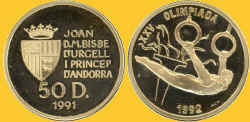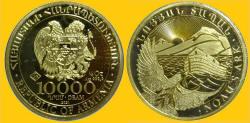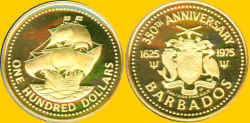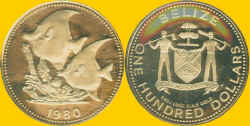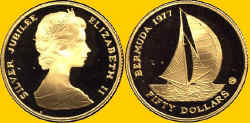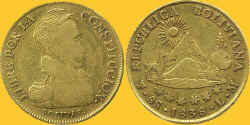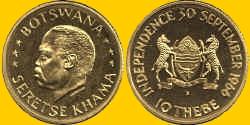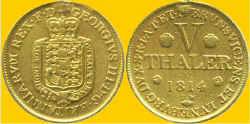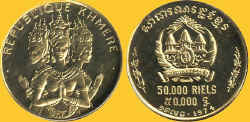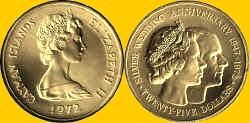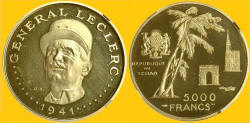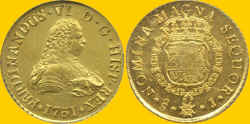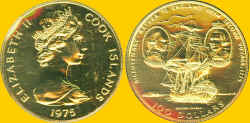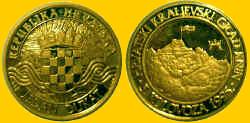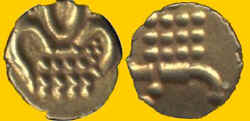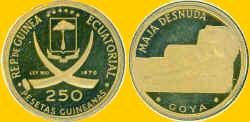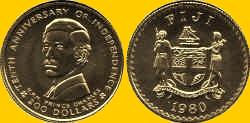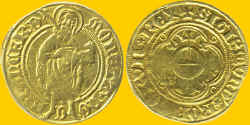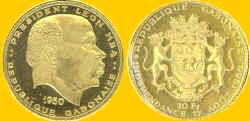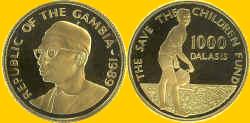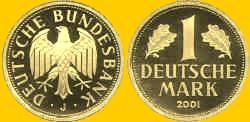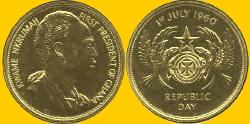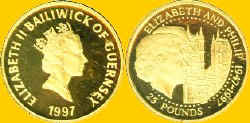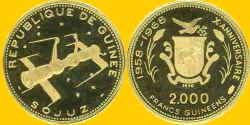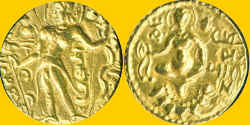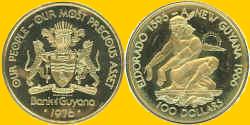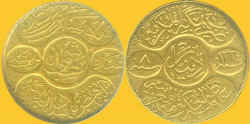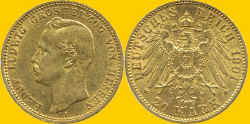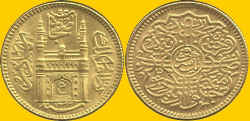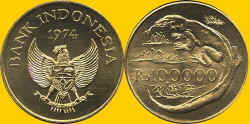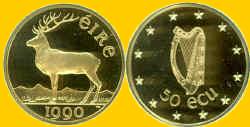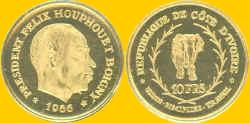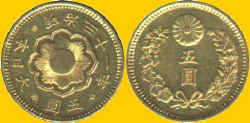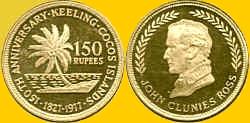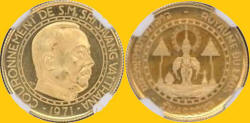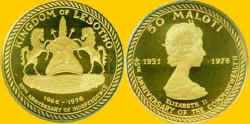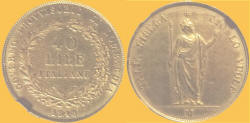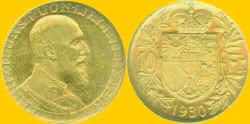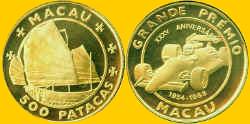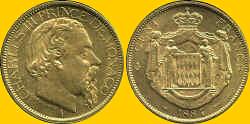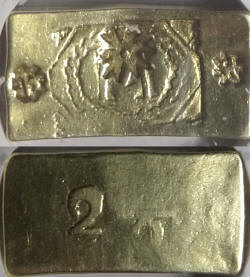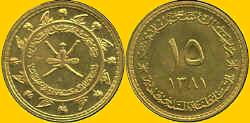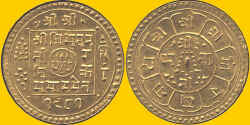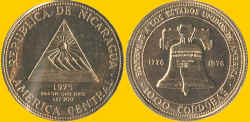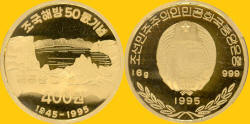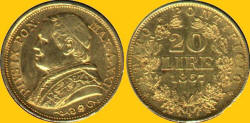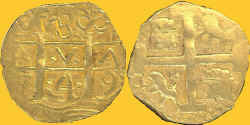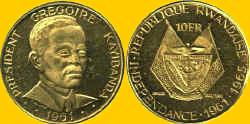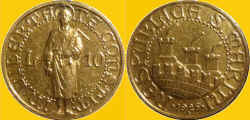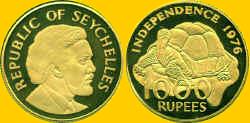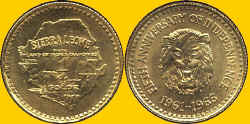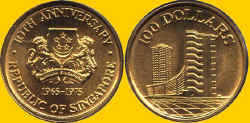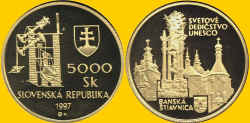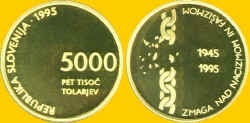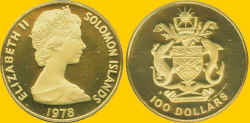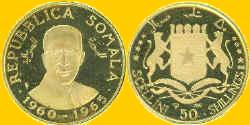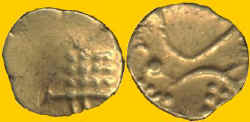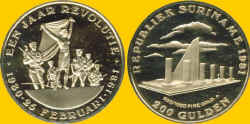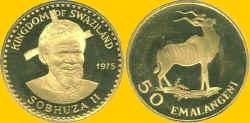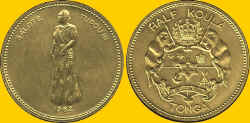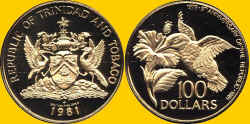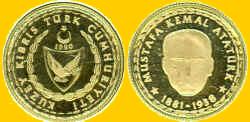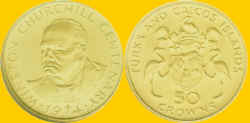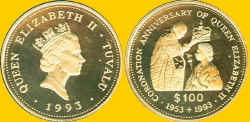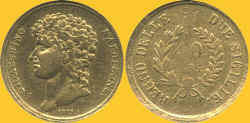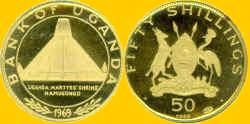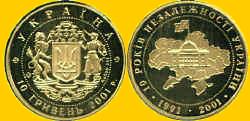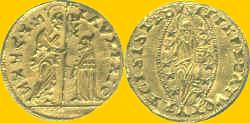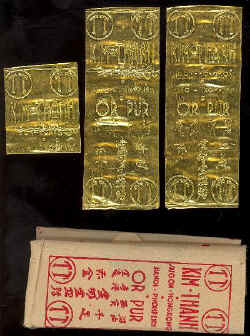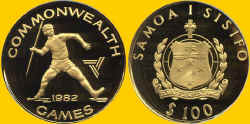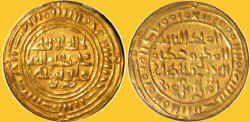This is the Worldwide Numismatics Website!
This is a modest collection of second millennium gold coins
Click the thumbnail picture to see a larger version of the picture, then use your browser BACK button to return to the original page you were viewing.
AFGHANISTAN
Afghanistan (meaning Land of the Afghan) is a mountainous land-locked country in Central Asia with a history and culture that goes back over 5000 years. Throughout its long, splendid, and sometimes chaotic history, this area of the world has been known by various names. In the ancient times, the land was called Aryana by its inhabitants. In the medieval era, it was called Khorasan. Afghanistan became under British influence in the 19th century. After 1919, it was totally independent as a kingdom. It became a republic in 1973. In 1979, a communist government was instituted that remained in power until 1992. Afghanistan has been ruled as an Islamic State since 1994 and was under the control of the Taliban until early 2002 when the coalition forces removed the Taliban in the pursuit of al-Queda terrorists.
Coinage was issued in what is now Afghanistan back to the earliest times. In fact Alexander III had mints operating in the area as he pushed towards India. Many ancient coins were issued by Baktria which was partly in present-day Afghanistan and are readily available. Coinage was issued through medieval times by local authorities and Moslem invaders. Modern coinage was instituted in 1896.
2 Tilla - 1298SH (1919 AD)
KM-879
- 9,2 g - 24 mm
The obverse has a medallic-like depiction of the throne room within a wreath, and the denomination 2 above the scene. The reverse has the ruler's legend (Amanullah) and date (1298 AH) in a wreath.
There are more Afghan gold coins in this section if you are interested - Page Afghanistan
ALBANIA
Albania is known as the Land of the Eagles. The south-central European area currently known as Albania was originally inhabited by the Illyrians. Illyrian culture is believed to have evolved from the Stone Age and to have manifested itself in the territory of Albania toward the beginning of the Bronze Age, about 2000 BC. Through recorded history, Albania came under the influence of Romans, Greeks, and finally the Ottoman Empire. Albania declared its independence on 28 November 1912. Ahmed Bey Zogu, a chieftain from the Mat region of north-central Albania, became president in 1925 and was declared King Zog I. Italy invaded Albania in 1939 and occupied it for much of World War II. Communists seized control of the country on 29 November 1944. Enver Hoxha, a college instructor who had led the resistance struggle of communist forces, became the leader of Albania by virtue of his post as secretary-general of the party. Hoxha was a ruthless dictator who allied himself with the PRC and ruled Albania like a personal medieval fiefdom. He died in April 1985. The communist regime was overthrown on 20 February 1991. Albania is now regaining its stature as an independent State with close ties to the West.
Coinage from what is now Albania started with the Illyrians as early as 400 B.C. Albanian national coinage did not start until 1926.
20 Franga - 1927-V
KM-012 - 6,45 g - 21 mm
Mintage
- 5.053
The obverse depicts a bust Albania's national hero Skanderbeg (Gjergj Kastrioti, 1405-1468) who fought off the Turks, facing right with the legend giving his name. Below the bust is the name of the designer G. ROMAGNON. The reverse has a winged lion with the country's name in Italian and Albanian with the denomination flanking the lion. The date 1927 is below the lion and the mintmark V for the Venice (Italy) mint is to the left of the date.
There are more Albanian gold coins in this section if you are interested - Page Albania
ANDORRA
Andorra is the sixth-smallest nation in Europe, having an area of 468 km2 (181 sq mi) and a population of approximately 85,000. Its capital Andorra la Vella is the highest capital city in Europe, at an elevation of 1,023 metres (3,356 ft) above sea level. The official language is Catalan, although Spanish, Portuguese, and French are also commonly spoken.
50 Dinar - 1991
KM-070 - 13,34 g - 27 mm
Mintage - 3.000
Edge - Reeded
This NCLT "coin" was issuerd to commemorate the 1992 Olympic Games. The obverse has the arms and the co-ruler's name "JOAN D.M.BISBE D'URGELL I PRINCEP D'ANDORRA in Catalan withgthe denomination 50 D. and date 1991 below.The reverse portrays a gymnist on the rings with the Olympic torch in the background and the legend OLYMPIADA 1992 at the top and bottom respectively.
ARGENTINA
Argentina's original inhabitants were known as the Diaguita and the Guarani. They were both agrarian cultures both developing the cultivation of maize. The first Spaniard to land in Argentina, Juan de Solis, was killed in 1516. Buenos Aires was founded in 1580 and became the capital of the new Viceroyalty of the Río de la Plata in 1776. After Napoleon invaded Spain, the Argentines set up an autonomous government on 25 May 1810. By 1816, relations between Argentina and Spain became strained and a party of separatists decided to declare the country's independence. One of the new patriots, Jose de San Martin, crossed the Andes and captured Lima. Along with Simon Bolivar, Martin is credited with breaking the shackle of Spanish rule in South America. In 1824 a constitutional assembly passed a constitution. Conservative political forces for the rest of the 19th century dominated Argentina. During this period the country grew rapidly. In 1916 Radical forces took control of the government. They were ousted in 1935. In 1946 Juan Domingo Peron took control of the government. Peron was ousted in 1955 by the military. The military maintained power until 1973, when violence forced the military to allow the return of Peron. He died the next year and his third wife Isabella Peron took over. She was able to maintain power for only two years. The military regained power and held it until the conclusion of the unsuccessful occupation of the Falkland Islands (Islas Malvinas) in 1985. Civilian government was restored and stability continues through today.
There were no Spanish
colonial mints located in current-day Argentine territory (coinage produced at
the Potosi mint circulated) Argentine coinage commenced in 1813 when the
region was called Las Provincias del Rio de la Plata. Provincial coinage was
issued by Buenos Aires, Cordoba, Entre Rios, La Rioja, Mendoza, Salta,
Santiago del Estero, and Tucuman from the 1820s into the 1860s. Minor coinage
in the name of the Argentine Confederation were issued in 1854.
Republican coinage started in 1881.
1 Argentino - 5 Pesos - 1885
KM-006 - 8,06 g - 23 mm
Mintage - 0,204M
Edge
- **IGUALIDAD*ANTE*LA*LEY**
The obverse features a stylized head of LIBERTAD (Liberty) facing right. The inscription gives the denomination (5 PESOS and UN ARGENTINO, and the Fineness (9 Dos FINO) as well as the LIBERTAD legend. The designer's name OUDINE is to the lower right of the bust. The reverse has the national arms of the Republic, the country's name REPUBLICA ARGENTINA, and the date 1885.
There are more Argentine gold coins in this section if you are interested - Page Argentina
ARMENIA
One of the world's oldest civilizations, Armenia once included Mount Ararat,
which biblical tradition identifies as the mountain that Noah's ark rested
on after the flood. It was the first country in the world to officially
embrace Christianity as its religion (c. A.D. 300).
In the 6th century B.C., Armenians settled in the kingdom of Urartu (the
Assyrian name for Ararat), which was in decline. Under Tigrane the Great
(95-55 B.C.) the Armenian empire reached its height and became one of the
most powerful in Asia, stretching from the Caspian to the Mediterranean
seas. Throughout most of its long history, however, Armenia has been invaded
by a succession of empires. Under constant threat of domination by foreign
forces, Armenians became both cosmopolitan as well as fierce protectors of
their culture and tradition.
Over the centuries Armenia was conquered by Greeks, Romans, Persians,
Byzantines, Mongols, Arabs, Ottoman Turks, and Russians. From the 16th
century through World War I, major portions of Armenia were controlled by
their most brutal invader, the Ottoman Turks, under whom the Armenians
experienced discrimination, religious persecution, heavy taxation, and armed
attacks. In response to Armenian nationalist stirrings, the Turks massacred
thousands of Armenians in 1894 and 1896. The most horrific massacre took
place in April 1915 during World War I, when the Turks ordered the
deportation of the Armenian population to the deserts of Syria and
Mesopotamia. According to the majority of historians, between 600,000 and
1.5 million Armenians were murdered or died of starvation. The Armenian
massacre is considered the first genocide of the 20th century. Turkey denies
that a genocide took place and claims that a much smaller number died in a
civil war.
10.000 Dram - 2021
KM- - 7,78 g - 20 mm
Edge - Reeded
The obverse has the arms of Armenia. The reverse depicts Noah's Ark after the Great Flood. This NCLT was issued by the Bank of Armenia and was struck by Geiger Edelmetalle GmbH, Germany
AUSTRALIA
Australia's original inhabitants, known as Australian Aborigines, have the longest continuous cultural history in the world, with origins dating back to the last Ice Age. Although mystery and debate shroud many aspects of Australian prehistory, it is generally accepted that the first ancestors of Australian Aborigines arrived there about 50.000 years ago. Europeans began to explore Australia in the 16th century. Portuguese navigators were followed by Dutch explorers and the enterprising English pirate William Dampier. Captain James Cook sailed the entire length of the eastern coast in 1770, stopping at Botany Bay on the way. After rounding Cape York, he claimed the continent for the British and named it New South Wales. In 1779, Joseph Banks (a naturalist on Cook's voyage) suggested that Britain could solve overcrowding problems in its prisons by transporting convicts to Australia. In 1787, a fleet set sail for Botany Bay under the command of Captain Arthur Philip, who was to become the colony's first governor. The fleet comprised 11 ships, 750 male and female convicts, four companies of marines and supplies for two years. Capt. Philip arrived in Botany Bay on 26 January 1788, but soon moved north to Sydney Cove, where there was better land and water. Free settlers began to be attracted to Australia over the next decades, but it was the discovery of gold in the 1850s that changed the face of the colony. Australia became a nation when federation of the separate colonies took place on 1 January 1901 and it bacame known as the Commonwealth of Australia. The nation remains a member of the British Commonwealth although there are increasing calls for severing relations with the Crown.
The earliest coinage issued under the name Australia were gold sovereigns and half sovereigns even though the region was made up of several individual colonies. The the early 1800s, New South Wales cut and punched Spanish silver real coinage for use in the colony. South Australia actually issued a limited gold coinage in 1852 from the Adelaide Assay Office and from Port Philip which are very rare today. The first coinage issued by the Commonwealth was in 1910.
1 Sovereign - 1870
KM-004 - 7,99 g - 22 mm
Edge - Reeded
The obverse has the young head of Queen
Victoria (b1819-d1901) with a sprig of banksia and the Latin inscription
VICTORIA D:G: BRITTANIAR: REG:D:F: (Victoria by grace of God, British Queen,
Defender of the Faith). The date 1870 is below the bust. The bust was
designed by Leonard Charles Wyon. The reverse has a crown and the country's
name with St. Edward's crown above circled by a wreath. At the top is a legend
identifying the Sydney Mint and below is the denomination One Sovereign. This
is the Type II version. Australian gold coins are more yellow as they were
alloyed with silver whereas the London issues were redder and were alloyed
with copper, making the Australian gold coins of higher intrinsic worth. In
1870, the decision was made to scrap the unique Australian design in favour of
the standard British design. The Sydney
Mint was opened as a branch of the London Royal Mint in 1855.
There are more Australian gold coins in this section if you are interested - Page Australia
AUSTRIA
The Danube Valley provided a conduit for various tribes that settled in present-day Austria -Celts, Romans, Vandals, Visigoths, Huns, Avars, and Slavs. Charlemagne established a territory in the Danube Valley known as the Ostmark in 803, and the area became Christianised and predominantly Germanic. By 1278 the Habsburgs had gained control and this mighty dynasty managed to rule Austria right up through the end of World War I. The last emperor, Franz Josef, ruled from 1848 to 1916. His nephew, Prince Ferdinand, was assassinated in Sarajevo on 14 June 1914. A month later, Austria-Hungary declared war on Serbia, the Russians came to the Serbians' aid and World War I was underway. After the war, Austria became a republic until, in 1937, it voted to become part of Germany. After World War II, it was occupied by the Four Powers who relinquished control in 1955 and the republic was reestablished.
Coinage from Austrian
territory dates back to Roman times. Many dukes, bishops, counts, and princes
issued coinage for their respective localities from medieval times into the
1700s. Austrian national coinage truly begins with the Holy Roman Emperors
(Habsburgs) starting around 1437 A.D.
100
Corona - 1915 (Restrike)
KM-2819
- 33,88 g - 35 mm
The obverse includes the bust of an aging Franz Josef I (b1830-d1916) and the Latin inscription FRANC-IOS-I-D-G-IMP-AVSTR-REX-BOH-GAL-ILL-ETC-ET AP- REX HVNG meaning FRANZ JOSEF I - BY GRACE OF GOD EMPEROR OF AUSTRIA - KING OF BOHEMIA, GALICIA, ILLYRIUM, ETC AND KING OF HUNGARY. Below the bust is the name of the designer S. T. SCHWARTZ. The reverse has the Royal Arms of the Austro-Hungarian Empire. At the top is Latin inscription for 100 Crowns and the date in Roman numerals (MDCCCCXV). At the bottom is the denomination and date.
BADEN
Baden is a state in southwestern Germany that was a kingdom until the last king, Friedrich II abdicated in 1918 after Germany was defeated in World War I. It is now part of the Federal Republic of Germany.
Coinage was issued starting in the 12th Century through the early 20th Century.
20
Mark - 1873-G
KM-261 - 7,97 g - 23 mm
Mintage
- 0,517M
The obverse includes the bust of Grand Duke Frederick I (b1826-d1907) and the German inscription FRIEDRICH GROSHERZOG VON BADEN (Frederick Grand Duke of Baden). Below the bust is the mintmark G (for the Karlsruhe mint). The reverse has the Royal Arms of the German Empire encircled by the German legend for GERMAN EMPIRE. At the bottom is the denomination 20 M and the date 1873. This reverse is Type I which has a larger depiction of the arms.
There are more Baden gold coins in this section if you are interested - Page Baden
BAHAMA ISLANDS
Christopher Columbus' first voyage in 1492 made first landfall in the Western Hemisphere in The Bahama Islands. The original; indigenous people were the Lucayan Indians to work in gold mines in Hispaniola, and within 25 years, all Lucayans perished. Various groups of European settlers formed governments in The Bahamas until the islands became a British Crown Colony in 1717. The Bahamians attained self-government in 1964 and full independence within the Commonwealth on 10 July 1973.
The first coinage for the
Bahamas were copper penny pieces issued in 1806. British currency was used
from 1825 until 1966 when the Bahamian authorities issued coinage.
20
Dollars - 1971
KM-027 - 7,99 g - 22 mm
Edge - Reeded
Mintage
- 6.200
This is an example of NCLT (Non Circulating Legal Tender). The obverse has the bust of Queen Elizabeth II (b1926-) and the inscription COMMONWEALTH OF THE BAHAMA ISLANDS - ELIZABETH II. The reverse has a lighthouse with the denomination TWENTY DOLLARS around the top and the date 1971 at the bottom.
There are more Bahamian gold coins in this section if you are interested - Page Bahamas
BAHRAIN
Bahrain is a emirate located on an island group at the west of the Arabian Gulf. The original civilization was the trading empire of Dilmun, founded during the Bronze Age around 3000 BC and lasting in one form or another for over 2000 years. It was later a vassal state of Assyria and, still later, of Babylonia. The inhabitants adopted Islam in the seventh century AD. Many forces held Bahrain but the Persians held it until the current ruling family, Al-Khalifa, expelled the Persians in 1780s. Oil was discovered in 1932 under the British protectorate which lasted until 1971 when Bahrain gained independence.
Bahrain's coins are minted at the British Royal Mint.
(10
Dinar) - 1971
KM-M002 - 16,00 g - 28,6 mm
Edge - Reeded
Mintage
- 3.000
This is an example of NCLT (Non Circulating Legal Tender). It was issued to celebrate Bahrain's independence which was attained on 14 August 1971. The obverse has the bust of Sheikh Isa bin Salman Al Khalifa (b1933-d1999), Bahrain's ruler. The reverse has the national insignia with the Arabic legend at the top and the English legend at the bottom describing the commemoration of independence.
BARBADOS
Portuguese explorer Pedro a Campos discovered Barbados in 1536. British Naval Captain John Powell landed on Barbados in 1625 and claimed the uninhabited island for England. Two years later, his brother Captain Henry Powell landed with a party of 80 settlers and 10 slaves. The group established the island's first European settlement, Jamestown. In 1639, island freeholders formed a Legislative Assembly, only the second such parliament established in a British colony (Bermuda was the first). Barbados was loyal to the Crown during Britain's civil wars and, following the beheading of King Charles I in 1649, Oliver Cromwell dispatched a force to establish his authority over Barbados. The invading fleet arrived in 1651 and by the following year Barbados had surrendered and signed the Articles of Capitulation, which formed the basis for the Charter of Barbados. The charter guaranteed government by a governor and a freely elected assembly, as well as freedom from taxation without local consent. When the British Crown was restored in 1660, this charter ironically provided Barbados with a greater measure of independence from the English monarchy than that of other British colonies. Barbados gained internal self-government in 1961 and became an independent nation five years later. As the sugar industry declined after WWII, tourism steadily increased its share of the island's economy. By the early 1990s it was the largest sector, and the sugar industry was in receivership.
$100 - 1975
KM-018 - 6,21 g - 30 mm
Edge - Reeded
Mintage
- 0,023M
This NCLT coin was issued to commemorate the 350th anniversary of the claiming of Barbados for the English Crown. The obverse shows the ship Olive Branch with the denomination ONE HUNDRED DOLLARS. The reverse has the national arms flanked by the dates 1625 - 1975. The legend at the top is the event and the country's name is at the bottom.
BAVARIA
Bavaria in southern Germany was inhabited by Celts when the Roman emperor Drusus conquered it in 15 B.C.. The Baiuoarii tribe invaded it in the 6th century A.D. and set up the duchy to which they gave their name. It was one of the five basic or stem duchies of medieval Germany. Irish and Scottish monks began the Christianisation of the area, and it was completed in the 8th century by St. Boniface. The Wittelsbach family were given the Duchy of Bavaria in 1180 and they ruled until 1918. The title of King was granted in 1805. Germany united as a confederation under Prussia in 1871 but the States still had nominal autonomy and were ruled by kings or princes until the 1920s. After World War I, King Ludwig III was overthrown in 1918 by the socialists under Kurt Eisner. Eisner was assassinated in 1919 and a communist government was instituted for a short time. German forces intervened and Bavaria joined the Weimar Republic.
Coinage from what is now Bavaria probably began in Frankish times. Bavaria gold coinage began in the early 14th century A.D. and continued through 1913.
20 Mark - 1873-D
KM-501 - 7,965 g - 22 mm
Edge - Reeded
Mintage
- 2,771M
The obverse includes the bust of King Ludwig II (b1845-d1886) and the German inscription meaning LUDWIG II KING OF BAVARIA. Below the bust is the mint mark D for Munich. The reverse has the Royal Arms of the German Empire encircled by the German legend for GERMAN EMPIRE. At the bottom is the denomination 20 M and the date 1873. This reverse is Type I with large arms.
BELGIUM
Beginning in 57 BC, Julius
Caesar invaded the region of Europe that is now Belgium which was then
populated by the Belgae, a Celtic tribe who Caesar described as the most
courageous tribe. The Romans
named their new province Gallia Belgica. In the fourth century AD, with Rome
in decline, control of Gaul was ceded to the Franks, a Germanic tribe.
The Merovingians came into power in the 5th century A.D. Their king
Clovis I adopted Christianity in the 6th century.
The kingdom withered after Clovis' death and they were succeeded by the
Carolingian dynasty under Pepin. Control
of the region alternated between various French and German princes until it
became part of the Spanish Netherlands in the 16th century. Spain ceded the
territory to France who, after war, turned it over to the Austrian Habsburgs.
In 1790, independence was declared but the Habsburgs reestablished control
until it was retaken by the French in 1795.
After Napoleon's fall, Belgium became part of The Netherlands until the
citizens revolted in 1830 establishing a Belgian constitutional monarchy.
In January 1989, Belgium became a federal kingdom.
Belgian provincial coins for Brabant and Flanders were issued under Spanish and Austrian governance were issued at mints in Antwerp, Brussels, Bruges, and Tournai. When it was part of the United Provinces and The Netherlands, coins were issued at the Brussels mint (B mint mark). The first Belgian national coins were issued in 1832.
20
Francs - 1865
KM-023
- 6,45 g - 20,5 mm
Edge- Reeded
Mintage - 1.548M
The obverse has a bust of King Leopold I
(b1790-d1865) with the French inscription LEOPOLD FIRST KING OF THE BELGIANS.
Below the bust is the name L, WEINER, the coin's designer.
The reverse features the denomination 20 FRANCS and date 1865 with in a
wreath.
There are more
Belgian gold coins in this section if you are interested - Page
Belgium
BELIZE
Belize was heavily populated by the Maya Indians, whose relatively advanced civilization reached its height between A.D. 250 and 900. The first reference to European settlement in the colony was in 1638. These were later augmented by disbanded British soldiers and sailors after the capture of Jamaica from Spain in 1655. The settlement, whose main activity was logwood cutting (logwood was used in the past to produce dye), had a troubled history during the next 150 years. It was subjected to numerous attacks from neighbouring Spanish settlements (Spain claimed sovereignty over the entire New World except for regions in South America assigned to Portugal). It was not until 1763 that Spain in the Treaty of Paris allowed the British settlers to engage in the logwood industry. The Treaty of Versailles in 1783 reaffirmed those boundaries and logwood concession was extended by the Convention of London in 1786. But Spanish attacks continued until a decisive victory was won by settlers, with British naval support, in the Battle of St. George's Caye in 1798. After that, British control over the settlement gradually increased and in 1871 British Honduras was formally declared a British Colony. Further constitutional advances came in 1954 with the introduction of Universal Adult Suffrage and an elected majority in the Legislature, the Ministerial System was adopted in 1961 leading up to Self Government in 1964. The country's name was changed on 1st June, 1973, from British Honduras to Belize. Independence was achieved on September 21, 1981.
100 Dollars - 1980
KM-062
- 6,21 g - 26 mm
Mintage - 3.993
The obverse of this NCLT "coin" depicts the Moorish Idol Reef fish with the date 1980 below. The reverse has the country's heraldic arms with the country name BELIZE above and the denomination ONE HUNDRED DOLLARS around the bottom and sides.
BERMUDA
Bermuda was originally discovered in 1503 by Juan de Bermudez. The first visitors were shipwrecked Britons under Sir George Somers who were bound for Virginia. The colony was established in 1612 by a group from Virginia. Today it is a parliamentary British colony.
The earliest coinage were "Hogge Money" that depicted a hog (which were introduced by the Spanish). In the 1790s, copper token coinage was struck in Birmingham. In 1842, the British £sd was declared the sole legal tender until Bermuda adopted the dollar in 1970. Current coinage is minted at private mints in Switzerland and the U.S.A.
50
Dollars - 1977
KM-026
- 4,05 g - 19,4 mm
Mintage - 4.070
The obverse of this NCLT "coin" to honor the 35th anniversary of her reign has a bust of Queen Elizabeth II (b1926-) with the legend SILVER JUBILEE ELIZABETH II. The reverse has a sailing vessel with the issuer's name BERMUDA abnd the date 1977 to the left. The denomination FIFTY DOLLARS is below the sloop. The hallmark is to the right.
BHUTAN
Although its early history is vague, Bhutan seems to have existed as a political entity for many centuries. At the beginning of the 16th cent. it was ruled by a dual monarchy consisting of a Dharma Raja, or spiritual ruler, and a Deb Raja, or temporal ruler. For much of its early history the Deb Raja held little real power, as the provincial governors (ponlops) became quite strong. In 1720 the Chinese invaded Tibet and established suzerainty over Bhutan. Friction between Bhutan and Indian Bengal culminated in a Bhutanese invasion of Cooch Behar in 1772, followed by a British incursion into Bhutan, but the Tibetan lama's intercession with the governor-general of British India improved relations. In 1774 a British mission arrived in Bhutan to promote trade with India. British occupation of Assam in 1826, however, led to renewed border raids from Bhutan. In 1864 the British occupied part of southern Bhutan which was formally annexed after a war in 1865; the Treaty of Sinchula provided for an annual subsidy to Bhutan as compensation. In 1907 the most powerful of Bhutan's provincial governors, Sir Ugyen Wangchuk, supported by the British, became the monarch of Bhutan, the first of a hereditary line. A treaty signed in 1910 doubled the annual British subsidy to Bhutan in return for an agreement to let Britain direct the country's foreign affairs. After India won independence, a treaty (1949) returned the part of Bhutan annexed by the British and allowed India to assume the former British role of subsidizing Bhutan and directing its defense and foreign relations; the Indians, like the British before them, promised not to interfere in Bhutan's internal affairs. When Chinese Communist forces occupied Tibet in 1950, Bhutan, because of its strategic location, became a point of contest between China and India. The Chinese claim to Bhutan (as part of a greater Tibet) and the persecution of Tibetan Buddhists led India to close the Bhutanese-Tibetan border and to build roads in Bhutan capable of carrying Indian military vehicles. In the 1960s, Bhutan also formed a small army, trained and equipped by India. The kingdom's admission to the United Nations in 1971 was seen as strengthening its sovereignty.
1
Sertum - 1970
KM-036
- 7,98 g
Mintage 3.111
This NCLT coin's obverse has a bust of a young girl. BHUTAN SERTUM is around the top with the date 1970 below. The reverse has a seal with Bhutanese legends.
BOLIVIA
Parts of Bolivia, a
land-locked mountainous area in central South America, were under the Incan
Empire until the Spanish arrived in the early 16th century A.D.
They named the area Alto Peru, as a dependency of the Viceroyalty of
Peru. In 1776 it was transferred to the newly formed Viceroyalty of La Plata.
In 1544, they discovered the vast silver deposits and founded Potosi as
a mining and minting centre of New Spain. Independence was declared in
1825 by an assembly which met in Chuqisaca (now Sucre). General Antonio Jose
de Sucre, who commanded Colombian troops, played a leading role in the defeat
of the Spanish garrison, and was elected as the first president. The following
year a constitution was drawn up by Simon Bolivar and adopted. It was then
that the country adopted the name of Bolivia.
Several wars were fought with neighboring countries, Peru and Chile.
The country had a tumultuous history throughout most of its existence.
In 1952 a revolutionary party (Movimiento Nacionalista Revolucionario - MNR)
seized control of the government. This led to the expropriation of the mines
by the state and to agrarian reform, by which the large estates were divided
among former tenants and peasants. Before it was deposed by the army in 1964,
the MNR introduced far-reaching economic and social changes. Over the next 25
years (1964-1989) Bolivia has 19 presidents (13 were generals), with only two
completing a full term in office.
The first coins were minted by the Spaniards at the Potosi mint during the Reign of Philip II (1556-1598). This mintmark is a monogram for the letters PTS and the coinage was very extensive. Spanish colonial coins were minted through 1825. Republican coinage was issued starting in 1827.
8 Escudo - 1838-SLP
KM-99
- 27,0 g
Edge - Reeded
This coin 's obverse features a bust of
Simon Bolivar (b1783-d1830) surrounded by the Spanish legend LIBRE POR LA
CONSTITUTION (Free by the Constitution) and BOLIVAR at the bottom. The
reverse has a Bolivian scene of the sun, a llama, mountains, a sheaf of wheat,
and a sprig. The Spanish legend REPUBLICA BOLIVIANA is around the top.
The mintmark (a monogram of SLP), the denomination 8 S, the date 1839, and the
assayers' mark L.M (for Luis de Aguilar and Diego Miguel Lopez).
There are more Bolivian gold coins in this section if you are interested - Page Bolivia
BOTSWANA
Botswana is a southern African republic that was formerly known as Bechuanaland, a British colony, until independence in 1966.
Gold coinage is struck at the Swiss Federal Mint in Berne.
10
Thebe - 1966
KM-002
- 11,290 g
Mintage - 5.100
This coin commemorates the attainment of independence. The obverse features a bust of President Seretse Khama (b1921-d1980) the first chief of State. The reverse has the national arms with the mintmark B (for the Berne, Switzerland mint). The lened INDEPENDENCE 30 SEPTEMBER 1966 is around the top half of the arms. At the bottom is the denomination 10 THEBE.
BRAZIL
Brazil
was discovered by the Portuguese led by
Admiral Pedro Alvares Cabral, who began the colonial period in 1500.
The first settlement was established in 1532. The Dutch established
settlements in the early 17th century A.D.
They founded the WIC
(West Indische Compagnie) in 1621 and were
successful in establishing a foothold in Brazil and called it Nieuw Holland.
The Portuguese resisted these attempts at Dutch colonization and finally
expelled them in from their last stronghold Recife in 1654. In
1807, as Napoleon Bonaparte closed in on Portugal's capital city of Lisbon,
the Prince Regent Dom João transferred his seat of government to Rio de
Janeiro. In 1821 Dom João returned to Lisbon, and he left his son
Dom Pedro I in charge of Brazil. When Dom João attempted the following year
to return Brazil to subordinate status as a colony, his son Dom Pedro I
declared the country's independence from Portugal and set himself up as
emperor. In 1889, the military
revolted, Dom Pedro II abdicated and fled Brazil, and a republic was
established.
Brazilian coinage began with the counterstamping of Portuguese coins in the early 17th century A.D. Coins were struck at Brazilian mints starting in the late 1600s. The Dutch issued gold coinage at Pernambuco in 1645-6 and these pieces are very rare.
20.000
Reis - 1851
KM-461
- 17,93 g
Mintage - 0,303M
The obverse features a bust of Emperor Dom
Pedro II (b1825-d1891) with the Latin inscription for PETRVS II. D.G.G.IMP. ET
PREP. BRAS.DEF (PETER II BY GRACE OF GOD CONSTITUTIONAL EMPEROR AND PERPETUAL
DEFENDER OF BRAZIL) around the bust and the date 1851 below the bust. Dom
Pedro was banished in 1889 after the fall of the Empire and he spent his
remaining days living in France. The reverse has the royal coat of arms
with the Latin motto above meaning IN HOC S. VINCES (IN THIS SIGN YOU WILL
CONQUER) at the top. Peter was the last emperor of Brazil as Brazil declared
itself a republic in 1889.
There are more Brazilian gold coins in this section if you are interested - Page Brazil
BRITISH VIRGIN ISLANDS
Arawak Indians settled the British Virgin Islands around 100 BC, migrating from the Orinoco Basin in South America. A peaceloving tribe, they were hounded out by the more aggressive Caribs, who arrived from South America in the mid-15th century. It was only a few decades later that Columbus named the islands Las Vírgenes in a somewhat obscure reference to St Ursula and her 11,000 virgins. The Spanish settled only to mine copper on Virgin Gorda in the early 17th century. The Europeans were harassed by Caribs and by pirates who attacked galleons carrying riches back to Spain. An assortment of colorful characters sailed through the surrounding waters, including pirates Henry Morgan, Sir John Hawkins and Blackbeard, and English sea dog Sir Francis Drake. As Spain declined as a colonial power, ownership of the islands shifted about until the Dutch established a permanent settlement on Tortola in 1648. The English ousted the Dutch from Tortola in 1672, and from Anegada and Virgin Gorda in 1680. In 1917, the United States purchased the adjacent Danish West Indies (US Virgin Islands) as a strategic outpost in the Caribbean. Meanwhile, farming spurred economic growth and plodding social reform on the British Virgin Islands, prompting moves toward self government. In 1967, islanders were finally given the right to administer their own affairs.
100
Dollars - 197
KM-008
- 7,10 g
Edge - Reeded
Mintage - 0,023M
This NCLT "coin" was issued to commemorate the Queen's 50th birthday. The obverse has the Machin bust of the Queen (b1926) with her royal title ELIZABETH THE SECOND to the left and the country's name BRITISH VIRGIN ISLANDS to the right. The date 1975 is at the bottom. The reverse has a tern in flight with the denomination 100 DOLLARS around the bottom.. The Franklin Mint mintmark and the fineness 900/1000 FINE GOLD is under the bird.
BRAUNSCHWEIG-LÜNEBERG
The Duchy of Brunswick-Lüneburg (German: Herzogtum Braunschweig-Lüneburg),
or more properly Duchy of Brunswick and Lüneburg, was an historical ducal
state from the late Middle Ages until the late Early Modern era within the
North-Western domains of the Holy Roman Empire of the German Nation, in what
is now northern Germany.
The dukedom emerged in 1235 from the allodial lands of the House of Welf in
Saxony and was granted as an imperial fief to Otto the Child, a grandson of
Henry the Lion. Its name came from the two largest towns in the territory:
Brunswick and Lüneburg. The duchy was divided several times during the High
Middle Ages amongst various lines of the House of Welf, but the rulers all
continued to be styled as the "Duke of Brunswick-Lüneburg" in addition to
their various particular titles. The individual principalities making up the
duchy continued to exist until the end of the Holy Roman Empire in 1806.
Following the Congress of Vienna in 1814/15, the territories became part of
the Kingdom of Hanover and Duchy of Brunswick.
5 Thaler - 1814
KM-101
- 6,65 g
Edge - Engrailed
Mintage - Unknown
The obverse of this coin features the British royal arms with the duchy's arms superimposed on the centre within the Order of the Garter. The Latin legend GEORGIVS III -D-G-BRITTANIARVM REX-F-D (George III By Grace of God King of the Britons Defender of the Faith) circles the arms. The reverse has the denomination V THALER, the date 1814, and the mintmaster's initials T.W. in the centre with the regent's title in Latin BRVNSVICENS ET LVNEBVRG DUX-S-R-I-A-T-ET-E around the periphery. In 1837 it was renamed the Kingdom of Hannover after the capital city.
EMIRATE OF BUKHARA
Part of ancient Sogdiana, it was ruled (A.D. 709–874) by the Umayyad Arabs and played an important role under the Samanid dynasties (875–1000). It was a trade, transport, and cultural center of the Islamic world. The Seljuk Turks ruled from 1004 to 1133; later, the realm was conquered by Genghiz Khan (1220) and in the 14th cent. by Timur. The Timurid dynasties ruled until the invasion of Uzbek tribes early in the 16th century. The Bukhara emirate was founded by the Uzbek Khan Sheybani, who between 1500 and 1507 conquered the Timurid domains in Transoxania. In 1555, Abdullah Khan transferred the capital from Samarkand to Bukhara, from which the state then took its name. Internal feuds weakened Bukhara, it split into a number of principalities, and in 1740 it was conquered by Nadir Shah of Persia. In 1753, Bukhara again became an independent emirate but did not recover its supremacy over Khwarazm, Merv, Badakhshan, Tashkent, and the Fergana Valley. Bukhara's population consisted principally of Uzbeks (who remained politically dominant), Sarts, and Tajiks. Defeated by Russia in 1866, the emirate became a Russian protectorate in 1868. In 1920, after a prolonged battle with Bolshevik forces, the last emir was driven into Afghanistan. The Bukhara People's Soviet Republic was established (1920) and lasted until 1924. In the same year it was proclaimed a socialist republic and was incorporated in the USSR; a few months later, however, it was dismembered and divided between Uzbekistan, Tajikistan, and Turkmenistan. After the breakup of the Soviet Union, the area became part of Tajikistan.
1 Tilla - 1298 AH
KM-065
- 5,00 g -22,4 mm
Edge - Smooth
This coin has Arabic inscriptions on both sides. The date 1298 is on the reverse. This coin was minted under the authority of Emir Nasrullah.
BULGARIA
Bulgaria
was part of the Kingdom of Macedonian ancient times. By 46 BC, the Romans had
conquered the whole peninsula, which they inhabited the region until invasions
by Thraco-Illyrian tribes left the area a devastated wasteland. Peaceful
Slavic farmers grazed in during the 6th century. In 679, the Bulgars, a fierce
Turkic tribe, crossed the Danube to found the first Bulgarian state. The
Bulgars were eventually assimilated by the more numerous Slavs, and they
adopted their language and way of life.
Tsar Boris I accepted Orthodox Christianity in 865.
The Turks started making inroads and by the end of the 14th century,
they controlled all of Bulgaria, beginning five centuries of Ottoman rule.
In 1878, European powers intervened and Bulgaria was made a
principality under Ottoman suzerainty. Eastern Rumelia was joined
to the principality in 1885. An independent Bulgarian kingdom was
proclaimed on 22 September 1908. They fought both World Wars
allied with Germany. In 1944 it was liberated by the Soviets who
installed a communist puppet government under Todor Zhivkov. The communists
were overthrown in 1989 and a republic was constituted.
Coinage was struck in Bulgarian territory since Roman times at the Serdica mint. The first national Bulgarian coinage began during the reign of Tsar Ivan Asen II (1218–41). Bulgarian coinage resumed in 1881.
20
Leva - 1894-KB
KM-020 - 6,45 g -21 mm
Mintage - 0,100M
The obverse has a bareheaded bust of Tsar
Ferdinand (b1861-d1948) with the Bulgarian inscription FERDINAND I BULGARSKII
KNYAZ. Below the bust are the initials of the designer and the KB mint
mark for the Kormoczbanya mint in today's Slovakia.
There are more Bulgarian gold coins in this section if you are interested - Page Bulgaria
BURMA
(MYANMAR)
Myanmar, a
southeast Asian country bordering India and Thailand, dates back to the early
11th Century A.D. when King Anawratha unified the country and founded the
First "Myanmar" Empire in Bagan. The second Myanmar Empire was
founded in mid 16th Century by King Bayinnaung. King Alaungpaya founded the
last Myanmar Dynasty in 1752 and it was during the zenith of this Empire that
the British moved into Myanmar. Like India, Burma became a British colony only
after three Anglo-Myanmar wars in 1825, 1852 and 1885. Burma was part of India
until 1937 when it became an autonomous colony. During World War II Burma was
occupied by the Japanese from 1942 till 1945. Burma became a sovereign
independent State on 4 January 1948. In 1962, the military took over the
country. In 1974, the country became a socialist republic. The country's name
was officially changed to Myanmar in 1989, restoring the ancient name of the
region. A number of separatist units operated within Burma particularly in the
Shan State.
Burmese coinage was issued from 1852 to 1885. In 1889, Burmese coins ceased to circulate and were replaced by Indian coinage. Burmese national coinage resumed in 1948.
<Patriotic
Liberation Army>- 4 Mu - 1970
KM-045
- 8,00 g
The obverse features the Burmese dancing
peacock with the Burmese inscription UNION OF BURMA GOVERNMENT 1970-1971 with
the weight on each side. The reverse has an 8 pointed PLA star with small 5
pointed stars in each field. The inscription within the star is Burmese for U
NU who was a Burmese nationalist leader (b1907-d1995).
There are more Burmese gold coins in this section if you are interested - Page Burma
BURUNDI
Burundi is in east central Africa and functioned as a feudalistic kingdom for more than 300 years prior to European intervention in the 1890s. It became part of German East Africa until 1918 when the League of Nations mandated the area to Belgium and it was administered as Ruanda-Urundi as part of the Belgian Congo. Burundi was granted full independence in 1962 and was constituted as a kingdom. The military staged a coup in 1962 which abolished the monarchy and established a republic.
Coinage was initiated in 1954 for Ruanda-Urundi by the Belgian authorities. Burundi national coinage was issued starting in 1962
10
Francs - 1965
KM-007 - 3,00 g - 19,3 mm
Edge
- Reeded
This NCLT coin was issued to commemorate the 50th Anniversary of the reign of Mwami Mwambutsa IV (b1912-d1977). The obverse has a military bust of the mwami surrounded by the French legend MWAMABUTSA ROI DU BURUNDI at the top. The dates 1915-1965 are on the sides of the bust. Below the bust is the French legend 50A ANN. DU REGNE (50th Year of Reign). The mwami was overthrown in 1966 and a republic established. The reverse has the royal arms with the country's name ROYAUME DU BURUNDI at the top and the denomination 10 FRANCS at the bottom.
BYZANTIUM
In the year 667 B.C., the
legendary Byzas from the Greek city of Megara, after consulting the oracle of
Apollo at Delphi, founded the seaport of Byzantium at the entrance of the
Black Sea. In the second half of the fourth century B.C. King Philip II of
Macedon (382-336 B.C.)
and his son Alexander the Great (356- 323 B.C.)
dominated Byzantium as they built an empire reaching from Greece to India.
The
Byzantine Empire, founded when the capital of the Roman Empire was transferred
from Rome to Constantinople in 324, existed in the eastern Mediterranean area
until the fifteenth century. The
Early Byzantine period ended with the onset of the Iconoclastic movement. The
era called Middle Byzantine is considered to begin in 843, with the finish of
the Iconoclastic controversy, and to end in the year 1261, when the Byzantines
recaptured Constantinople from the crusaders, who had sacked the city in 1204.
The
era known as Late Byzantine lasted from 1261 until the fall of Constantinople
in 1453 to the Ottoman Turks. Byzantium was also known as Romaion.
Byzantine coinage was issued from the collapse of the Roman empire which is defined as starting with the reign of Justin II in 565 A.D. to the Turkish seizure of Constantinople in 1453. Coinage was issued in all metals, base, as well as silver and gold and the coins are fairly common for the most part.
Histamenon
Nomisma - 1071 AD
This coin is a scyphate which is a cup
shaped coin. No one knows for sure the reason for this but one logical
explanation is that it was for ease in stacking. The obverse displays an image
of Jesus. The reverse is an image of the Romaion emperor Michael VII who ruled
from 1071 to 1078 with the Greek inscription MIXAHL VASIL (Michael King).
CAMBODIA
Cambodia has a population of over 15 million. The official religion is
Theravada Buddhism, practised by approximately 95 percent of the population.
The country's minority groups include Vietnamese, Chinese, Chams, and 30
hill tribes. The capital and largest city is Phnom Penh, the political,
economic, and cultural centre of Cambodia. The kingdom is a constitutional
monarchy with Norodom Sihamoni, a monarch chosen by the Royal Throne
Council, as head of state. The head of government is Hun Sen, who is
currently the longest serving non-royal leader in South East Asia and has
ruled Cambodia for over 25 years.
In 802 AD, Jayavarman II declared himself king, uniting the warring Khmer
princes of Chenla under the name "Kambuja".[9] This marked the beginning of
the Khmer Empire which flourished for over 600 years, allowing successive
kings to control and exert influence over much of Southeast Asia and
accumulate immense power and wealth. The Indianized kingdom built monumental
temples including Angkor Wat, now a World Heritage Site, and facilitated the
spread of first Hinduism, then Buddhism to much of Southeast Asia. After the
fall of Angkor to Ayutthaya in the 15th century, a reduced and weakened
Cambodia was then ruled as a vassal state by its neighbours. In 1863
Cambodia became a protectorate of France which doubled the size of the
country by reclaiming the north and west from Thailand.
Cambodia gained independence in 1953. The Vietnam War extended into the
country with the US bombing of Cambodia from 1969 until 1973. Following the
Cambodian coup of 1970, the deposed king gave his support to his former
enemies, the Khmer Rouge. The Khmer Rouge emerged as a major power, taking
Phnom Penh in 1975 and later carrying out the Cambodian Genocide from 1975
until 1979, when they were ousted by Vietnam and the Vietnamese backed
People's Republic of Kampuchea in the Cambodian–Vietnamese War (1979–91).
Following the 1991 Paris Peace Accords Cambodia was governed briefly by a
United Nations mission (1992–93). The UN withdrew after holding elections in
which around 90 percent of the registered voters cast ballots. The 1997 coup
placed power solely in the hands of Prime Minister Hun Sen and the Cambodian
People's Party, who remain in power as of 2016.
KHMER REPUBLIC
50,000 Riels - 1974
KM-064
- 6,71 g
Edge - Reeded
Mintage - 3.250
The obverse pictures three female Khmer dancers with the French legend REPUBLIQUE KHMERE. The reverse has the arms of the Khmer Republic with the Cambodian legend for the country's name at the top, the denomination 50.000 RIELS in Arabic and Cambodian numerals. The date in Khmer and Arabic characters are at the bottom.
CANADA
French explorer Jacques Cartier made the first claim to Canada on the area surrounding the St. Lawrence River in 1534. In 1663 Canada, now home to about 3,000 French settlers, became a province of France. The British founded the Hudson's Bay Company in 1670 to colonise Canada. For a while, the two European cultures coexisted peacefully. Then, in 1745, British troops captured a French fort in Nova Scotia. This resulted in the Seven Years' War which ended when the British defeated the French at Quebec City in 1759. At the Treaty of Paris in 1763, France handed Canada over to Britain. Britain proclaimed the British North America Act in 1867. The Act established the Dominion of Canada and became Canada's equivalent of a constitution. By 1912 all provinces had become part of the central government except Newfoundland, which finally joined in 1949.
Canadian coinage began in 1858. Nova Scotia and Newfoundland minted their own coinage prior to joining the confederation. Newfoundland coinage ceased in 1947.
$10
- 1912
KM-027
- 16,72 g
Edge - Reeded
Mintage - 0,075M
The obverse
pictures King George V (b1865-d1936) with the Latin legend for GEORGE V BY
GRACE OF GOD KING AND EMPEROR OF INDIA. The reverse has the former Canadian
cost-of-arms with the country name CANADA , date 1913, and denomination TEN
DOLLARS. Canada issued circulating coins of this type in $5 and $10
denominations only from 1912 to 1914.
There are more
Canadian gold coins in this section if you are interested - Page
Canada
CAYMAN ISLANDS
Columbus, who in 1503 spotted a swarm of turtles around Cayman Brac and Little Cayman and named the islands Tortugas in their honor. By the time Francis Drake got to Grand Cayman in 1586, the islands were commonly known as Caymanas, after a Carib word for crocodiles. For the next century or so, the Caymans were used by lurking pirates and turtle-hunting sailors, but there were no permanent settlers until the 1660s, when a couple of deserters from the British army came over from Jamaica. In 1670, the islands became possessions of the British Crown, falling under Jamaican administration. The Crown turned a blind eye to the use and abuse of the Caymans by privateers and pirates. The 1960s also saw the islands cast off Jamaican stewardship and place themselves directly under the British Crown.
$25
- 1972
KM-009a
- 15,75 g
Edge - Reeded
Mintage - 7.706
This NCLT "coin" was struck by the Royal Canadian Mint in 0,500 fine gold to celebrate the 25th wedding anniversary of Queen Elizabeth II (b1926-)and Prince Philip (b1921-). The obverse features the Machin bust of the Queen with the country's name CAYMAN ISLANDS to the left and her royal title ELIZABETH II to the right. The date 1972 is at the bottom. The reverse has the conjoined busts of the Queen and the Prince Consort with the legend SILVER WDDDING ANNIVERSARY 1947-1972 around the top and denomination TWENTY-FIVE DOLLARS at the bottom.
CHAD
The Chad area was first visited by white men in 1823. Exaggerated estimates of its economic importance led to a race for its possession (1890-93), which resulted in the territory being divided by treaty between Great Britain, France and Germany. As a consequence of World War I, the German area was mandated to France in 1919. Chad was absorbed into the colony of French Equatorial Africa, as part of Ubangi-Shari, in 1910 and became a separate colony in 1920. Upon dissolution of French Equatorial Africa in 1959, the component states became autonomous members of the French Union. Chad became an independent republic on 11 Aug. 1960.
5000 Francs
- ND (1970)
KM-010
- 17,5 g
Edge - Reeded
Mintage - 4.000
This NCLT "coin" was struck by the Numismatic Italiana Mint, Arezzo, Italy in 0,900 fine gold to honor World War II Free French General Philippe Leclerc de Hauteclocque. Promoted to colonel by de Gaulle, he achieved a number of military victories in French Equatorial Africa. After being promoted to brigadier general, he staged a spectacular 1.000-mile (1.600-km) march from Chad to Tripoli, Libya, to join the forces of the British Eighth Army, capturing Italian garrisons along the way. He accepted the surrender of Paris from the Germans. The obverse has a facing figure of Leclerc. The reverse has the coat of arms of Chad, palm trees, the Arc d'Triumphe, a church, the denomination 5000 Francs.
CHILE
Indian tribes such as the Quechuas, Araucanians, and Incas inhabited the area that was to become Chile. The first Spanish settlements were established in the mid-sixteenth century with Santiago, the capital, being founded in 1541. Spanish settlers, mainly from Andalusia, were attracted to central Chile because of the pleasant climate and fertile soil. The settlers had to face repeated assaults from the Indian aborigines which continued into the second half of the nineteenth century. Under Spanish colonial rule, northern and central Chile were part of the Viceroyalty of Peru. Independence was first declared in 1810. A period of internal instability and striffe followed, which resulted in the restoration of Spanish rule in 1814. Combined Argentine and Chilean forces under Jose de San Martin and Bernardo O'Higgins, who crossed the Andes from Argentina, managed to defeat and drive out the Spanish army and restore Chile's independence (1818). A republic was declared and O'Higgins became Chile's first president.
The Spanish organized a mint at Santiago in 1750. Coinage continues to this day by this mint.
SPANISH COLONIAL - VICEROYALTY OF LIMA
Escudos
- 1751-So
KM-002 - 27,07 g - 35,6 mm
Edge - Engrailed
The obverse features a bust of Ferdinand VI encircled by the Latin legend FERDINANDUS-VI-D-G-HISP-REX (Ferdinand VI by Grace of God King of Spains) with the date 1751 below the bust. The reverse has the crowned Habsburg arms encircled by a garter of the Order of the Golden Fleece. The mintmark So and the "marca/ iniciales de ensayadores" (mintmaster's initial) J (for Jose Larraneta) with rosettes is at the bottom.
This coin was salvaged from the Spanish ship Nuestra Señora de la Luz (Our Lady of the Light). This ship was a 217 tonne Portuguese frigate chartered by Spain under the command of Felicio de la Fonseca. She was anchored in the Rio de la Plata five kilometers off Montevideo, Uruguay, when a severe storm hit which ran the ship aground and broke it up on 6 July 1752. The ship reportedly carried 1.071.000 pesos in gold doubloons, coins, and ingots. The captain later said that they were smuggling 12.500 8 escudo gold doubloons each weighing 27 grams, the equivalent of another 200.000 pesos in illicit cargo. There were almost 70.000 gold coins of 4 escudos and 8 escudos struck in Chile between 1750 and 1751, but 56.000 of these coins never entered circulation. Speculation is that the coins were transported overland and loaded on the ship for transport to Europe. The salvager has so far recovered 3.000 4 escudo and 8 escudo coins from the wreck along with some seventy gold ingots.
There are more Chilean gold coins in this section if you are interested - Page Chile
CHINA
Chinese civilisation dates back to antiquity, to at least the Xia dynast (2200 B.C.). The Shang dynasty starting 1750 B.C. was the most advanced bronze-working civilization in the world and they developed the earliest form of Chinese writing. the first Chinese empire was established during the Qin dynasty in 221 B.C. The Han dynasty which is the forerunner of the modern Chinese people started in 206 B.C. Modern China is deemed to start with the Manchu dynasty that ruled from 1644 to 1911 A.D. Dr. Sat Yat Sen led a revolt against the Manchus and the Chinese Republic was established in 1911. The last Manchu emperor, Henry Pu Yi, was installed in 1932 by the Japanese in their puppet State of Manchukuo. Pu Yi lived to see the PRC. After World War II, China was split by civil war between the Kuomintang under Chiang Kai Shek and the Communists under Mao Tse Tung. Ultimately, Mao prevailed on the mainland and Chiang fled to Taiwan. The mainland government adopted the name Peoples' Republic of China while the Taiwan government maintained the name Republic of China.
Chinese used cast bronze coins in various shapes starting in Xia dynasty. The most commonly encountered are called "cash." These are circular coins usually with a square hole in the centre. These coins were minted until the fall of the Manchu dynasty in the early 20th century A.D. Western-style struck coinage was issued starting in 1888.
25
Yuan - 1988
Y-154
- 7,78 g
Mintage - 0,11M
This a bullion
coin issued by the People's Republic of China which are commonly called a
Panda. The image on the obverse is the Temple of Heaven. Chinese characters at
the top identify THE PEOPLE'S REPUBLIC OF CHINA. The date 1988 is at the
bottom. The reverse depicts a Panda bear eating bamboo shoots. The Chinese and
English legends identify the fineness .999 and gold content ¼ OZ AU of the
coin. The bottom characters represent a denomination of 25 Yuan.
COLOMBIA (Spanish Colony)
Alonso de Ojeda, a member of Christopher Columbus' expedition, landed on the Guajira Peninsula in 1499. Colombia was first settled by the Spanish in 1535 at Santa Marta. Originally Colombia was part of the Viceroyalty of Peru. Nueva Granada was established as a colony in 1549 and that was the official name of the country until 1861. Independence was declared in 1813 and was achieved in 1819 under Simon Bolívar and his army and called Gran Colombia. By 1830 that confederation with Venezuela and Ecuador collapsed. Panama was part of Colombia until 1903.
Colombian coinage started under the Spanish who established mints in Popoyan (mint mark P, first issue in 1758) and Santa Fe de Bogota (mint mark NR, first issue in 1651). Spanish colonial coinage was issued into 1820 and provincial republican coinage under the name Republica de Colombia and national coinage in the name of Nueva Granada started in that same year.
8
Escudos - 1797
KM-062.1
- 27,07 g - 39 mm
This is one of
famous pirate "pieces of eight" that circulated throughout the known
world. This particular one was minted at the Nuevo Reino (Bogota) mint. The
obverse displays an armored bust of Charles IV ((b1748-d1819) with the Latin
legend identifying him as CHARLES IIII BY GRACE OF GOD KING OF HISPANIA AND
THE INDIES and the date 1797. The reverse depicts the royal arms encircled by
a chain. Within the chain at the sides are an 8 and an S for the denomination.
This is surrounded by the Latin motto and at the bottom, the mint mark (NR)
and the assayers' initials (JJ). These coins were legal tender in North
America until 1857.
There are more
Colombian gold coins in this section if you are interested - Page
Colombia
CONFEDERATE STATES OF AMERICA
$5 - 1861-D
KM-069 (USA) - 8,24 g - 21,6mm
Mintage - 1.597
This coin was minted at the Dahlonega Georgia branch mint using United States dies. The coin is the standard issue of the USA, picturing a Liberty head on the obverse and an eagle on the reverse. The dies were shipped from Philadelphia and were received in Dahlonega on 7 January 1861. The State passed an Ordinance of Secession on 19 January 1861 which dissolved ties to the United States and became the Free and Independent State of Georgia. Georgia joined the Confederate States of America on 8 February 1861. While quantities minted under each authority are unknown, it is highly probable that these coins were minted while the mint was under the control of either Georgia or the Confederacy.
There is one more Confederate gold coins in this section if you are interested - Page CSA
CONGO
In 1482, Diogo Cão, a Portuguese navigator, was the first European known to have visited the Congo when he reached the mouth of the Congo River and sailed a few kilometres upstream. Soon the Portuguese established ties with the king of Kongo. The territory was occupied by Belgium in the late 1870s. In 1885, the Congo Free State was established at Banana with King Leopold II as sovereign. In 1908, Belgium annexed the Congo thereby ending the king's personal fiefdom. In January 1959, riots broke out in Leopoldville which led to independence in mid-1960. Joseph Kasavubu was made president and Patrice Lumumba became Premier. The steady leftward tilt of the government led Moises Tschombe to have his province Katanga secede with him designated as president. The United Nations intervened, crushing the pro-western anti-communist Katanga government. The central government and conditions became chaotic finally causing Joseph Mobutu to seize power in 1966. The country was renamed Zaire in in 1971. The Congo, like so many African countries that are rich in natural resources, is today in chaos, economically and socially.
25 Makutas - 1970
KM-011a
- 8,00 g
Mintage - 1.000
This NLCT "coin" was issued to commemorate the 5th anniversary of the presidency of Joseph-Desire Mobutu (b1930-d1977). The obverse has a facing bust of Mobutu with his name PRESIDENT JOSEPH-DESIRE MOBUTU around the top and the the date 1970 below. The reverse has the arms of the republic with the country's name REPUBLIQUE DEMOCRATIQUE DU CONGO around the top and the denomination 25 MAKUTAS below.
COOK ISLANDS
The Cook Islands is a self governing island country in the South Pacific
Ocean in free association with New Zealand. It comprises 15 islands whose
total land area is 240 square kilometres (92.7 sq mi). The Cook Islands'
Exclusive Economic Zone (EEZ), however, covers 1,800,000 square kilometres
(690,000 sq mi) of ocean.
The Cook Islands' defence and foreign affairs are the responsibility of New
Zealand, but they are exercised in consultation with the Cook Islands. In
recent times, the Cook Islands have adopted an increasingly independent
foreign policy. Although Cook Islanders are citizens of New Zealand, they
have the status of Cook Islands nationals, which is not given to other New
Zealand citizens.
$100
- 1975
KM-013 - 9,60 g - mm
Edge - Reeded
Mintage
- 0,017M
This NCLT "coin" commemorates the second South Seas voyage of Capt. Cook. The obverse shows a bust of Queen Elizabeth II with her title ELIZABETH II at left and the colony's name COOK ISLANDS at the right. The reverse has cameos of Capt. Cook and George II with Cook's ship Endeavour. At the top is the legend BICENTENARY - RETURN TO ENGLAND FROM SECOND VOYAGE. 1775. At the bottom is the denomination 100 DOLLARS with 500/1000 FINE GOLD above the denomination.
COSTA RICA
Costa Rica was sparsely inhabited by indigenous people before coming under Spanish rule in the 16th century. It remained a peripheral colony of the empire until independence as part of the short-lived First Mexican Empire, followed by membership in the United Provinces of Central America, from which it formally declared sovereignty in 1847. Since then, Costa Rica has remained among the most stable, prosperous, and progressive nations in Latin America. Following a brief but bloody civil war, it permanently abolished its army in 1949, becoming the first of only a few sovereign nations without a standing army.
10
Colones - 1897
KM-140 - 7,78 g
Mintage
- 0,060M
The obverse on this coin has an stylistic image of Cristobal Colon (Christopher Columbus) with CENTRAL AMERICA and DIEZ COLONES in Spanish. The reverse pictures to country's coat-of-arms with the country's name REPUBLICA DE COSTA RICA at the top and the date 1897 at the bottom.
There are more
Costa Rican gold coins in this section if you are interested - Page
Costa Rica
CROATIA
Croatia officially the Republic of Croatia (Croatian: Republika Hrvatska,
is a sovereign state at the crossroads of Central Europe, Southeast Europe,
and the Mediterranean. Its capital city is Zagreb, which forms one of the
country's primary subdivisions, along with its twenty counties. Croatia
covers 56,594 square kilometres (21,851 square miles) and has diverse,
mostly continental and Mediterranean climates. Croatia's Adriatic Sea coast
contains more than a thousand islands. The country's population is 4.28
million, most of whom are Croats, with the most common religious
denomination being Roman Catholicism.
The Croats arrived in the area of present-day Croatia during the early part
of the 7th century AD. They organised the state into two duchies by the 9th
century. Tomislav became the first king by 925, elevating Croatia to the
status of a kingdom. The Kingdom of Croatia retained its sovereignty for
nearly two centuries, reaching its peak during the rule of Kings Petar
Krešimir IV and Dmitar Zvonimir. Croatia entered a personal union with
Hungary in 1102. In 1527, faced with Ottoman conquest, the Croatian
Parliament elected Ferdinand I of the House of Habsburg to the Croatian
throne. In 1918, after World War I, Croatia was included in the unrecognized
State of Slovenes, Croats and Serbs which seceded from Austria-Hungary and
merged into the Kingdom of Yugoslavia. The fascist Croatian puppet state
backed by Fascist Italy and Nazi Germany existed during World War II. After
the war, Croatia became a founding member and a federal constituent of the
Socialist Federal Republic of Yugoslavia, a constitutionally socialist
state. On 25 June 1991 Croatia declared independence, which came wholly into
effect on 8 October of the same year. The Croatian War of Independence was
fought successfully during the four years following the declaration.
A unitary state, Croatia is a republic governed under a parliamentary
system.
1
Ducat - 1995
KM-062 - 3,500 g - 20mm
Edge - Reeded
Mintage
- 3.000
This NCLT "coin" commemorates the the fifth anniversary of the liberation of the city of Knin from the Serbian Krajina Republic which occurred on 5 August 1992 by Operation Storm. The obverse has the Croatian State arms encircled by the country's name in Croat REPUBLIKA HRVATSKA and the denomination JEDEN DUCAT. The reverse has an image of the town's castle encircled by the Croat legend HRVATSKI KRALIEVKSI GRAD KNIN and 5. KOLOVOZA 1995.
CUBA
Cuba was discovered by Christopher Columbus in 1492. The island was colonized by the Spanish led by Diego de Velasquez in 1511. While most of the former Spanish colonies revolted in the late 1810s and early 1820s, Cuba remained a colony until 1898. It was not a time without troubles as the Ten Years War started in 1868 which won promised reforms and greater autonomy from Spain. In 1895 a second war of independence erupted led by Jose Marti. There was strong sentiment in the United States in favor of the rebels, which after the sinking of the battleship USS Maine in Havana harbor led the United States to declare war on Spain. After a short war, the Spanish forces capitulated, and a treaty, signed in 1898, established Cuba as an independent republic, although U.S. military occupation of the island continued until 1902. Cuba has been plagued by a series of dictators from the earliest Republican days to today. The current communist dictator Fidel Castro has ruled the island with an iron fist since he led a successful invasion in 1956 and the previous dictator, Fulgencio Batista, abandoned the island.
Interestingly, Cuba served as the assembly point for the Spanish treasure fleets returning to Spain from the earliest colonial days, but no mint was established there until Republican times. Coinage in early Republican years was minted at the Philadelphia USA Mint. Post Castro coinage was minted at the Kremnica Mint in Czechoslovakia until the La Habana Mint became operational.
4
Pesos - 1916
KM-018 - 6,69 g - 18,3 mm
Edge - Reeded
Mintage
- 0,129M
The obverse
shows a bust of Jose Marti (b1853-d1895) who was a Cuban patriot who died in
one of the first skirmishes against the Spanish in Cuba. The legend at the top
means PATRIA Y LIBERTAD (FATHERLAND AND LIBERTY). The date 1916 is at the
bottom with the weight in grams 6,6872 to the left and 900 thousandths for the
fineness. The reverse has the Cuban national arms with the country's name in
Spanish REPUBLICA DE CUBA at the top and the denomination QUATRO PESOS (FOUR
PESOS) at the bottom in Spanish. These coins were minted at the Philadelphia
Mint in the USA.
There are more
Cuban gold coins in this section if you are interested - Page
Cuba
CYPRUS
Cyprus located in the eastern Mediterranean Sea was ruled by the Assyrians, the Persians, the Greeks, the Phoenicians, the Romans, the Byzantines, and even the English during the Crusades when Richard the Lion-Hearted established a crusader entity at the end of the 12th century. In 1489, the city-state of Venice took over Cyprus to be replaced by the Ottoman Turks in 1571. The Congress of Berlin in placed Cyprus under British rule in 1878, and she was annexed by Britain in 1914. Tensions between the Greek Cypriots and the Turkish Cypriots have led to violence at various points after World War II. Archbishop Makarios led a rebellion against British rule originally with a goal of ENOSIS (union with Greece). Cyprus was granted independence in 1960. Turkey invaded Cyprus in 1974 and established a Turkish Republic of Northern Cyprus in 1983 on the northern part of the island (Turkey is the only country who recognizes this regime. The rest of the island constitutes the Republic of Cyprus with the Greek population.
Coinage dates from the earliest times, at least back to the days of Alexander the Great or earlier.
£50
- 1977
KM-047 - 15,98 g - 28,5 mm
Edge - Reeded
Mintage
- 0,051M
The obverse depicts a bust of Archbishop Makarios (b1913-d1977), the first president of the Republic of Cyprus. The Greek legend around the bust reads Archbishop Makarios Democratic President of Cyprus. The reverse has a map of the island with a sailing ship above and dolphins swimming below. The country's name REPUBLIC OF CYPRUS is at the top, the denomination £50 to the left, and the date 1977 at the bottom. This coin was minted at the Royal Mint in London.
There are more Cypriot gold coins in this section if you are interested - Page Cyprus
CZECHOSLOVAKIA
Czechoslovakia was founded as a republic in 1918 when the former Austria-Hungarian empire broke up after the conclusion of the first world war. The country was made of three regions, Bohemia, Moravia, and Slovakia, all of which had been populated since prehistoric times. The Romans called Bohemia Boiohaemia because of the inhabitants, the Boii tribe. Moravia had been inhabited by the Boii and Cotini tribes. Slavic settlers, the Czechs, arrived in the early centuries AD. Christianity was introduced in the ninth century by Saints Cyril and Methodius. Moravia in the early 10th century fell to the Magyars. St. Wenceslaus, the first great Bohemian ruler (920–29), successfully defended his land from Germanic invasions but his brother, Boleslav I (929–67), was forced to acknowledge the rule of Otto I, and Bohemia Moravia became a part of the Holy Roman Empire. Germany annexed the Sudetenland region in 1938 and was given other Czech territories by the Allies. The Czech provinces became the Protectorate of Bohemia and Moravia while Slovakia was granted autonomy as an independent republic allied with the Axis. After the second world war, Czechoslovakia was restored but the occupying Russians supported a coup d'etat by the communists. The communist regime was finally overthrown and democracy restored in 1989 after numerous attempts. Czechoslovakia devolved peaceably into the Czech Republic and the Slovak Republic on 1 January 1993.
Coinage has a long history in Czechoslovak territory since the earliest times. The Celt tribes issued barbarous copies of Greek and Roman coinage. Several mints functioned in the Middle Ages and one of these, the Kremnica Mint, still functions today.
1
Ducat - 1934
KM-008 - 3,49 g - 18,8 mm
Mintage
- 9.729
This coin was issued to celebrate the foundation of the republic in 1918. It has the Czechoslovak national arms on the obverse with the Czech legend REPUBLIKA ČESKOSLOVENSKA (CZECHOSLOVAK REPUBLIC) with the date 1934 at the bottom. The reverse depicts a half length figure of the good King St Wenceslas (b909-d927) with the Czech legend NEDES-ZAHYNOUTI-NAM-I-BUDOUCIM (Do not kill us and our future).
DANISH WEST INDIES
These islands were discovered by Christopher Columbus in 1493. The islands were settled by both the Dutch and English at about the same time, around 1625 who contested for ownership but the French finally prevailed. In 1733 the Danish West Indies Company bought the islands from France. In 1754, Company rule came to an end and the Danish West Indies became a royal colony under a new form of government as a result of requests from the inhabitants. The United States bought the islands in 1917.
Coinage commenced in the early 18th century and continued to 1917. All coinage was minted in Denmark at the Altona and København mints.
4
Daler - 1904
Y-072 - 6,45 g - 21 mm
Mintage - 0,121M
The obverse
depicts a bareheaded image of Danish King Christian IX (b1879-d1952), with the
king's name CHRISTIAN IX, the date 1904, and the issuing authority's name
DANSK-VESTINDIEN (DANISH WEST INDIES) in Danish. The reverse pictures a female
maritime allegorical figure with the denomination shown in two currencies 20
FRANCS and 4 DALER. Denmark sold this possession to the USA in 1917 and it is
now known as the U. S. Virgin Islands.
DENMARK
Denmark was a strong Viking kingdom around 1000 who controlled great masses of land and people including Iceland, Greenland, Britain, and Norway. Sweden and Finland were added in later years but Britain got loose from Danish control. Denmark occupied outposts in India and the East Indies for many years. In the succeeding centuries, Finland and Sweden gained independence and Norway became part of a joint kingdom with Sweden. Other territory was ceded to Prussia (Schleswig-Holstein) and they sold the Danish West Indies (Virgin Islands) in 1917. Iceland became independent in 1944. Before World War II, Denmark signed a non-aggression treaty with Germany which was broken months later when the Nazis invaded and occupied Denmark.
20
Kroner - 1908
KM-810 - 8,96 g
Mintage
- 0,243M
The obverse has
a bareheaded image of King Frederick VIII (b1843-d1912) with a legend
identifying him as FREDERICK VIII - DANMARKS KONGE (DENMARK's KING). The
reverse has the national coat-of-arms with the date 1908, the denomination 20
KRONER, and the mintmaster's initials (VBP).
There are more
Danish gold coins in this section if you are interested - Page
Denmark
DOMINICAN REPUBLIC
The Dominican Republic occupies the western part of the island of Hispaniola. Columbus discovered the island on his first voyage in 1492. The first Spanish settlement in the Western Hemisphere was in Santo Domingo. The Spanish parts of the island were conquered by Haitians who held the island from 1822 to 1844 when the Dominican Republic was established. It reverted to Spanish rule from 1861 to 1865, after which independence was declared.
A mint was established in Santo Domingo in the early 1500s which was the first Spanish mint in the Western Hemisphere. Coinage is now minted at various government and private mints.
30
Pesos - 1955
KM-024 - 29,62 g
Mintage
- 0,033M
The obverse of the coin features President Rafael Trujillo (b1891-d1961) with the legend TRUJILLO - PADRE DE LA PATRIA NUEVA (THE FATHER OF THE NEW FATHERLAND) and the date 1955. Trujillo was a strongman who was elected in 1930 and ruler as a virtual dictator until he was assassinated in 1961, The reverse shows the republic's national arms. The Spanish legends say XXV ANNIBERSARIO DE LA ERA DE TRUJILLO (25 ANNIVERSARY OF THE TRUJILLO ERA) with the legal fineness of 900 and the denomination 30 PESOS. The capital, Cuidad Trujillo, reverted to its historic name Santo Domingo after the Trujillos were replaced.
There are more
Dominican gold coins in this section if you are interested - Page
Dominican Rep
DUTCH INDIA
Dutch India is a term used to refer to the settlements and trading posts of the Dutch East India Company on the Indian subcontinent. It is only used as a geographical definition, as there has never been a political authority ruling all Dutch India. Instead, Dutch India was divided into the governorates Dutch Ceylon and Dutch Coromandel, the commandment Dutch Malabar, and the directorates Dutch Bengal and Dutch Suratte.
Dutch presence on the
Indian subcontinent lasted from 1605 to 1825. Merchants of the Dutch East
India Company first established themselves in Dutch Coromandel, notably
Pulicat, as they were looking for textiles to exchange with the spices they
traded in the East Indies. Dutch Suratte and Dutch Bengal were established
in 1616 and 1627 respectively. After the Dutch conquered Ceylon from the
Portuguese in 1656, they took the Portuguese forts on the Malabar coast five
years later as well, to secure Ceylon from Portuguese invasion.
Apart from textiles, the items traded in Dutch India include precious
stones, indigo, and silk across the Indian Peninsula, saltpetre and opium in
Dutch Bengal, and pepper in Dutch Malabar. Indian slaves were imported on
the Spice Islands and in the Cape Colony.
In the second half of the eighteenth century the Dutch lost their influence
more and more. The Kew Letters relinquished all Dutch colonies to the
British, to prevent them from being overrun by the French. In the famous
Battle of Colachel (1741), Travancore king Marthanda Varma's army defeated
the Dutch East India Company, resulting in the complete eclipse of Dutch
power in Malabar. Although Dutch Coromandel and Dutch Bengal were restored
to Dutch rule by virtue of the Anglo-Dutch Treaty of 1814, they returned to
British rule owing to the provisions of the Anglo-Dutch Treaty of 1824.
Under the terms of the treaty, all transfers of property and establishments
were to take place on 1 March 1825. By the middle of 1825, therefore, the
Dutch had lost their last trading posts in India.
Fanam - 1600-1793
Mitchner 1586 - 0.44g - 7,6 mm
The obverse has a stylised boar. The reverse has a stylised depiction of Vira Raya. This coin was minted at the Cochin mint. The fanam was a tiny gold coim used in southern India from the 18th into the late 19th century.
ECUADOR
Ecuador was discovered by Francisco Pizarro in 1526. Sebastian de Benalcazar conquered the indigenous people and founded Quito in 1542. Ecuador remained under Spanish rule until 1822 when Antonio Sucre defeated the Spanish forces. She then joined the confederation of Gran Colombia until they withdrew and declared independence in 1830.
Some coinage is minted at the Quito mint but much is minted at private and government mints in Europe and the Americas.
10
Sucres - 1900
KM-056
- 8,14 g
Mintage - 0,050M
The obverse has an image of José Antonio Sucre (b1795-d1830), Ecuador's liberator-lieutenant of Bolivar who sealed Latin American independence at the Battle of Ayacucho in 1825, facing left with the Spanish inscription REPUBLICA DEL ECUADOR. Below Sr. Sucre's bust is the date 1900. The reverse has the national arms of the Republic with the Spanish legend G 8.136 DIEZ SUCRES LEY 0.900 (8,136 grams - ten Sucres - By law 0.900 fine). Below the arms are the mintmaster's initials JM and the mint BIRMINGHAM. This is the only type of decimal gold coinage from the Republic and they were only minted in 1899 and 1900 in very limited quantities.
EGYPT
The earliest civilisation was the Badarian culture located in the south of the country. Two kingdoms evolved, one in the north and the other in the south. In 3100 BC, the two were unified by a southern victory starting the Pharaohic dynasties. The kingdom was under attack by the Lybians, the Nubians, Persians, Assyrians, Greeks, and Romans. Islam was introduced in the mid seventh century by invasion. The Shi'a Fatamid dynasty ruled from 969-1171 AD. Saladin took power in 1171 and his forces held power until 1250 AD. The Mamluk armies prevailed and controlled the country until 1571 when they were defeated by the Ottomans. The Napoleonic French forces invaded and conquered the Ottomans holding the country until 1802 when British and Ottoman forces defeated the French. British influence was preeminent from 1882 to 1952, when Egyptian officers led by Colonel Gamal Abd Al-Nasser overthrew King Farouk and established a republic in 1953
Coinage was minted at the al-Kahera (Cairo) mint under the Ottomans (identified by the legend Misr). Modern coinage have been minted in Hungary and the U.K.
100
Piastres - 1340AH/1922AD
KM-341 - 8,50 g
Mintage
- 0.025M
The obverse has an image of King Faud Ahmad Pasha I (b1868-d1935) facing right with an Arabic inscription. Faud won conditional independence from Great Britain in 1922. The reverse has an Arabic inscription within a circle. The denomination is at the top and the dates are shown at the left (1340 AH) and right (1922 AD).
There are more Egyptian gold coins in this section if you are interested - Page Egypt
EL SALVADOR
The area now known as El Salvador was populated by the Pipil Indians when the Spanish arrived in early 1524 from Mexico. The colonies making up the Captaincy General of Guatemala declared their independence from Spain on September 15, 1821. Mexico under Emperor Agustin de Iturbide tried to annex the states in 1822. Iturbide was dismissed from office in 1823. The five states of El Salvador, Guatemala, Honduras, Nicaragua, and Costa Rica went on to establish themselves as the United Provinces of Central America on July 1, 1823, later to be called the Central American Republic. Continued problems between liberal and conservative forces finally led to the demise of the CAR. El Salvador declared its independence in January 1841.
Salvadorian coins were minted in San Salvador as well as many overseas mints in North America and Europe.
25
Colones - 1971
KM-143
- 2,94 g
Edge -
Mintage - 7.650
This NCLT "coin" was issued in honor of Human Rights. The obverse has the national arms with a bust of Doctor Jose Simeón Cañas (b1767-d1838) who was a Salvardorian patriot who was instrumental in the independence movement of Central America and the abolition of slavery in the Republic. The country's name REPUBLICA DE EL SALVADOR AMERICA CENTRAL is around the top with the date 1971 above a small star at the bottom. The reverse has a wheat sheaf superimposed on a female Amerind figure (La Fecumdidad - Dali) with the legend LUCHA POR LA DIGNIDAD DEL HOMBRE (FIGHTING FOR THE DIGNITY OF MAN) around the top with the denomination 25 COLONES below.
EQUATORIAL GUINEA
Equatorial Guinea,
officially the Republic of Equatorial Guinea is a country located in Central
Africa, with an area of 28,000 square kilometres (11,000 sq mi). Formerly
the colony of Spanish Guinea, its post-independence name evokes its location
near both the Equator and the Gulf of Guinea. Equatorial Guinea is the only
sovereign African state in which Spanish is an official language. As of
2015, the country has an estimated population of over 1.2 million.
Equatorial Guinea consists of two parts, an insular and a mainland region.
The insular region consists of the islands of Bioko (formerly Fernando Pó)
in the Gulf of Guinea and Annobón, a small volcanic island south of the
equator. Bioko Island is the northernmost part of Equatorial Guinea and is
the site of the country's capital, Malabo. The island nation of São Tomé and
Príncipe is located between Bioko and Annobón. The mainland region, Río
Muni, is bordered by Cameroon on the north and Gabon on the south and east.
It is the location of Bata, Equatorial Guinea's largest city, and Oyala, the
country's planned future capital. Rio Muni also includes several small
offshore islands, such as Corisco, Elobey Grande, and Elobey Chico.
Since the mid-1990s, Equatorial Guinea has become one of sub-Saharan
Africa's largest oil producers. With a population of almost three quarters
of a million, it is the richest country per capita in Africa, and its gross
domestic product (GDP) per capita ranks 69th in the world. However, the
wealth is distributed very unevenly and few people have benefited from the
oil riches. The country ranks 144th on the UN's 2014 Human Development
Index. The UN says that less than half of the population has access to clean
drinking water and that 20% of children die before reaching the age of five.
The country's authoritarian government has one of the worst human rights
records in the world, consistently ranking among the "worst of the worst" in
Freedom House's annual survey of political and civil rights.
250 Pesetas - 1970
KM-020.1
- 3,52 g
Edge - Reeded
Mintage - 3.500
This NCLT coin was issued in 1970. The obverse has the country's crest with the country's name REPUBLICA DE GUINEA ECUATORIAL and the denomination 250 PESETAS GUINEANAS. The fineness LEY 900 is at the left and the daye 1970 is to the right of the conjoined tusks. The reverse has Goya's famous painting of the Maja with attributions.
ETHIOPIA
Ethiopia is an ancient country the only African nation that was not colonised by European colonial forces though it was briefly occupied by the Italians between 1936 and 1941. The region was known as Abyssinia in ancient times. History records that the Queen of Sheba met King Solomon around 1000 BC. The first recorded kingdom was Axum in the third century BC. Christianity was adopted around 330 AD and they held off inroads by the Moslems until the mid sixteenth century when the Portuguese intervened to counter Ottoman support of the Moslems. The country fragmented into warring states in the 18th and 19th centuries until Menelik reunited the larger provinces under a central kingdom. Haile Selassie succeeded him in 1916 and was declared emperor in 1930. He went into European exile in 1936 and returned in 1941 when the Italians were expelled to rule until 1974 when he was deposed. A communist regime led by Mengistu Haile Miriam ruled the country leading it into chaos and famine until he was deposed in 1991. The new government was led by Meles Zenawi who set out a policy to pursue multi-party democracy.
Early coinage was minted by the Axumite kingdom. Modern coinage has been minted by the Addis Ababa mint and the Paris France mint.
20
Dollars - 1966
KM-039
- 8,00 g
Edge - Reeded
Mintage - 0,025M
This NCLT coin was issued to commemorate the emperor's 75th birthday and 50th year of his reign. The obverse has a facing bust of Emperor Haile Selassie I (b1892-d1975) with an Amharic legend at the top and the equivalent English legend at the bottom reading HAILE SELASSIE 75th BIRTH DAY AND 50 YEARS OF LEADERSHIP. Selassie was crowned emperor in 1930 and led Ethiopia through the Italian invasion in 1935 through 1974 when communist rebels seized power. The reverse has the royal arms with an Amharic legend and the English legend EMPIRE OF ETHIOPIA at the bottom. The denomination 20 E$ flank the arms with the date EE1958 and 1966 AD below the arms in Amharic and Arabic characters.
FALKLAND ISLANDS
The British expedition made the first landing in 1690 and claimed the islands for the crown naming the sound between the two main islands after a British naval officer, Viscount Falkland. The French landed a garrison at Port Louis on East Falkland in 1764. A small community of fishermen from St Malo called the islands Îles Malouines from which the Spanish Islas Malvinas derives. In 1767 Spain ousted the French and British who had settled on West Falkland. The Spanish placed a penal colony there and in the late 1820s the Argentines sent a governor to the islands. The British returned in 1833 and expelled the Argentines. The Falklands became a colony in 1892. In 1982, Argentina invaded and successfully held the islands for over two months but ultimately the British prevailed.
£2
Dollars - 1997
KM-???
- 7,80 g
Edge - Reeded
This NCLT coin was issued to commemorate Britain's Royal Heritage. The obverse has a bust of Queen Elizabeth II (b1926- ) with her name QUEEN ELIZABETH II to the left, the date 1997 above, and the country's name FALKLAND ISLANDS to the right, with the denomination 2 POUNDS below. The reverse has a standing image of King Henry VIII (b1491-d1547) with the years of Henry's reign, 1509-1547 and ROYAL HERITAGE to the left and HENRY VIII to the right. A Tudor Rose is between Henry's legs.
FIJI
Fiji's first settlers arrived from Melanesia about 3,500 years ago. The first European to sight the Fiji Islands was Abel Janzsoon Tasman, who passed the northeast fringe of the group in 1643. By the 1860s Fiji was attracting European settlers intent on establishing plantations to capitalize on a boom in cotton prices caused by the American Civil War. The consequent disputes over land and political power within and between European and Fijian communities, and problems with labour introduced from other Pacific islands, contributed to violent confrontations and exacerbated the implicit instability of Fijian society and ensured that no Fijian chief could impose his rule on the whole group. European attempts at government were doomed by the greed and factionalism of their members and by the interference of European governments and consuls. Imperial intervention thus became inevitable. On Oct. 10, 1874, after negotiations had led to an offer of unconditional cession, Fiji became a British crown colony. Independence was achieved on 10 October 1970. Indians became a dominant factor in Fiji and the indigenous people enacted a new constitution in 1990 to protect their status.
Fijian coins were minted in the UK, Australia, Canada, and USA.
200
Dollars - 1980
KM-047
- 15,98 g
Edge - Reeded
Mintage - 1.166
This NCLT coin was issued to commemorate the tenth anniversary of Fiji's independence. The obverse has the country's arms with the country's name FIJI above and the date 1980 below. The reverse has a bust of Prince Charles with his title H.R.H PRINCE CHARLES (b1958-) below. The event TENTH ANNIVERSARY OF INDEPENDENCE and denomination 200 DOLLARS around the bust. The reverse has the arms of Fiji with the nation's name FIJI at the top and the date 1980 at the bottom. The "coin" was minted at the Royal Mint in London.
There are more Fijian gold coins in this section if you are interested - Page Fiji
FINLAND
Finland first came to attention in the 13th century AD when Sweden took control over the area which they held until 1809. Many wars were fought between the Swedes and Finns and Russia who finally wrested Finland from Swedish control in 1809. Finland was granted autonomy as a Grand Duchy but constant pressure to Russify the Finns led to a declaration of independence in 1917 while Russia was in the turmoil of the communist revolution. Another war with Russia erupted in 1940 and again in 1944. Finland steered a relatively neutral position until she joined the EU in 1995 after the fall of communism in the East.
The Mint of Finland was established in 1860. Production at the Mint started in the autumn of 1864 at Katajannokka.
20
Markkaa - 1910
KM-009.2 - 6,45 g
Mintage
- 0,201M
The obverse features the Russian royal arms with the Finnish lion on the shield on the breast. To the left is the country's name FINLAND in Swedish and to the right in Finnish SUOMI. The mintmaster's initial L )for Johan Conrad Lihr) is found to the right of the eagle's tailfeathers. The reverse has the denomination 20 MARKAA and date 1910 within the circle with the alloy in a ring outside the circle 0,645 GRM KUPARIA - 5,805 GRM KULTAA (5,805 grams of gold and 0,645 grams of copper).
FRANCE
Celtic Gauls populated the area between 1500 and 500 BC. After Rome became a power it invaded Gual , Gaul lost the territory to Julius Caesar in 52 BC, and by the 2nd century AD the region had been partly Christianised. After Rome declined, the Franks and other Germanic groups overran the country in the 5th century. The Middle Ages were marked by successive power struggles between warring Frankish dynasties. The Capetian Dynasty starting in the tenth century was a time of prosperity and scholarly revivalism despite continued battles with England over feudal rights. During this period, France was also embroiled in the Crusades, a holy war instigated by the Church against Moslems. The Capetian Dynasty waned by the early 15th century as France continued to fight England in the Hundred Years' War. Early in the 17th century, Cardinal Richelieu, established an absolute monarchy. Attempts at reform were made in the 1780s which led to the Revolution of 1789 that started with moderate aims but soon was under the control of the radical Jacobins who set up the First Republic in 1792. Revolutionary excesses finally led Napoleon Bonaparte to seize power in 1799. After Napoleon was defeated in 1814 (and again in 1815), Louis XVIII was given the crown. Revolution again occurred in 1848, leading to the establishment of the Second Republic in 1852 with Louis Napoleon Bonaparte as president who declared himself emperor shortly after. In 1870, the Franco-Prussian War caused the downfall of Napoleon III and the Third Republic was established. France had a series of governments including the Vichy collaborator regime of unoccupied France during WWII under WW I hero Marshal Philippe Petain.
Roman cities in Gaul struck coins during the occupation starting around the birth of Christ. Several tribes had struck copies of Roman and Greek coinage during and after this period. Official coinage was minted in France from the latter first millennium. Many bishops, noblemen, and cities established mints throughout France in the Middle Ages. The French Government had many mints in the 17th through 19th centuries located throughout the national territory. Today, there is a single mint, the Monnaie de Paris.
1
Ecu Neuf d'or - 1445
Fr-055
- 3,40 g
This coin was struck in Montpellier. The obverse has a leafy cross with a quatrilobe and cantoned four small crowns in a double quatrilobe. It also has the Latin legend XPC VINCIT XPR REGNAT XPC IMPERIAT. The reverse has the crowned royal arms of French with crowned fleur-de-lis at each side. The legend reads KAROLUS DEI GRATIA FRANCORUM REX. This king was known as Charles VII the Victorious (b1402-d1461). He was the Dauphin of France who Jeanne d'Arc served to oust the British. He ended the 100 Years War.
There are more French gold coins in this section if you are interested - Page France
FRANKFURT an der MAIN
Roman settlements were
established in the area of the Römer, probably in the 1st century. Nida (Heddernheim)
was also a Roman civitas capital.
Alemanni and Franks lived there and by 794 Charlemagne presided over an
imperial assembly and church synod, at which Franconofurd (-furt -vurd) was
first mentioned.
Frankfurt was one of the most important cities in the Holy Roman Empire.
From 855 the German kings and emperors were elected and crowned in Aachen.
From 1562 the kings and emperors were crowned in Frankfurt, initiated for
Maximilian II. This tradition ended in 1792, when Franz II was elected. His
coronation was deliberately held on Bastille Day, 14 July, the anniversary
of the storming of the Bastille. The elections and coronations took place in
St. Bartholomäus Cathedral, known as the Kaiserdom (Emperor's Cathedral), or
its predecessors.
In 1372 Frankfurt became a Reichsstadt (Imperial Free City), i.e., directly
subordinate to the Holy Roman Emperor and not to a regional ruler or a local
nobleman.
Frankfurt managed to remain neutral during the Thirty Years' War, but
suffered from the bubonic plague that refugees brought to the city. After
the war, Frankfurt regained its wealth. In the Napoleonic Wars Frankfurt was
occupied or bombarded several times by French troops. It remained a free
city until the collapse of the Holy Roman Empire in 1805/6. In 1806 it
became part of the principality of Aschaffenburg under the Fürstprimas
(Prince-Primate), Karl Theodor Anton Maria von Dalberg. This meant that
Frankfurt was incorporated into the confederation of the Rhine. In 1810
Dalberg adopted the title of a Grand Duke of Frankfurt. Napoleon intended to
make his adopted son Eugène de Beauharnais, already Prince de Venise
("prince of Venice", a newly established primogeniture in Italy), Grand Duke
of Frankfurt after Dalberg's death (since the latter as a Catholic bishop
had no legitimate heirs). The Grand Duchy remained a short episode lasting
from 1810 to 1813, when the military tide turned in favour of the
Anglo-Prussian lead allies that overturned the Napoleonic order. Dalberg
abdicated in favour of Eugène de Beauharnais, which of course was only a
symbolic action, as the latter effectively never ruled after the ruin of the
French armies and Frankfurt's takeover by the allies.
After Napoleon's final defeat and abdication, the Congress of Vienna
(1814–1815) dissolved the grand-duchy, and Frankfurt entered the newly
founded German Confederation (till 1866) as a free city, becoming the seat
of its Bundestag, the confederal parliament where the nominally presiding
Habsburg Emperor of Austria was represented by an Austrian "presidential
envoy".
After the ill-fated revolution of 1848, Frankfurt was the seat of the first
democratically elected German parliament, the Frankfurt Parliament, which
met in the Frankfurter Paulskirche (St. Paul's Church) and was opened on 18
May 1848. The institution failed in 1849 when the Prussian king declared
that he would not accept "a crown from the gutter". In the year of its
existence, the assembly developed a common constitution for a unified
Germany, with the Prussian king as its monarch.
Frankfurt lost its independence after the Austro-Prussian War in 1866 when
Prussia annexed several smaller states, among them the Free City of
Frankfurt. Frankfurt had stayed neutral in the war, but its free press
bothered the Prussians and they used the opportunity to occupy the city by
force: Bismarck had been an ambassador to the German Confederation there and
constantly quarrelled with the local press. The Prussian administration
incorporated Frankfurt into its province of Hesse-Nassau. The formerly
independent towns of Bornheim and Bockenheim were incorporated in 1890.
1
Goldgulden - 1411-1437
Fr-937 - 3,39 g
Edge - Plain
The obverse pictures a standing figure of St. John holding a lamb in his left hand and pointing to it with his right hand. The Latin legend around the coin reads MONETA N O FRANCFRD. The mintmaster's initial D is between John's feet. The reverse has an orb topped by a cross within a quatrefoil. There is a Maltese Cross at the top with the Latin legend SIGISMVND' * ROM-ORVM * REX (Sigismund Holy Roman King). The coin was minted under King Sigismund of Luxembourg. These goldguldens were issued in a great number of varieties by a number of cities that are in current day Germany.
GABON
Gabon , officially the
Gabonese Republic is a sovereign state on the west coast of Central Africa.
Located on the equator, Gabon is bordered by Equatorial Guinea to the
northwest, Cameroon to the north, the Republic of the Congo on the east and
south, and the Gulf of Guinea to the west. It has an area of nearly 270,000
square kilometres (100,000 sq mi) and its population is estimated at 1.5
million people. Its capital and largest city is Libreville.
Since its independence from France in 1960, Gabon has had three presidents.
In the early 1990s, Gabon introduced a multi-party system and a new
democratic constitution that allowed for a more transparent electoral
process and reformed many governmental institutions.
15 Francs - 1960
KM-001 - 3,200 g - 208 mm
Mintage
- 500
This NCLT's obverse features a bust of President Leon Mba with the date 1960 below the truncheon encircled by his title and name and the country's name in French REPUBLIQUE GABONNAISE. The reverse has an national arms with the denomination 10 Fr below. This is encircled at the top by again the country's name and, at the bottom, a French legend marking the nation's independence on 17 Aout 1960.
THE GAMBIA
The Gambia, officially the
Islamic Republic of The Gambia, is a country in West Africa mostly
surrounded by Senegal with a short strip of its coastline bordered with the
Atlantic Ocean at its western end. It is the smallest country on mainland
Africa.
The Gambia is situated on either side of the Gambia River, the nation's
namesake, which flows through the centre of the Gambia and empties into the
Atlantic Ocean. Its area is 10,689 square kilometres (4,127 sq mi) with a
population of 1,882,450 at the 15 April 2013 Census (provisional). Banjul is
the Gambian capital, and the largest cities are Serekunda and Brikama.
The Gambia shares historical roots with many other West African nations in
the slave trade, which was the key factor in the placing and keeping of a
colony on the Gambia River, first by the Portuguese, during which era it was
known as A Gâmbia; later, on 25 May 1765, the Gambia was made a part of the
British colony when the government formally assumed control, establishing
the Province of Senegambia. On 18 February 1965, the Gambia gained
independence from the United Kingdom.
1000 Dalasis - 1989
KM-025 - 10,0 g - 24 mm
Edge - Reeded
Mintage
- 3.000
This NCLT's obverse a bust of the president Dawda Kairaba Jawara (b1924-d ) encircled by the country's name and date of issue - REPUBLIC OF THE GAMBIA - 1989.. The reverse has achild, the denomination 1000 Dalasis and the legend for THE SAVE THE CHILDREN FUND.
GERMAN EAST AFRICA
German East Africa acquired control of Tanganyika in 1884, establishing it as a protectorate in 1891, and finally declaring it a colony in 1897. During WW I, British Forces seized the colony and the League of Nations turned over administration to the UK.
GEA coinage was issued by the German East Africa Company until 1904, after which they were issued by the government. Coinage was minted in Berlin and Hamburg until 1916 when WW I disrupted the supply lines. A local mint was established at Tabora that minted minor coinage as well as the 15 Ripee gold pieces.
15
Rupees - 1916
KM-016.1 - 7,168 g - 21,8 mm
Edge - Plain
Mintage
- 9.803
The obverse features the German Imperial arms encircled by the German legend for DEUTSCH OSTAFRKA (GERMAN EAST AFRICA) and 15 RUPIEN. The reverse has an elephant trumpeting with Mt. Kilimanjaro in the background with the date 1916 and mint mark T (for Tabora) below. Most GEA coins were minted in German mints but at this stage of WW I, the local Tabora mint was activated. Tabora is in modern Tanzania in the northwestern part of the country.
GERMANY
All of Europe's great empires got involved in Germany, but none was ever able to subjugate the Germanic tribes. Different pockets of fierce resistance met the Roman legions (50 BC to the 5th century AD), the Frankish conqueror, Charlemagne (up to the early 9th century), and Otto the Great's Holy Roman Empire (from late in the 10th century). By the time the house of Habsburg, ruling from Vienna, took control in the 13th century it was little more than a conglomerate of German-speaking states run by parochial princes. The Habsburgs maintained a modicum of control until the Thirty Years War (1618-48). Local princes assumed complete sovereignty over a patchwork of some 300 states. After the French defeat in the Franco-Prussian War, Otto von Bismarck unified most of Germany installing Prussian King Wilhelm I as German Kaiser. Wilhelm remained in power until Germany's defeat in WW I where a republic was formed but was doomed by the Allies' forced reparations. German nationalism arose again and in 1933, they voted in Adolf Hitler as Chancellor under the aging President Paul von Hindenburg. After Germany's defeat, the country was partitioned between the Big Four and Soviet actions resulted in the establishment of two German States, the BRD and the DDR. After communism's collapse, Germany was reunited in 1990.
There were literally hundreds of mints coining German coinage from the Middle Ages on. Today there are still several Federal mints operating in major cities.
1
Deutschemark - 2001
KM-203
- 11,850 g
Edge - ~ * ~ ~ * ~ ~ * ~ ~ * ~ ~ * ~ ~ * ~ ~ * ~
Mintage - 0,200M
The coin was issued in the circulation design of the DM but is struck in 0,999 gold as a tribute to the departure of the German national currency just prior to the mandatory adoption of the Euro as currency in the EU. The obverse features the German eagle with the German legend DEUTSCHE BUNDESBANK (German Federal Bank) with the mintmark J (for the Hamburg mint at the bottom). The reverse has the denomination 1 DEUTSCHE MARK with oak leaves and acorns on either side. The date 2001 is at the bottom. This is a limited edition of 200.000 pieces from each of the five German mints.
GHANA
The Portuguese discovered present day Ghana in the early 16th century and found gold there leading to its name as the Gold Coast. Thereafter, they along with the Dutch, British, and Danish established the slave trade and set up almost 80 forts along the coast to funnel slaves to slavetraders. In 1873, the British conquered the indigenous people and set up a British Crown Colony. In 1949 Kwame Nkrumah organized strikes which in 1957 resulted in Ghana's independence. As is the case with most African countries, majority rule led to chaos and corruption for years.
£2 - 1960
KM-M05
- 15,98 g
Edge - Reeded
Mintage - 0,015M
This medallic issue coin was issued in 1960 to commemorate the establishment of the Republic of Ghana. The obverse pictures the country's first president, Kwame Nkrumah (b1909-d1972), encircled by the legend KWAME NKRUMAH - FIRST PRESIDENT OF GHANA. The reverse features the arms of the Republic with the date of 1 JULY 1960 (the date the country was established) over the arms and REPUBLIC DAY below the arms.
GIBRALTAR
The Phoenicians (c 950 BC) and the Carthaginians visited the area but did not settle on the Rock. The word "Calpe", Gibraltar's first known name, is of Phoenician origin and is possibly derived from the verb 'kalph', to hollow out - maybe a reference to St. Michael's Cave. Another name associated with the area is "the Pillars of Hercules" (the other pillar is in Morocco just west of the Spanish enclave of Ceuta). The Greek philosopher, Plato, mentions the Pillars of Hercules with reference to Calpe (Gibraltar) and Mons Abyla (Jebel Musa), the two mountains which dominate the Strait. The Romans followed and it was they who coined the phrase "Ne Plus Ultra" - go beyond at your peril which is the motto on Spanish coins of the 18th century and later. The Romans called Gibraltar "Mons Calpe" but they did not establish a town there. The decline of the Roman Empire around 400 AD led to invasions by the barbarian races of the east. Through Iberia (Spain) swept the Vandals and then the Goths from the area. The former moved on into North Africa, but the latter occupied the Iberian peninsula from 414 to 711 AD. After the death of Mohammad, the Arab armies of Islam invaded Spanish territory. In 711, Tarik-ibn-Zeyad, a Berber, landed at the southern end of the Rock. His memory lives on to this day in the name "Gibraltar", which is a corruption of the Arabic words "Jebel Tarik" (Tarik's mountain). For over six centuries, with a short break from 1309 to 1333, Gibraltar remained under Moorish occupation. Although Tarik had ordered some fortifications to be built, no town existed in Gibraltar until 1160. In that year Abdul Mamen, Caliph of Morocco, ordered a city to be built there with all the necessary fortifications, including a castle. A small walled city grew up on the western side of the Rock on an area from the Tower of Homage to what is Grand Casemates Square today. Gibraltar was reconquered from the Moors by the Spanish forces in 1462. Initially taken on behalf of the King of Castile, it was besieged and taken by the Duke of Medina Sidonia in 1466. Three years later, the Duke's son was confirmed as the rightful owner of the Rock by Royal Decree. When Isabella I became Queen of Castile in 1474 she was determined to get Gibraltar back. This was achieved in 1501 and the following year the Queen granted Gibraltar a Coat of Arms, the Castle and Key. The inscription on it read: "Seal of the Noble City of Gibraltar, the key of Spain." Gibraltar remained a Spanish possession until the beginning of the eighteenth century. During the War of the Spanish Succession (1702-1713), the Rock of Gibraltar became a pawn in the struggle between the two rival claimants to the Spanish throne, the Frenchman Philip of Anjou ("Philip V") and the Austrian Archduke Charles ("Charles III"). Held by forces loyal to the former, Gibraltar fell to a combined Anglo-Dutch force supporting the latter in 1704. Gibraltar, then, had been captured on behalf of one of the claimants to the Spanish throne. However, as the war neared its end, English policy was beginning to attach greater importance to Gibraltar, and by the Treaty of Utrecht, which ended the conflict, the Fortress was yielded to the Crown of Great Britain "for ever." Spain laid siege to the place in 1727 and again in 1779. In the latter case, "The Great Siege" lasted for close on four years and great destruction was caused to the town and its fortifications. It was the last attempt to take the Rock by force of arms. During the course of the nineteenth century, Gibraltar developed into a fortress of renowned impregnability - the phrase "As safe as the Rock of Gibraltar" became commonplace in the English language. At the same time, a civilian community grew up within its walls, earning its living primarily from commercial activities. In 1830, responsibility for Gibraltar's affairs was transferred from the War Office to the Colonial Office and the status of Gibraltar was changed from "the town and garrison of Gibraltar in the Kingdom of Spain" to "Crown Colony of Gibraltar." In that same year, a new Charter of Justice created a Judiciary independent of the Executive and Legislative powers vested in the Governor. In 1963, the question of Gibraltar's status came before the United Nations Special Committee on Decolonisation, and Spain seized the opportunity to revive her claim for the reversion of the Rock to Spanish sovereignty. The claim was accompanied by increasing restrictions at the border between Gibraltar and Spain, which culminated in the complete closure of the frontier and all other means of direct communication with the mainland in 1969. In that same year, Gibraltar was granted a new Constitution by Great Britain by which the functions of the Legislative Council and the City Council were merged and a Gibraltar House of Assembly was established. The Gibraltarians had now achieved self-government in domestic matters. The "Gibraltar problem" simmered on, and after sixteen years of isolation from mainland Spain, the frontier gates were again opened. However, Spain continues to pursue her claim for the re-integration of the Rock into her territory, whilst the Gibraltarians continue to insist on their rights to their land.
£2 - 1975
KM-007
- 7,70 g
Edge - Reeded
Mintage - 750
This NCLT "coin" was issued to commemorate the 250th anniversary of the British £sd Sterling currency. The obverse has a bust of Queen Elizabeth II (b1926-) with the country's name GIBRALTAR to the left, the queen's name ELIZABETH II to the right and the date 1975 below. The reverse has the lion holding a key, the symbol of the Bank of England, with the denomination 25 POUNDS below.
GREAT BRITAIN
Also known as the United Kingdom of England, Wales, and Scotland. The region was settled by European Celts around 800 BC and their languages (Gaelic and Brythonic) are still spoken in Scotland and Wales, respectively. The Romans invaded in 43 AD and took only seven years to quell resistance and control most of England. The Scottish and Welsh tribes were more of a problem, resulting in the building of Hadrian's Wall across northern England to keep out the marauding Scots. The Romans were never defeated but their influence just disappeared around 410 AD as their empire collapsed. Germanic tribes (Angles, Jutes and Saxons) moved in after Roman rule dissipated . By the 7th century, these fiefdoms had grown into a series of Anglo-Saxon kingdoms. By the mid-9th century, Vikings had invaded northern Scotland, Cumbria and Lancashire and the Danes were making inroads into eastern England. These invaders soon were assimilated by the English. William the Conqueror invaded the south coast of England in 1066. After his victory at the Battle of Hastings, he replaced English aristocrats with French-speaking Normans. Oliver Cromwell and Parliament seized power in the mid-17th century after deposing and executing the king. Order and the monarchy was restored in 1660.
During medieval times, most major cities in England hosted mint facilities. Private mints functioned from the late 1700s including Heaton and Kings Norton. The current government minting facility is located in Llantrisant Wales.
½
Laurel - 1619
KM-070
- 4,50 g
The obverse features a laureate bust of King James I (b1566-d1625) who also was King James VI of Scotland before union. His most notable achievement was the publication of the King James Version of the Bible in 1611 which is still the bedrock of most Protestant Christian denominations. The Latin legend IACOBYS D G IAC BRI FRA ET HIB REX. The reverse has the crowned royal arms with the legend HENRICVS ROSAS REGNA JACOB.
GREECE
The powerful Cycladic, Minoan and Mycenaean maritime civilisations flourished during the Bronze Age (3000-1200 BC). By 800 BC Greece was undergoing a cultural and military revival, with the evolution of city-states, the most powerful of which were Athens and Sparta. Greater Greece was created, with southern Italy as an important component. This period was followed by an era of great prosperity known as the classical (or golden) age. This age ended with the Peloponnesian Wars (431-404 BC) where Sparta defeated Athens. Meanwhile Philip of Macedon's kingdom in the north was gaining military power. Philip's son, Alexander the Great, fulfilled his father's plans when he marched into Asia Minor, Egypt (where he was proclaimed pharaoh and founded the city of Alexandria), Persia and parts of what are now Afghanistan and India. The reign of the Macedonian empire, lasted in the form of three dynasties after Alexander's death at the age of 33. There were Roman incursions starting around 205 BC, and by 146 BC Greece and Macedonia had become Roman provinces. After the subdivision of the Roman Empire into Eastern and Western empires in 395 AD, Greece became part of the illustrious Byzantine Empire. In 1453 the Turks captured the Byzantine capital, Constantinople, and by 1500 almost all of Greece had also fallen under Turkish control. A group of intellectuals led the War of Independence (1821-32), against the Ottoman Turks. Russia, France and Britain decided to intervene in 1827 finally defeating the Turks and instituting a monarchy which lasted until 1967 when the military instigated a coup d'etat. Greece was finally constituted as a Democracy.
Most city-states had minting facilities in the glory days of Greece and many of these continued to operate into the days of the Roman occupation. Modern Greek coins are minted in France, Austria, and the UK.
20
Drachma - 1884-A
KM-056 - 6,45 g
Mintage
- 0,550M
The obverse depicts a bareheaded image of King George (b1845-d1913) with the Greek legend GEORGIOS AI BASILEUS TON ELLHION, the date, the mintmark to the left and the designer's name to the right. The reverse features the royal arms of Greece encircled by the legend BASILEION THS ELLADOS with the denomination 20 DRACHMAI. To the left are the initials of the designer and to the right is the mintmaster's privy mark.
There are more Greek gold coins in this section if you are interested - Page Greece
GUATEMALA
The area now known as Guatemala was inhabited by Mayan Indians when the Cortes sent his lieutenant, Pedro de Alvarado, to invade Guatemala in 1524. The colonies making up the Captaincy General of Guatemala declared their independence from Spain on September 15, 1821. Mexico under Emperor Agustin de Iturbide tried to annex the states in 1822. Iturbide was dismissed from office in 1823. The five states of El Salvador, Guatemala, Honduras, Nicaragua, and Costa Rica went on to establish themselves as the United Provinces of Central America on July 1, 1823, later to be called the Central American Republic. Continued problems between liberal and conservative forces finally led to the demise of the CAR. Guatemala formally declared itself a sovereign republic in 1847.
Guatemalan coins were minted in Neuva Granada and England at the Heaton Mint.
5 Quetzales - 1926
KM-244
- 8,36 g
Edge - Reeded
Mintage - 0,048M
The obverse has Guatemalan national arms with the country's name REPUBLICA DE GUATEMALA around the top and the date 1926 at the bottom. The reverse has a quetzal bird perched on a pillar that is inscribed 30 DE JUNIO DE 1871 with the Spanish legend LEY DE 26 DE NOVIEMBRE DE 1924 (Law of 26 September 1924) around the top. The denomination 5 is to the left of the pillar and QUETZALES below the pillar.
There are more Guatemalan gold coins in this section if you are interested - Page Guatemala
GUERNSEY (BAILIWICK)
The island was inhabited during the Iron Age. There is a a fort dating back to around 550BC. The Romans used the island as a trading base from around 56 AD and probably stayed here for around 250 years.
Guernsey
was an important trading point between France and England. The
Romans called Guernsey Sarnia. The "ey" ending on Guernsey is
the Viking word for island.
Christianity
was established in Guernsey in the 3rd and 4th centuries and St Sampson later
established a church in the island. The Bretons moved to the island from
between 600AD and 800AD.
Islanders
proudly state that their ancestors were part of the forces of Norman the
Conqueror which defeated England in 1066. In fact since around 933, when
Rollo's son William Longsword added the islands to the dukedom of Normandy,
the inhabitants of these islands have been answerable only to the Duke of
Normandy and his successors, the British sovereign. When Guillaume Duke of
Normandy conquered England in 1066, he became King William I as well as Duke
of Normandy. However when King John lost the territory of Normandy to Philip
II of France, the Channel Islands remained loyal to the English crown. In
return for this loyalty, King John granted to the islands, certain rights and
privileges in 1215 which enabled them to be virtually self-governing, subject
only to Royal assent and enactments through the Privy Council. In 1294 a large
part of the Guernsey population were killed in French raids. In fact over the
ensuing centuries, possession of the islands switched back and forth between
the English and French six times. Between 1338 and 1340, the French occupied
Guernsey and seized Castle Cornet, holding on to it for six years. Raids
continued up to the end of the 1400s and in 1480 Pope Sixtus IV declared the
island to be neutral.
At
the end of the English civil war, Guernsey petitioned the Monarchy pleading
for a Royal pardon in 1660. This was granted and all previous rights and
privileges were restored. In the 1600's privateering became commonplace and
considerable wealth started to build up in the islands. This was legalised
piracy licensed by the Crown to seize foreign ships. During the Reformation
,the islands swayed between Catholicism and Protestantism. John Wesley visited
Guernsey in 1787 and Methodism flourished.
In the 1800's, wealthy French residents fleeing the revolution moved to Guernsey. In 1926 the English language was adopted and the island's currency linked to the British Pound.
During
1940-1945, Guernsey was occupied by German forces and huge numbers of
defensive positions were built as part of Hitler's Atlantic Wall. Of the
population of 40,000 17,000 were evacuated to England.
£25 - 1997
KM-085
- 0,2509 g
Edge - Reeded
Mintage - 5.000
This NCLT coin was issued to commemorate the Golden Anniversary of the Queen and Prince Philip's marriage. The obverse has the Machin depiction of the Queen. The legend ELIZABETH II BAILIWICK OF GUERNSEY and the date 1997 circle the bust. The reverse has conjoined busts of the Queen and Prince Consort with Westminster Abbey in the background. The legend ELIZABETH AND PHILIP 1947-1997 and the denomination 25 POUNDS surround the image.
GUINEA
Guinea, officially the
Republic of Guinea, is a country in the West coast of Africa. Formerly known
as French Guinea, the modern country is sometimes referred to as
Guinea-Conakry in order to distinguish it from other parts of the wider
region of the same name, such as Guinea-Bissau and Equatorial Guinea. Guinea
has a population of 10.5 million and an area of 245,860 square kilometres
(94,927 sq mi).
Guinea is a republic. The president is directly elected by the people and is
head of state and head of government. The unicameral Guinean National
Assembly is the legislative body of the country, and its members are also
directly elected by the people. The judicial branch is led by the Guinea
Supreme Court, the highest and final court of appeal in the country.
Guinea is a predominantly Islamic country, with Muslims representing 85
percent of the population. Guinea's people belong to twenty-four ethnic
groups. French, the official language of Guinea, is the main language of
communication in schools, in government administration, in the media, but
more than twenty-four indigenous languages are also spoken.
The country is named after the Guinea region. Guinea is a traditional name
for the region of Africa that lies along the Gulf of Guinea. It stretches
north through the forested tropical regions and ends at the Sahel. The
English term Guinea comes directly from the Portuguese word Guiné, which
emerged in the mid-15th century to refer to the lands inhabited by the
Guineus, a generic term for the black African peoples below the Senegal
River, as opposed to the 'tawny' Zenaga Berbers, above it, whom they called
Azenegues or Moors.
2000 Guinea Francs - 1970
KM-031
- 8,00 g
Edge - Reeded
Mintage -2.840
This NCLT coin celebrates the 10th anniversary of Guinea's independence. The obverse had a depiction of the USSR's Soyuz spacecraft with the country's name REPUBLIQUE DE GUINÉE at the top. The reverse has the nation's crest with the issue date 1970 and the denomination 2.000 FRANCS GUINEENS below and with therlegend for the 10th anniversary of independence 1958-1968 X-ANNIVERSAIRE at the top.
GUPTA EMPIRE
The Gupta Empire in 4th century AD is considered as the golden age of Indian history. The Guptas ruled India for more than two centuries. Chandragupta I was the first in the Gupta Dynasty to assume the imperial title of 'Supreme King of Kings'. He strengthened his position by a matrimonial alliance with Lichchhavis.
The greatest of all Gupta kings was Samudragupta whose campaign expanded the empire in all directions. Samudragupta was succeeded by Chandragupta II who was also known as Vikramaditya (380 ~ 413AD). He continued the policy of world conquest pursued by his predecessor by military activity and political marriages. Kumaragupta and Skandagupta succeeded him. Skandagupta was able to repel initial conquests by white Huns. But after his death the Huns spread rapidly towards the close of 5th century and the early 6th century. After the fall of Gupta Empire, north India broke into smaller kingdoms and never was really united until the arrival of Moslems.
During the Gupta Era, classical art forms emerged and treatises on grammar, mathematics, astronomy, medicine etc. were written.
1
Dinar - 380-414 AD
Fr-79b
variety - 7,78 g
This coin was issued in the name of Chandragupta II. The obverse pictures King Chandragupta II standing with a bow in his left hand and an arrow in his right hand. The Marigin legend reads Deva Sri Maharajadhiraja Sri Chandragupta, with "Chandra" below the left arm. The reverse has the goddess Lakshmi seated facing cross legged on a lotus. The legend at the right reads Sri Vikramah.
GUYANA
Guyana, officially the Co-operative Republic of Guyana, is a sovereign
state on the northern mainland of South America. It is, however, included in
the Caribbean Region due to its rich cultural, historical, and political
ties with the Caribbean Community (CARICOM). Guyana is bordered by the
Atlantic Ocean to the north, Brazil to the south and southwest, Suriname to
the east and Venezuela to the west. With 215,000 square kilometres (83,000
sq mi), Guyana is the fourth-smallest country on mainland South America
after Uruguay, Suriname, and French Guiana. nIt was formerly known as
British Guiana.
The region known as "the Guianas" consists of the large shield landmass
north of the Amazon River and east of the Orinoco River known as the "land
of many waters". Originally inhabited by several indigenous groups, Guyana
was settled by the Dutch before coming under British control in the late
18th century. It was governed as the plantation economy of British Guiana
until independence in 1966, and officially became a republic within the
British Commonwealth of Nations in 1970. The legacy of British rule is
reflected in the country's diverse population, which includes Indian,
African, Amerindian, and multiracial groups.
Guyana also has the distinction of being the only South American nation in
which English is the official language. The majority of the population,
however, speak Guyanese Creole, an English-based creole language with slight
Dutch, Arawakan and Caribbean influences. In addition to being part of the
Anglophone Caribbean, Guyana is one of the few Caribbean countries that is
not an island in the West Indies.
Approximately three quarters of the west of the country are claimed by
Venezuela, specifically 159,542 square kilometres, accounting for 74.21% of
the territory, zone called by this as Guyana Essequiba. Its other neighbour,
Surinam, claims for itself a part of the eastern territory southeast of the
country specifically about 15,600 square kilometres called Tigri Area which
currently accounts for 7.26% of the country.
$100 - 1976
KM-046
- 5,47 g
Edge - Reeded
Mintage -0.021M
This NCLT coin celebrates the 10th anniversary of Guyanese independence. The obverse has the nation's crest with the issuing authority's name BANK OF GUYANA and the date 1976. At the top is the motto OUR PEOPLE - OUR MOST PRECIOUS ASSET. The reverse has has an Arawak Indian with the denomination 100 DOLLARS below and the annotation ELDORADO 1596 - A NEW GUYANA 1966.
HAITI
Haiti occupies the eastern third of the island of Hispaniola. The Arawaks arrived about 250 BC. They were followed in about 700 AD by the Tainos. Columbus arrived and his flagship Santa Maria was destroyed on Haitian reefs. After the native population died out, the Spaniards introduced African slave labor. French incursions finally led to cessation of the territory to France in 1777 when the region was named Saint-Dominique. In 1803, rebel leader Jean-Jacques Dessalines vowed to drive the white man out of the country. On January 1, 1804, Dessalines declared independence for Haiti. It was the first black-led republic in the modern world. Shortly after that Dessalines declared himself emperor with absolute power. A civil war ensued with President Henri Christophe and General Alexandre Pétion fighting the emperor's forces. Christophe declared himself king over the northern provinceand Pétion was elected president in the south. When Pétion died in 1818, Jean-Pierre Boyer succeeded him as president for life. Christophe was assassinated soon after that and Boyer reunified the country. Taking advantage of a civil war in Santo Domingo, Boyer annexed the rest of Hispaniola in 1821 (the eastern end of the island stayed under Haitian control until 1849, when it declared independence as the Dominican Republic). A period of many presidents, assassinations/depositions, followed. There have been a number of foreign interventions in the 20th century to restore order, an unfortunate necessity in so many black controlled countries.
Haitian coins have been minted in France, Italy, and the UK.
1000
Gourdes - 1874
KM-118.1
- 13,00 g
Mintage - 3.040
This NCLT "coin" was issued to commemorate the bicentennial of American Independence (two years before the event but in the year where Americans could again possess gold). The obverse features a scene of the Battle of Savannah with the country's name REPUBLIQUE D'HAITI at the top. At the top and the bottom of the vignette are inscriptions in French and English denoting the event. The reverse features thar arms of the Republic with the French legend LIBERTE EGALITE FRATERNITE at the top and the denomination 1000 GOURDES and the date 1974 at the bottom. The hallmark 900 is to the top left of the G in GOURDES.
HAMBURG
The history of Hamburg starts in the year AD825 with the building of the "Hammaburg," a moated castle built between the Alster and Elbe rivers. Commerce took over as the principle function of the city. The founding of Lübeck on the Baltic coast, allowed Hamburg to become its port on the North Sea. It was in 1188 that a group of Hamburg merchants received a charter for the building of a new town, close to the old one, with a harbour on the Alster and Elbe. This was confirmed and enhanced the following year of 1189, by the emperor Frederick I Barbarossa, in a charter giving the budding port, special trading rights, toll exemptions and navigational privileges. Over the next century, Hamburg's economic importance grew with the development of the Hanseatic League, founded in Lübeck. Hamburg provided port facilities for Lübeck that opened up the way to the rest of the world. Towards the end of the middle ages, the Hanseatic League began to decline and Hamburg began to make its own way and develop its own economic infrastructure. After Napoleon's defeat in 1814, Hamburg was able to become a member of the new German Confederation and after 1819 was known as "The free and Hanseatic city of Hamburg."
Hamburg had minting facilities in the Middle Ages. One of the BDR's current mints is located in Hamburg (the mintmark J).
20
Mark - 1897-J
KM-295 - 7,97 g
Edge - Reeded
Mintage
- 0,500M
The obverse depicts the arms of the Free State of Hamburg with the German name FRIE UND HANSESTADT HAMBURG (Free and Hanseatic State of Hamburg). The mintmark J (for the Hamburg mint( is at the bottom. The reverse has the Royal Arms of the German Empire encircled by the German legend for GERMAN EMPIRE and the date 1897. At the bottom is the denomination 20 MARK. The reverse is Type III.
There are more Hamburg gold coins in this section if you are interested - Page Hamburg
HEJAZ
Hejaz is in the
northwest region of the of present-day Saudi Arabia. Jeddah is the
capital city. The Moslem holy cities of Mecca and Medina, the original
seat of Islam, are in the region. Hussain ibn Ali, the Sherif of Mecca, was
Emir of Hejaz in 1908. T E Lawrence persuaded him, in 1916 to join an Arab
Revolt against Ottoman Turkish rule. After the Ottomans were overthrown, he
became King of the Hejaz. In 1919 he proclaimed himself king of all the Arab
countries which led to led to conflict with Ibn Saud of the neighboring
emirate of Nejd. Hussein accepted the caliphate in 1924 but was forced
to abdicate in 1924 by Abdul Aziz Al-Saud (known as Abdul Aziz ibn Saud). In
1924 ibn Saud declared himself as King of Hejaz and Nejd which later
became the unified Kingdom of Saudi Arabia.
Dinar
Hashimi - 1334
KM-31 - 7,25 g
Edge - Reeded
The coin was minted in Makka al-Mukarrama (Mecca) in 1334 Hegira, accession year 8 (1924 AD). The central panel on the obverse has the Hashimi, the emblem of the Hashemite dynasty (which includes the current Jordanian Royal Family as well as the deposed Iraqi Royal Family). The lower panel says that the coin was struck at Holy Mecca. The reverse has the regnal year 8 in the left centre panel and the accession year 1334 in the right centre panel. The central panel has the king's name and the bottom panel is the statement "Servant and son of a servant."
HESSE-DARMSTADT
The history of Hesse-Darmstadt begins with the partition of Hesse in 1567. George I. (1547-1597), the youngest son of the landgrave Philip, received the upper county of Katzenelnbogen, and, selecting Darmstadt as his residence, became the founder of the Hesse-Darmstadt line. In 1792 Landgrave Louis X joined the allies against France but in 1799 he was compelled to sign a treaty of neutrality. In 1803, having formally surrendered the part of Hesse on the left bank of the Rhine which had been taken from him in the early days of the Revolution, Louis received in return a much larger district which had formerly belonged to the duchy of Westphalia, the electorate of Mainz and the bishopric of Worms. In 1806, being a member of the confederation of the Rhine, he took the title of Louis I., grandduke of Hesse; he supported Napoleon with troops from 1805 to 1813, but after the battle of Leipzig he joined the allies. In 1815 the congress of Vienna made another change in the area and boundaries of Hesse-Darmstadt. Louis secured again a district on the left bank of the Rhine, including the cities of Mainz and Worms, but he made cessions of territory to Prussia and to Bavaria and he recognized the independence of HesseHomburg, which had recently been incorporated with his lands. However, his title of Grand Duke was confirmed, and as Grand Duke of Hesse and of the Rhine he entered the Germanic confederation. Soon the growing desire for liberty made itself felt in Hesse, and in 1820 Louis gave a constitution to the land; various forms were carried through; the system of government was reorganized, and in 1828 Hesse-Darmstadt joined the Prussian Zollverein. Louis I., who did a great deal for the welfare of his country, died on the 6th of April 1830, and was followed on the throne by his son, Louis II. (1777-1848). This grand-duke had some trouble with his Landlag, but, dying on the 16th of June 1848, he left his son, Louis III. (1806-1877), to meet the fury of the revolutionary year 1848. Many concessions were made to the popular will, but during the subsequent reaction these were withdrawn, and the period between 1850 and 1871, when Karl Friedrich Reinhard, Freiherr von Dalwigk (1802-1880), was chiefly responsible for the government of Hesse-Darmstadt, was one of repression, although some benefits were conferred upon the people. Dalwigk was one of Prussia's enemies, and during the war of 1866 the grand-duke fought on the Austrian side, the result being that he was compelled to pay a heavy indemnity and to cede certain districts, including Hesse-Homburg, which he had only just acquired, to Prussia. In 1867 Louis entered the North German Confederation, but only for his lands north of the Main, and in 1871 Hesse-Darmstadt became one of the states of the new German empire. After the withdrawal of Dalwigk from public life at this time a more liberal policy was adopted in Hesse. Many reforms in ecclesiastical, educational, financial and administrative matters were introduced, and in general the grand-duchy may be said to have passed largely under the influence of Prussia, which, by an arrangement made in 1896, controls the Hessian railway system. The constitution of 1820, subject to four subsequent modifications, is still the law of the land, the legislative power being vested in two chambers and the executive power being exercised by the three departments of the ministry of state. Since the annexation of Hesse-Cassel by Prussia in 1866 the grand-duchy has been known simply as Hesse. Louis III. died on the 13th of June 1877, and was succeeded by his nephew, Louis IV. (1837-1892), a son-in-law of Queen Victoria; he died on the 13th of March 1892, and was succeeded by his son, Ernest Louis (b. 1868). This grand-duke's marriage with Victoria (b. 1876), daughter of Alfred, duke of Saxe-Coburg and Gotha, was dissolved in 1901. The union was childless, and consequently in 1902 a law regulating the succession was passed. By this the landgrave Alexander Frederick (b. 1863), the representative of the family which ruled Hesse-Cassel until 1866, was declared the heir to Hesse in case the Grand Duke died without sons. However, in 1905 Ernest Louis married Elenore, princess of Solms-Hohensolms-Lich (b. 1871), by whom he had a son George (b. 1906). Today Hesse is a state of the Federal Republic of Germany and its capital is now Weisbaden.
20
Mark - 1901-A
KM-371 - 7,97 g
Edge - Reeded
Mintage
- 0,080M
The obverse depicts the bust of Grandduke Ernst Ludwig with his title in German ERNST LUDWIG GROSSHERZOG VON HESSEN (Ernst Ludwig Grandduke of Hesse) around the bust. The mintmark A (for the Berlin mint) is at the bottom. The reverse has the Royal Arms of the German Empire encircled by the German legend for GERMAN EMPIRE and the date 1901. At the bottom is the denomination 20 MARK. The reverse is Type III.
HONG KONG
Prior to the arrival of the British, Hong Kong was a small fishing community and a haven for travelers and pirates in the South China Sea. During the Opium Wars with China in the Nineteenth Century, Britain used the territory as a naval base. Following the end of the first Opium War, the Treaty of Nanking in 1842 ceded Hong Kong to Britain in perpetuity. Following additional conflicts with the Chinese in 1860 Britain gained Kowloon and Stonecutters Island. In 1898 Britain acquired the New Territories on a 99-year lease. After Japan seized Manchuria in 1932, the Sino-Japanese war broke out in 1937. Throughout the late thirties, as Japan advanced into China, hundreds of thousands of Chinese took refuge in Hong Kong. It was estimated that some 100,000 refugees entered in 1937, 500,000 in 1938 and 150,000 in 1939 - bringing Hong Kong's population at the outbreak of World War II to an estimated 1.6 million. It was thought that at the height of the influx, about 500,000 people were sleeping in the streets. World War II again disrupted the social and economic life of Hong Kong. On Christmas Day, 1941, the British army surrendered Hong Kong to the Japanese. U.S. submarines foiled Japanese plans to use Hong Kong as a staging area for assaults further into East Asia. Following Japan's surrender on August 14, 1945 Britain reclaimed the territory. Hong Kong remained a Crown Colony until 1997 when it was ceded back to the PRC to hold a special status as a Special Administrative Region.Hong Kong's early coins were minted in the colony. Later colonial coins were minted at the Heaton and Kings Norton private mints in the UK.
$1.000
- 1975
KM-038
- 15,97 g
Edge - Reeded
Mintage - 0.015M
The NCLT "coin" was struck to commemorate the visit of the Royal Family to the colony in 1975. The obverse depicts a busy of Queen Elizabeth II (b1926-) with the English legend QUEEN ELIZABETH THE SECOND. The reverse has the colony's arms with ROYAL VISIT 1975 in script above and the denomination $1000 at the bottom. Chinese characters are at the sides.
HUNGARY
The Carpathian Basin, in which Hungary lies, has been populated by successive peoples for thousands of years. One such tribe was the nomadic Magyars, who reached the area as early as the mid-8th century. Known for their equestrian skills, the Magyars raided far and wide, until they were stopped by the Germans in 955. The defeat left the Magyar tribes in disarray, and later forced them into an alliance with the Holy Roman Empire. In the year 1000, the Magyar prince Stephen was crowned 'Christian King' Stephen I, with a crown sent from Rome by the pope, and Hungary, the kingdom and the nation, was officially born. In 1526, Hungary was defeated by the Ottoman Turks at the Battle of Mohács. Turkish occupation did little to improve the country, and resistance to their rule forced the Turks out by 1699. The country became a province of the Austrian Habsburg Empire. In 1849, under the rebel leadership of Lajos Kossuth, Hungary declared full independence and the dethronement of the Habsburgs. The Habsburgs replied by quickly crushing the revolution and instigating a series of brutal reprisals. Hungary was again merged into the empire as a conquered province. Passive resistance among Hungarians and a few military defeats for the Habsburgs prompted negotiations between the two sides. This resulted in the Compromise of 1867, which created the Dual Monarchy of Austria the empire and Hungary the kingdom. Austria-Hungary entered WW I as an ally of Germany and was replaced by a republic immediately after the war. Hungarian communists then seized power, but were overthrown five months later by troops from Romania. In 1920, the Allies drew up a postwar settlement under the Treaty of Trianon which drastically reduced Hungary's size. Hungary sought help from the fascist governments of Germany and Italy to get its land back, but found itself again on the losing side in WW II. In 1947, rigged elections brought the communists to power. The collapse of European communism caused a democratic republic to be reestablished in 1989.
Austria-Hungary had a number of mints in Hungarian territory. The present State Mint is located in Budapest.
20
Korona - 1906-KB
KM-486 - 6,78 g
Edge - Reeded
Mintage
- 0,353M
The obverse depicts a standing figure of King Ferencz Jozsef I (b1830-d1916) surrounded by his titles in Hungarian. Below the figure is the date 1906. The reverse features the Hungarian royal arms with the Hungarian name of the country (MAGYAR KIRALYSAG (Hungarian Kingdom) around the top. At the bottom of the arms is the mintmark KB (for the Kormoczbanya mint). Below this is the denomination 20 KRONA.
There are more Hungarian gold coins in this section if you are interested - Page Hungary
HYDERABAD (INDIAN PRINCELY STATE)
Hyderabad was ruled by Nizams from the 16th century until 1948, when it was invaded and forcibly annexed by the Union of India. Hyderabad had been quasi-independent under the British administration. When India gained independence in 1947, Hyderabad was "invited" to join the Union. The Nizam envisioned that Hyderabad would become a third dominion (along with India and Pakistan) and appealed to the United Nations Organization while trying to strengthen the military to hold India at bay. India invaded on 13 September 1948 and the Nizam's forces surrendered a week later. India reorganized the states and Hyderabad is now in the State of Andhra Pradesh.
Hyderabad issued coinage from numerous mints, both government and private.
1 Ashrafi - 1344 AH - Regnal Year 15
KM-057a
- 11,18 g
Edge - Reeded
This coin was issued under the Nizam Mir Usman Ali Khan. The obverse features the Charminar building (a palace in the centre of the city built in the late 16th century) with Persian legends. The date 1344 is below the building. The reverse has Persian legends with the regnal year 15 on the left side just below the centre.
ICELAND
Iceland's first inhabitants were Irish monks, who regarded the island as a hermitage until the early 9th century. Iceland's first permanent settlers came from Norway in the late 9th century. Iceland's settlers established a parliamentary system of government. A district assembly and Alping (National Assembly) were founded, and a code of law prepared. Iceland became a Christian country in 999. By the early 13th century, Norwegian King Hákon Hákonarson stepped in and Iceland became a Norwegian province. By the end of the 14th century, Iceland came under Danish rule. Disputes between church and state resulted in the Reformation of 1550, and the imposing of Lutheranism as the country's religious doctrine. Denmark's grip on Iceland was broken in 1874 when Iceland drafted a constitution and was permitted to handle its own domestic matters. Iceland was released from Danish rule in 1918, making it an independent state within the Kingdom of Denmark, with Copenhagen retaining responsibility for defence and foreign affairs. However, in 1940, Denmark was occupied by Germany. Iceland realised that the Kingdom was in no position to continue overseeing its affairs and, a year later, requested independence. It was granted on 17 June 1944.
Iceland's coinage is minted at the Royal Danish Mint in København.
500
Kronur - 1061
KM-014 - 9,065 g
Mintage
- 0,010M
The obverse depicts the arms of Iceland with the name of the country ISLAND in Icelandic at the top. Below the arms is the denomination 500 KRONUR. The reverse features a bust of Jon Sigurdsson (b1811-d1879) with his name JON SIGURDSSON at the top and the date of his birth and the issue year 1961 at the bottom. Sigurdsson was the father of the Icelandic limited constitution granted in 1874 which led to home rule a few years later while retaining the Danish monarch. His dream of total independence was achieved on his birthday in 1944.
There are more Icelandic gold coins in this section if you are interested - Page Iceland
INDIA
India's first major civilisation flourished for a thousand years from around 2500 BC along the Indus River valley. Aryan invaders swept south from central Asia between 1500 and 200 BC and controlled northern India, pushing the original Dravidian inhabitants south. Alexander the Great's Macedonians made theirs furthest inroads into what is now Indian territory. Egyptians and Romans had trading relations with South India. Moslem invaders took parts of India in the late 12th century AD. In the 17th century, European powers including the British, French, Portuguese, Dutch, and the Danes occupied several cities and set up enclaves on Indian territory. By 1803, the British East India Company had control over most of India. The country gained its independence in 1947m splitting originally into two states, India and Pakistan.
Mints operated on Indian soil from at least 325 BC when Alexander invaded. Literally hundreds of mints operated through history.
1
Mohar - 1202 AH (Yr 19)
KM-103
- 12,36 g - 27 mm
This coin was issued by the British Bengal Presidency under the authority of Emperor Shah Alam and were struck from 1793 to 1818 AD. Both sides have legend using the Arabic alphabet. The date 1202 is seen at the bottom right of the obverse and the regnal year 19 is at the right centre of the reverse.
There are more Indian gold coins in this section if you are interested - Page India
INDONESIA
It is generally believed that the earliest inhabitants of the Indonesian archipelago originated in India or Burma. In 1890, fossils of Java Man (homo erectus), some 500,000 years old, were found in east Java. Later migrants ('Malays') came from southern China and Indochina, and they began populating the archipelago around 3000 BC. Powerful groups such as the Buddhist Srivijaya empire and the Hindu Mataram kingdom appeared in Java and Sumatra towards the end of the 7th century. The last important kingdom to remain Hindu was the Majapahit, which was founded in the 13th century. The subsequent spread of Islam into the archipelago in the 14th century forced the Majapahits to retreat to Bali in the 15th century. By this time, a strong Muslim empire had developed with its centre at Melaka (Malacca) on the Malay Peninsula. Its influence was shortlived and it fell to the Portuguese in 1511. The Dutch displaced the Portuguese and began making inroads into Indonesia. The Dutch East India Company based in Batavia (Jakarta) dominated the spice trade and took control of Java by the mid 18th century, when its power was already in decline. The Dutch took control in the early 19th century and by the early 20th century, the entire archipelago - including Aceh and Bali - was under their control and called the Netherlands East Indies. Burgeoning nationalism combined with Japanese occupation of the archipelago during WWII served to weaken Dutch resolve, and it finally transferred sovereignty to the new Indonesian republic in 1949. Achmed Soekarno, the foremost proponent of self-rule since the early 1920s, became the first president.
100.000 Rupiah - 1974
KM-041
- 33,44 g
Edge - Reeded
Mintage - 5.333
This NCLT "coin" was issued in a conservation series. The obverse has the Indonesian arms with the date 1974 above and with BANK INDONESIA around the periphery. The reverse has a komado dragon lizard with the denomination Rp 100000 to the lower right.
IRAN
Elamites were most likely the first organised inhabitants of Persia followed by the Aryans came to the region in the second millennium BC. In the middle of the 6th century BC, the Achaemenian king Cyrus the Great ruled the region and Persian recorded history dates from that time. Alexander the Great invaded Persia in the 325 BC timeframe after conquering most of Greece, Egypt, Turkey and Iraq. defeating Darius III. After the fragmentation of Alexander's empire, Seleucids, Parthians, and Sassanians occupying Persian territory until they were eventually overrun by the Arabs in 637 AD. Arabs ruled until 1050, converting most of the population to Islam and introducing the new Persian script and Islamic culture. They were finally defeated by a Turkish dynasty in 1051. The Turks held sway until they were swept away by Genghis Khan's Mongols in the early 13th century who held power until the late 14th century. The Persian empire flourished in spite of invasions by Afghans and Turks. The last Shah allied himself with the West and, though autocratic, make great strides into bringing Iran into the 20th century. Unrest in 1979, led to his fleeing the country and the mullahs seized power setting up an "Islamic Republic" and reversing much of Iran's advancement to the modern world.
Numerous mints operated from the earliest times through the 18th century.
1
Pahlevi - 1324 SH (1945)
KM-1148 - 8,14 g
This coin was issued under Shah Mohammad Reza Pahlavi (b1919-d1980), the last shah of Iran. The obverse features the royal arms of Iran with a Persian inscription beneath and the date of the Shah's accession. The reverse has a Persian inscription and the date.
There are more Indian gold coins in this section if you are interested - Page Iran
IRAQ
Iraq was the cradle of civilisation starting with the Garden of Eden which lore has was located between the Tigris and Euphrates Rivers. The Sumerian culture flourished as early as 4000 BC in this area known as Mesopotamia. These people developed a written language and many relics of that are known today in the form of cuniform clay tablets documenting everything from politics to merchant records as well as early literature. After the collapse of the Sumerian civilization, the people were reunited in 1700BC by King Hammuradi of Babylon (1792-1750 BC), and the country flourished under the name of Babylonia. Hammurabi developed the concepts of law that apply in most civilised countries today. The Assyrians and Chaldeans were other peoples of the area who influenced Babylonia through assimilation and war. Various outside invaders including Cyrus the Great in 539BC and Alexander the Great in 331BC, held sway until the second century BC, when it became part of the Persian Empire, remaining thus until the 7th century AD, when Arab Muslims captured it. Genghis Khan's grandson, Hulagu Khan), marched on Baghdad with two hundred thousand Mongols. The result was bloodshed and ruin. The Mongols remained busy in killing for forty days. Rivers of blood flowed in the streets and all the alleys were filled with dead bodies. Hundred of thousands of people were put to the sword. The Mongol left the countryside totally ruined. While in Baghdad, Hulagu deliberately destroyed what remained of Iraq's canal headworks. The material and artistic production of centuries was swept away andIraq became a frontier province ruled from the Mongol capital of Tabriz in Iran. After much conflict over supremacy, the country was conquered by the Turks in the 17th century and became part of the Ottoman Empire. Turkish rule continued unchecked, and with very little development, until the end of the 19th century. British forces invaded Mesopotamia in 1917 and occupied Baghdad. The country became a British Mandate. Local unrest, however, resulted in an Arab uprising in 1920, and after costly attempts to quell this, the British government decided to set up Iraq a kingdom, under the rule of Emir Faisal, and, although the monarch was elected by plebiscite in 1921, full independence was not achieved until 1932, when the British Mandate was officially terminated. Iraq joined the League of Nations in the October of that year, and was officially recognised as an independent sovereign state. Arab factions, bitterly opposed to the pro-Western stance of the king, staged a military coup in 1958 led by General Karim Kassem. The country was proclaimed a republic.
Many cities minted coins from the earliest days of history.
5 Dinars - 1971
KM-134 - 13,57 g - 28mm
Mintage
- 0,020M
This coin was issued to commemorate the 50th anniversary of the Iraqi Army. The reverse has the denomination in a circle in the centre. At the top is the Arabic inscription for the Iraqi Republic. At the bottom are the dates 1971 - 1395 with an Arabic inscription denoting the event. The reverse pictures two soldiers, the one at the top from 1921 with that date to the right and the second from 1971 with that date to the left.
IRELAND
Ireland is an island in
the North Atlantic. It is separated from Great Britain to its east by the
North Channel, the Irish Sea, and St George's Channel. Ireland is the
second-largest island of the British Isles, the third-largest in Europe, and
the twentieth-largest on Earth.
Politically, Ireland is divided between the Republic of Ireland (officially
named Ireland), which covers five-sixths of the island, and Northern
Ireland, which is part of the United Kingdom, in the northeast of the
island. In 2011 the population of Ireland was about 6.4 million, ranking it
the second-most populous island in Europe after Great Britain. Just under
4.6 million live in the Republic of Ireland and just over 1.8 million live
in Northern Ireland.
The earliest evidence of human presence in Ireland is dated at 10,500 BC.
Gaelic Ireland had emerged by the 1st century AD and lasted until the First
World War. The island was Christianised from the 5th century onward.
Following the Norman invasion in the 12th century, England claimed
sovereignty over Ireland. However, English rule did not extend over the
whole island until the 16th–17th century Tudor conquest, which led to
colonisation by settlers from Britain. In the 1690s, a system of Protestant
English rule was designed to materially disadvantage the Catholic majority
and Protestant dissenters, and was extended during the 18th century. With
the Acts of Union in 1801, Ireland became a part of the United Kingdom. A
war of independence in the early 20th century was followed by the partition
of the island, creating the Irish Free State, which became increasingly
sovereign over the following decades, and Northern Ireland, which remained a
part of the United Kingdom.
50 Ecu - 1990
KM-134 - 13,57 g - mm
Mintage - 5.000
This NCLT "coin" was issued to commemorate Ireland's tenure in the European Community Presidency for the first six months of 1990. The obverse features the Irish national emblem, a harp, surrounded by twelve stars enumerating the member states of the EU. The reverse has an Irish Red Deer with the denomination with the country's name EIRE and the date 1990.
ISLE OF MAN
The Island is rich in history with Norse stone circles and long houses, signs of early Christianity, and plenty of evidence of man's first struggles to farm the land. The ancient Manx Celtic language and its connexions with Scandanavia are apparent in village names . Until 1266 the Isle of Man was owned by Norway and was a separate country with its own King who also owned the Sodor, the southern isles of Scotland. The Norsemen busied themselves trading with the adjacent islands and carved beautiful crosses, many fine examples of which still exist today in churchyards and museums. Edward III was the Isle of Man's first English king but in 1405 Henry IV gave it to the Stanley family and it later passed to the Dukes of Atholl. It was not until 1765 that the British Government bought the island for £70,000 to stop smuggling which had become the island's prime source of income. Today the Isle of Man is an independent member of the British Commonwealth.
The private Pobjoy Mint is headquartered on the island and they mint Manx coins as well as NCLT for many other nations.
1
Sovereign - 1973
KM-027 - 7,96 g
Mintage
-
This coin was issued by the Pobjoy Mint and
was the first type to show a Viking warrior on the reverse imitating St.
George on the British sovereigns. The
obverse features a tiara bust of Elizabeth II (b1926).
The Isle is a very prolific coin issuer and has issued many types of
NCLT gold "coins" in the last several years.
There are more
Isle of Man NCLT gold "coins" in this section if you are interested
- Page IOM
ISRAEL
Israel's began around 1800 BC when Abraham led a group of nomads from Mesopotamia to settle in the mountains of Canaan. By 1023 BC the Israelites had formed a kingdom, led by Saul and then David, who captured Jerusalem and made it his capital. In around 950 BC, David's son Solomon built one of Judaism's most important sites, the First Temple of Jerusalem. The Temple was destroyed in 586 BC by the invading Babylonians, but was eventually rebuilt. The unstoppable Roman Empire took Israel in 63 BC and placed it under the control of a series of consuls, including Herod the Great and Pontius Pilate. This is when Jesus was born, lived, and preached forming the Christian religion when id the basis of western civilisation. The excesses under Caligula's reign prompted a Jewish uprising, which lasted four years but was finally crushed when the Temple was again destroyed. After a second revolt, Jerusalem itself was razed, a new city (Aelia Capitolina) built on its ruins, and the province of Palestine decreed. This defeat marked the end of the Jewish state. In 638 AD Jerusalem was conquered by Caliph Omar and was declared a Holy City of Islam, on the grounds that the Prophet Mohammed had ascended to heaven from atop the Temple Mount. Christians and Muslims fought for control of the region and Muslims were successful. Palestine was partitioned between Arabs and Jews in 1948. There has been an unending conflict in the region between Israel and its Arab neighbors.
Mints were set up in some cities in the region as early as 325 BC by Alexander the Great's forces.
50 Lirot - 1962
KM-044 - 13,34 g - 27,5 mm
Mintage
- 6.202
This coin features the encircled Israeli arms on the obverse. Former President Ezer Weizman (b1924) is shown on the reverse.
ITALY
Etruscans were the first people to rule Italy, arriving there somewhere between the 12th and 8th century BC. They were ultimately absorbed in the Roman empire. The ancient Greeks set up a few colonies along the southern coast and on the island of Siciliy that became known as Magna Graecia and developed into independent city states. The first Roman Republic was founded in 509 BC. The Republic's defeat of Carthage (near present-day Tunis) and Hellenic Macedonia during the three Punic Wars cleared the way for ultimate expansion into Spain, Britain, North Africa and present-day Iraq. Meanwhile, peace at home enabled the infrastructure of civilisation to develop. Under Julius Caesar the government devolved into a dictatorship. Constantine embraced Christianity in 313, and the empire's capital was moved from Rome to Constantinople (present-day Istanbul). The western empire was overrun by Germanic tribes and the eastern empire was finally overrun by the Turks in 1453. Conditions deteriorated until the the Renaissance in the 15th century. Several city-states governed present day Italy until the country as unified as a kingdom in 1861. The kingdom was abolished in 1946 and a republic was established.
Coinage began in many cities in the Graecia Minor (Greek colonies) and continued through the Roman imperial times. Mints continued to operate in many Italian cities during the Middle Ages into the 19th century. Current coins are minted at the Rome mint.
40
Lire - 1808-M
KM-012 - 12,90 g
Mintage - 0,352M
This coin was issued by Napoleon as King of
Italy at the Milan mint. The
obverse has a bare head of Napoleon Bonaparte (b1769-d1821) with the Italian
inscription meaning NAPOLEON EMPEROR AND KING.
Below the bust is the date 1808 and below that the mintmark M.
French style privy marks are shown at each side of the date.
The Reverse has the royal arms of the Napoleonic Kingdom of Italy with
the Italian legend KINGDOM OF ITALY and the denomination 40 LIRE.
There are more Italian gold coins in this section if you are interested - Page Italy
IVORY COAST
Ivory Coast, officially
named the Republic of Côte d'Ivoire, is a country located in West Africa.
Ivory Coast's political capital is Yamoussoukro, and its economic capital
and largest city is the port city of Abidjan. Its bordering countries are
Guinea and Liberia in the west, Burkina Faso and Mali in the north, and
Ghana in the east. The Gulf of Guinea (Atlantic Ocean) is located south of
Ivory Coast.
Prior to its colonization by Europeans, Ivory Coast was home to several
states, including Gyaaman, the Kong Empire, and Baoulé. Two Anyi kingdoms,
Indénié and Sanwi, attempted to retain their separate identity through the
French colonial period and after independence. Ivory Coast became a
protectorate of France in 1843–44 and was later formed into a French colony
in 1893 amid the European scramble for Africa. Ivory Coast achieved
independence in 1960, they were led by Félix Houphouët-Boigny, who ruled the
country until 1993. It maintained close political and economic association
with its West African neighbors while at the same time maintaining close
ties to the West, especially France.
The official language is French, with local indigenous languages also widely
used, including Baoulé, Dioula, Dan, Anyin, and Cebaara Senufo. In total
there are around 78 languages spoken in Ivory Coast. The main religions are
Islam, Christianity (primarily Roman Catholicism), and various indigenous
religions.
10 Francs - 1966
KM-002 - 3,2 g
Mintage - 2.000
This NCLT's coin obverse has a bare head of President Felix Boigny (b1905-d1993) with his name and title. Below the bust is the date 1966. The reverse has the elephant within a wreath with the denomination 10 FRS below the elephant. The country's name in French REPUBLIQUE DE CÔTE D'IVOIRE encircles this at the top and the nation's motto UNION - DISCIPLINE - TRAVAIL at the bottom.
JAMAICA
Arawak Indians settled the island around 700 BC. Christopher Columbus first landed on the island in 1494. Spanish settlers arrived in 1510. The Arawak population had been entirely wiped out by the end of the 16th century. England took control of the island in the mid-1650s despite strong opposition of Spanish loyalists and guerrilla-style of freed slaves. There were many slave insurrections through the years and slavery was finally abolished in 1834. Autonomy from Britain was granted in 1947. Jamaica seceded from the short-lived West Indies Federation in 1962 after a referendum called for the island's full independence.
Jamaica's coinage has been minted at the Royal Mint as well as in Canada and the U.S.A.
$
20 - 1972
KM-061
- 15,75 g
Mintage - 0,030M
This is an example of an NCLT "coin." The obverse has a map of the island and sailing vessels named CARDERA, SAN JUAN, and NINA. The obverse features the Jamaican coat of arms within a circle. Around the circle is the legend - TENTH ANNIVERSARY OF INDEPENDENCE - TWENTY DOLLARS
JAPAN
Japan's earliest settlers came by land bridges from Korea to the west and Siberia to the north (the latter are believed be Ainus who still live on Hokkaido) . .By AD 300, the Yamato kingdom had loosely unified the nation through conquest and alliance. The samurai used arms to defend its autonomy and many different families controlled Japan over the years. Minamoto Yoritomo assumed the rank of shogun in Kamakura, while the emperor remained the nominal ruler in Kyoto. This was the beginning of a long period of feudal rule by successive samurai families which lingered until imperial power was restored in 1868. In 1867 the ruling shogun, Keiki, resigned and Emperor Meiji assumed control of the state,who led Japan in westernisation and industrialisation. In 1889 Japan created a Western-style constitution. Japan was defeated in World War II and the Allies under U.S. General Douglas MacArthur rewrote Japan's constitution prohibiting any militaristic actions by the state.
Coinage was minted in various cities in Japan including the Ryukyu Islands into the 19th century. During the late 19th and early 20th century, mints operated in both Osaka and Tokyo,
5
Yen - 1898
KM-032
- 4,17 g
Mintage - 0,055M
The obverse of this coin features a stylized radiating sun. The country's name is to the left, the denomination is at the bottom, and the year (Meiji Year 31) is to the right. The reverse features the denomination in the centre surrounded by a wreath. The Japanese imperial chrysanthemum is at the top.
If you would like to view more Japanese gold coins, click Page Japan
JERSEY (BAILIWICK)
Jersey is one of the Channel Islands off the northwest coast of France. The Normans made the greatest impact on the Channel Islands when they were annexed to the Duchy of Normandy in the 10th Century. When William the Conqueror gained the English crown in 1066 the Channel Islands became part of the Anglo-Norman realm. In 1204 King John lost Normandy to the French and the islanders chose to remain loyal to the English crown. They were granted rights and privileges which to this day are not subject to the British Parliament but only to the Queen in council. The constitutional relationship with the UK is the product of 900 years of custom and usage and is not affected by changes of government in the UK. This relationship has been confirmed by Royal Charters which over the centuries secured the independence of the Island's judicial system from the English courts and granted important privileges including freedom from UK taxes.
Jersey coinage was minted in England.
£
25 - 1972
KM-042
- 11,90 g
Edge - Reeded
Mintage - 8.500
This NCLT "coin" was issued in
1972 to celebrate the 25th anniversary of the marriage of Queen Elizabeth II
(b1926-) and Prince Consort Philip (b1921-). The obverse features a tiaraed
bust of the Queen surrounded by the legend QUEEN ELIZABETH THE SECOND - SILVER
WEDDING 1972. The reverse has the Royal Arms of 1593 surrounded by the
legend BAILIWICK OF JERSEY - TWENTY FIVE POUNDS.
There are more Jersy gold coins in this section if you are interested - Page Jersey
JORDAN
The Kingdom of Jordan is steeped in history and had been a major site for civilization since the Palaeolithic Age. Archaeological evidence is constantly bringing to light signs of habitation from the dawn of history to the present day. In 331BC, Alexander the Great conquered the area introducing Hellenic culture to the area. Between 400BC and 160AD, the Nabataean civilisation flourished in the southern part of the Kingdom. with the capital at Petra. Jordan was part of the Roman Empire between 63 and 324AD. The Byzantine period, 324 to 632AD saw the inhabitants of Jordan providing crops and livestock from their farmlands to sustain travellers on the caravan routesthat linked China, India and southern Arabia with Egypt, Syria and the Mediterranean. 630AD marked the beginning of the Arab-Islamic era. The area was ruled for two centuries by the Umayyad and Abbasid dynasties of Baghdad and Damascus. In 1099 AD, the Crusaders arrived in Jerusalem. In 1187, Saladin defeated the Crusaders at Kerek, thus leading to their complete withdrawal from the Near East. A 300-year rule by the Mamelukes followed, after which Jordan became part of the Ottoman Empire. This period came to an end with the famous Arab Revolt, between 1915 and 1918. In 1921, Emir Abdullah established the Emirate of Trans-Jordan as a self-governing territory under British mandate. In May 1946, Emir Abdullah was proclaimed King of the independent Hashemite Kingdom of Jordan. The formal union of Jordan and the West Bank was declared in 1950.
Mints were located in various cities in modern-day Jordan as early as the days of Alexander the Great.
25 Dinars - 1977
KM-033
- 15,00 g
Edge - Reeded
Mintage - 4.724
This NCLT "coin" was issued in 1977 to celebrate the 25th anniversary of the accession of King Hussein I (b1935-d1999) to the throne of the Hashemite Kingdom of Jordan. The obverse shows a bust of the King with an Arabic legend at the bottom. The reverse has the Royal Arms of the Kingdom. The country's name in English is displayed at the top with the event below. The arms have the dates 1852-1077 at the bottom. The denomination 25 DINARS in English and Arabic are at the very bottom.
KATANGA (Breakaway Congo Province)
Katanga, a mineral rich area in the eastern Congo broke away from the Congo shortly after Belgium granted it independence because the new government was led by a communist dupe, Patrice Lumumba. Lumumba used terror to subdue his democratic opposition. As a result, Katanga under its Christian and pro-western president, Moise Tshombe, announced that "we are seceding from chaos." Tshombe asked Belgium to send military officers to recruit and train a Katangese army to restore order in Katanga. Instead Lumumba asked for and got the aid of United Nations "peacekeepers" to force Katanga back under Congolese rule. It took two years of UN warmaking by its "peacekeeping forces" to accomplish this goal. UN troops from Ireland, Sweden, Italy, Ethiopia, and India were transported to Katanga by the US Air Force. According to numerous eyewitness accounts, the troops of the UN's Operation Morthor carried on one of the most brutal military campaigns of our century. The UN troops bombed, machine-gunned, and looted civilian targets: hospitals, ambulances, churches, schools, and homes. Congolese troops were supplied and transported by the UN to invade Katanga from the north. Reports of cannibalism, massacre of missionaries and other civilians, and other atrocities were rife. The passage of these UN allies left in its wake complete anarchy in place of the peace and prosperity that had formerly prevailed in that region. Katanga was forcibly reunited with the Congo. The Congo has had a turbulent history under successive, despotic governments.
Katanga only issued three coins that were minted in Europe.
5
Francs - 1961
KM-002a - 13,33 g
Mintage
- 0,020M
This interesting piece was issued by
Katanga, a breakaway province of the Congo after it was granted independence
by Belgium. The Congo at the
time was under the control of a communist lackey Patrice Lumumba who was
actively anti-western. Katanga's
chief of state was Moises Tshombe, a pro-western leader who was finally
overthrown by the central government. Katanga
being a mineral-rich province was a true prize.
The obverse has the country's name with a central picture of bananas.
Below it are two Baluba crosses which were an early form of money in
that area. The reverse features
a Baluba cross with the French legend NATIONAL BANK, the denomination, and the
date. Katanga struck two
circulation coins, a 1 France and a 5 Franc piece in bronze.
This coin is a gold version of that 5 Franc piece.
KEELING-COCOS ISLANDS
Although the Cocos (Keeling) Islands were discovered in 1609, they were not inhabited until 1826, when an Englishman, Alexander Hare, established a settlement on the main atoll. The next year Captain John Clunies-Ross, a Scottish seaman and former employee of Hare, settled on another of the islands of the atoll. In 1857 Captain Fremantle of HMS Juno formally declared the Islands part of the British Dominions. In 1886 Queen Victoria granted all the islands to John Clunies-Ross' grandson George and his heirs, reserving powers to the Crown to resume land for public purposes and to conduct cable communications. In 1955 the Islands, which had been governed through the British colonies of Ceylon, the Straits Settlements and Singapore, were accepted as a Territory of Australia. In 1978 the Australian Government purchased from Mr Clunies-Ross, his property interests in the islands, other than his family home (Oceania House) and surrounding grounds on Home Island (approximately 5 hectares in total). In 1979 ownership of the village area of Home Island was transferred to the Cocos (Keeling) Islands Council, the local governing body elected by the Home Island community, to be held in trust for the residents. In 1984 the remainder of the land within the Islands, apart from land owned by the Commonwealth and Mr Clunies-Ross, was transferred by trust to the Council on behalf of the Islander community. In 1993 the Commonwealth purchased the remaining property of Mr Clunies-Ross, known as Lot 14, on Home Island. On 6 April 1984 the Cocos community, in a United Nations supervised Act of Self Determination, voted overwhelmingly to integrate with Australia.
150
Rupees - 1977
KM-010a
- 8,48 g
Edge - Reeded
Mintage - 2.000
This NCLT "coin" was issued to honor the 150th anniversary of the Clunies-Ross family who owned these islands until they were purchased by Australia in 19. The obverse has a depiction of an islet with a palm tree. The legend 150TH ANNIVERSARY- KEELING - COCOS ISLANDS - 1827-1977 encircles the image. The reverse has a bust of John Clunies-Ross (b1786-d1854) who founded the copra plantation on the islands and populated them with workers. His name is at the bottom.
KENYA
Nomadic tribes from Ethiopia first settled the area around 2000 BC . Other African tribes migrated between 500 BC and 500 AD. Bantu-speaking people (Gusii, Kikuyu, Akamba and Meru) arrived from West Africa while the Nilotic speakers (Masai, Luo, Samburu and Turkana) came from the Nile Valley in southern Sudan. Muslims from the Arabian Peninsula and Shirazis from Persia settled along the East African coast from the 8th century AD onwards. The Portuguese arrived in the 15th century. After venturing further and further down the western coast of Africa, Vasco da Gama finally rounded the Cape of Good Hope and headed up the continent's eastern coast in 1498. By the 16th century, most of the indigenous Swahili trading towns, including Mombasa, had been either sacked or occupied by the Portuguese. Arabs took control of the coastal areas in 1720. By the late 19th century, the English concluded a treaty with the Masai. The British succeeded in making the colony economically sufficient. By the 1950s the white settler population had reached about 80.000. The Mau Mau under Jomo Kenyatta led massacres to drive white settlers out of Kenya. The Rebellion ended in 1956 with the defeat of the Mau Mau. Kenyatta was gaoled by the British but became president when Kenya gained independence in 1963.
An indigenous minted operated in Mombasa during early colonial days.
100 Shillings - 1966
KM-007 - 7,60 g
This NCLT "coin was issued to commemorate the 75th anniversary of the birth of President Jomo Kenyatta (b1889-d1975) who led the Mau Mau insurrection killing European settlers leading Britain to grant independence. The obverse features a fly wisk, symbol of authority in this African nation. The denomination 100 S is within the whisk. The legend FATHER OF THE KENYA NATION encircles the whisk. The reverse pictures the first president and former Mau-Mau leader Jomo Kenyatta. The legend MZEE JOMO KENYATTA encircles the bust.
KIRIBATI
Austronesians who were the earliest settlers arrived in the islands at least 3.500 years ago. Tongans and Fijians invaded some time around the 14th century AD and were assimilated. British and American whalers hunted sperm whales in the area from the 1820s to the 1870s and were the most frequent visitors. Some of the natives joined whalers to replace deserting crewmembers. Later coconut oil and copra became the main items of trade along with 'blackbirding' - kidnapping natives into slavery by Peruvian, British, Australian and other slave ships. Most of the islanders spirited off were put to work in Fiji, Samoa, Tahiti, Hawaii and Central America. In 1892 the UK proclaimed the group a British protectorate. Islanders were granted full independence in 1979.
$150
- 1979
KM-009 - 15,98 g - 28,4 mm
Mintage
- 422
The obverse of this NCLT " coin" features the arms of Kiribati with the country's name KIRIBATI and the date 1979 below the arms. The reverse has the traditional meeting house and the denomination 150 DOLLARS.
KOREA
Folklore dates the nation's birth at around 2333 BC. But the are has been inhabited since 30.000 BC by tribes who migrated there from central and northern Asia. Due to Chinese incursions, these tribes banded together to found a kingdom in the 1st century AD. By 700 AD the Silla kingdom of Korea was in power bringing palaces, pagodas and pleasure gardens and influencing the development of Japan's culture. Early in the 13th century the Mongols invaded Korea with their scorched-earth treatment. When the Mongol empire collapsed, the Joseon dynasty took over and a Korean script was developed.
25000
Won - 1987
KM-064 - 16,81 g - 27,2 mm
Mintage
- 0,082M
The obverse of this NCLT " coin" issued to celebrate the 1988 Olympic games features the Korean arms over a floral wreath. The legend in Korean denotes the commemoration of the 24th Olympiad which was hosted by Seoul with the date 1987 at the bottom. The reverse features Korean fan dancers with the legend and denomination in English.
LAOS
After a period of internal conflict, Lan Xang broke off into three separate
kingdoms— Luang Prabang, Vientiane and Champasak. In 1893, it became a
French protectorate, with the three territories uniting to form what is now
known as Laos. It briefly gained independence in 1945 after Japanese
occupation, but returned to French rule until it was granted autonomy in
1949. Laos became independent in 1953, with a constitutional monarchy under
Sisavang Vong. Shortly after independence, a long civil war ended the
monarchy, when the Communist Pathet Lao movement came to power in 1975.
4000 Kip - 197
KM-009 - 4,00 g
Mintage - 0,010M
The coin was issied to celebrate the coronation of King Savang Vatthama in 1971.
LESOTHO
San (Bushmen), who were the region's earliest known inhabitants, were supplanted several centuries prior to colonization by various Bantu-speaking peoples, including those that came to be the Sotho and the Zulu. The Sotho are made up of remnants of ethnic groups that were scattered during the disturbances accompanying the rise of the Zulu (1816–30). They were rallied c.1820 by Moshoeshoe, a commoner who founded a dynasty in what is now Lesotho. Moshoeshoe not only defended his people from Zulu raids but preserved their independence against Boer and British interlopers. He also welcomed Catholic and Protestant missionaries. Following wars with the Boer-ruled Orange Free State in 1858 and 1865, Moshoeshoe put the Sotho under British protection (1868), establishing the protectorate of Basutoland. The protectorate was annexed to Cape Colony in 1871 without Sotho consent, but in 1884 it was placed under the direct control of Britain. When the Union of South Africa was forged in 1910, Basutoland came under the jurisdiction of the British High Commissioner in South Africa. Provisions were made for the eventual incorporation of the territory into the union, but Sotho opposition, especially after the rise of the Nationalist party with its apartheid policy, prevented annexation. In 1960 the British granted Basutoland a new constitution that paved the way to internal self-government. On Oct. 4, 1966, Basutoland became independent as Lesotho.
50
Maloti - 1976
KM-014 - 4,50 g - 19 mm
Mintage - 1.910
The obverse of this NCLT " coin" issued to celebrate the 10th anniversary of independence. The obverse has the nation's heraldic arms with the nation's name KINGDOM OF LESOTHO above and the dates 1966-1976 and 10th ANNIVERSARY OF INDEPENDENCE at the bottom. The reverse has a bust of Elizabeth II with the denomination 50 MALOTI at the top, the dates 1931 1976 at the sides, and her majesty's name ELIZABETH II and the legend 45th ANNIVERSARY OF THE COMMONWEALTH at the bottom.
LIBERIA
Liberia was founded in 1822 by freed African-American slaves. It became a republic in 1847. Americo-Liberians dominated the country's politics and economy until 1980, when Sergeant Samuel Doe overthrew the president in a bloody pre-dawn coup.
$
20 - 1964 - B
KM-019 - 18,65 g - 27 mm
Edge - Reeded
Mintage
- 0,010M
The obverse of this NCLT " coin" pictures the Liberian coat of arms with the denomination 20 DOLLARS at the bottom. The reverse features a bust of the president William Tubman (b1895-d1975). His name WILLIAM V. S. TUBMAN and the date 1964 surrounds the bust. This coin was minted at the Bern Swiss mint as demoted by the B under the date.
LOMBARDY
The Kingdom of
Lombardy–Venetia was first ruled by Emperor Francis I from 1815 to his death
in 1835. His son Ferdinand I ruled from 1835 to 1848. In Milan on 6
September 1838, he became the last king to be crowned with the Iron Crown of
Lombardy.
Though the local administration was Italian in language and staff, the
Austrian authorities had to cope with the Italian unification (Risorgimento)
movement. After a popular revolution on 22 March 1848, known as the "Five
Days of Milan", the Austrians fled from Milan, which became the capital city
of a Governo Provvisorio della Lombardia (Lombardy Provisional Government).
The Austrian forces under Field Marshal Joseph Radetzky, after defeating the
Sardinian troops at the Battle of Custoza (24–25 July 1848), entered Milan
(6 August 1849) , and once again restored Austrian rule.
Emperor Franz Joseph I of Austria ruled over the Kingdom for the rest of its
existence. The office of Viceroy was abolished and replaced by a
Governor-General. The office was initially assumed by Field Marshal Radetzky,
upon his retirement in 1857 it passed it to Franz Joseph's younger brother
Maximilian (who later became Emperor of Mexico), who served as
Governor-General in Milan from 1857 to 1859.
40 Italian Lire - 1848M
C-24 - 12.90 g
Mintage - 6.875
The obverse has denomination 40 LIRA
ITALIANE with a wreathe encircled by GOVERNO PROVVISORIO DI LOMBARDIA with
the date 1848 at the bottom.
LIECHTENSTEIN
The Austrian Liechtenstein family acquired the fiefs of Vaduz and Schellenberg in 1699 and 1713 respectively, and they became an independent principality under the Holy Roman Empire in 1719 under the name Liechtenstein. The French under Napoleon came unasked and stayed for a few years, but Liechtenstein regained its independence in 1815 within the new German Confederation. In 1868, after the Confederation dissolved, Liechtenstein disbanded its army (of 80 men!) and declared its permanent neutrality, which was respected during both world wars. In 1919 Liechtenstein entrusted its external relations to neutral Switzerland. After WWII, Liechtenstein became increasingly important as a financial centre, and the country became more prosperous
10
Franken - 1930
Y-11
- 3.23 g
Mintage - 2.500
This coin has the bust of Prince Franz I on
the obverse with the German legend FRANZ - I - FURST-UOM-LIECHTENSTEIN with
the designer's name L.AUYER beneath the bust/ and the denomination.
The reverse the arms armorial flanked by the denomination 10 Fr. with
the date 1930 below.
Liechtenstein is a very small country between Austria and Switzerland and it
has a special arrangement with the latter.
There are more Liechtenstein gold coins in this section if you are interested - Page Liechtenstein
LUXEMBOURG
Though the area's occupation actually extends back further than the Roman era, present-day Luxembourg stems from the loins of Count Sigefroid of Ardennes, who raised a castle here in 963 AD and sowed the seeds of a dynasty that's spawned rulers throughout Europe. By the end of the Middle Ages, Sigefroid's city had the Burgundians, Spanish, French, Austrians and Prussians all waging bloody battles to conquer and secure it. Besieged, destroyed and rebuilt more than 20 times in 400 years, it grew to become the strongest fortress in Europe after Gibraltar. Listed as a French 'forestry department' during Napoleon's reign, Luxembourg was included in the newly formed United Kingdom of the Netherlands, along with Belgium, in 1814. It fragmented 16 years later, when Belgium broke off from the Netherlands, taking half of Luxembourg along for the ride. This division heated up the Grand Duchy's desire for independence, and in 1830 the Dutch portion became present-day Luxembourg. The 1867 Treaty of London reaffirmed this autonomy. Soon after, the country declared itself neutral in international affairs and - an appropriate symbol of its nascent neutrality - torched its much contested fort.
20
Francs - 1953
KM-M001
- 6,45 g
Mintage - 0,026M
This is a commemorative medal issued
commemorate the marriage of Princess Josephine Charlotte (b1927) and Grand
Duke Jean (b1921). The obverse
has a crowned crest for Grand Duke Jean surrounded by the countries name in
French and the marriage date below (9 April 1955).
The reverse has the conjoined busts of the royal couple with their
names in French and the designer's name below the busts. It bears no
denomination but was struck to the Latin Monetary Union standard equal to the
French 20 Franc piece.
There are more Luxembourg gold coins in this section if you are interested - Page Luxembourg
MACAO
The former Portuguese colony's name is derived from the Ma Kwok temple, built there in the 14th cent. Macao was the oldest permanent European settlement in East Asia. It was a parched and desolate spot when the Portuguese established a trading post there in 1557. For nearly 300 years the Portuguese paid China an annual tribute for the use of the peninsula, but in 1849 Portugal proclaimed it a free port; this was confirmed by China in the Protocol of Lisbon in 1887. With the gradual silting up of its harbor and the rise (19th cent.) of Hong Kong, Macao lost its preeminent position and became identified to a large extent with smuggling and gambling interests. After 1949 the population was swelled by an influx of Chinese refugees from the mainland. In the winter of 1966–67, Communist-organized riots shook the province, resulting in a capitulation by the Portuguese to Chinese demands to bar entry to refugees and prohibit anti-Communist activities. In 1974, Macao was established as a Chinese territory under Portuguese administration; the Chinese refused to accept the return of the territory at the time. A real-estate boom in the early 1990s had largely waned by the end of the decade. Under the terms of a 1987 agreement, Macao became a special administrative region under Chinese sovereignty in December 1999. Macao has been promised 50 years of noninterference in its economic and social systems.
500
Patacas - 1988
KM-042
- 7,960 g
Mintage - 4.500
This NCLT "coin" was issued to commemorate the 35th anniversary of the Macao Grand Prix automobile race. The oberverse features a Chinese junk with MACAU at the top and the denomination 500 PATACAS. The reverse has a race car with GRANDE PREMIO MACAU encircling the racer. XXXV ANIVERSARIO 1964-1988 iswithin the circle.
MALAYSIA
Aboriginal Malays (Orang Asli) began moving down the Malay peninsula from south-western China about 10,000 years ago. The peninsula came under the rule of the Cambodian-based Funan, the Sumatran-based Srivijaya and the Java-based Majapahit empires, before the Chinese arrived in Melaka in 1405. Islam arrived in Melaka at about the same time and spread rapidly. Melaka's wealth soon attracted European powers, and the Portuguese took control in 1511, followed by the Dutch in 1641. The British established a thriving port in Penang in 1786 and took over Melaka in 1795. The British colonised the interior of the peninsula when tin was discovered. East Malaysia came into British hands via the adventurer Charles Brooke (who was made Rajah of Sarawak in 1841 after suppressing a revolt against the Sultan of Brunei) and the North Borneo Company (which administered Sabah from 1882). Britain took formal control of both Sabah and Sarawak after WWII. The indigenous labour supply was insufficient for the needs of the developing rubber and tin industries, so the British brought large numbers of Indians into the country, altering the peninsula's racial mix. The Japanese overran Malaya in WWII. Communist guerrillas, who fought the Japanese throughout the occupation, began an armed struggle against British rule in 1948 and Malaya achieved independence in 1957. Sabah, Sarawak and Singapore combined with Malaya to establish Malaysia in 1963, but two years later Singapore withdrew from the confederation.
20
Ringgit - 1976
KM-018
- 7,30 g
Mintage - 0,051M
This fourteen sided NCLT "coin" was issued to celebrate Malaysia's third Five Year Plan. The obverse features the arms of Malaysia with the legend RANCANGAN MALAYSIA KETIGA 1876-1980 and the denomination 200 RINGGIT below the arms. The finesness 900/1000 FINE GOLD and the FM mintmark (for the Franklin Mint, one of the notorious purveyors of NCLT) below the ribbon of he arms. The arms has a facing bust of the Prime Minister with his name TUN ABDUL RAZAK (b1922-d ) in the ribbon below. The flags of the Malaysia States surround his bust.
MALTA
The island's oldest legacy is the megalithic temples that date from as far back as 3800 BC. The Phoenicians colonised the islands around 800 BC and stayed for about 600 years. The Romans made Malta part of their empire in 208 BC. Apart from Ulysses' stay on Gozo (known as Calypso's Isle), the most famous visitor to the island was the apostle Paul, who was shipwrecked on Malta in 60 AD. Tradition has it that he converted the islanders to Christianity, although Biblical and scientific scholars now suggest he may have been wrecked on Kefallinía in Greece. Several hundred years of peaceful isolation followed, until Arabs from North Africa arrived in 870. The Arabs exerted a powerful influence on the Maltese, introducing citrus fruits and cotton and warping the language. Norman invaders from Sicily displaced the Arabs in 1090, and for the next 400 years Malta remained under Sicilian sway. In 1530 the Emperor of Spain gave the islands to the Knights of the Order of St John of Jerusalem, in exchange for a rent of two Maltese falcons a year. The Knights, formed during the Crusades, were a dumping ground for those younger members of the European aristocracy who didn't stand to inherit property. They fortified the islands - just in time for an invasion of 30,000 Turks in 1565. The Turks laid siege to Malta for three months, but 700 knights and 8000 Maltese managed to hold them off. The knights were hailed as the saviours of Europe. For their pains they were awarded a newly designed and fortified city, Valletta. With fame and power came corruption, and the knights turned to piracy. By the time Napoleon arrived in 1798, they were too enfeebled to put up a fight. It was the British who aided the Maltese in their fight against the French, and by 1814 Malta was a British colony. Britain turned Malta into a major naval base, making it an inviting target for the Axis during WWII. After a long blockade and five months of non-stop bombing raids, Malta was devastated. Soon after the war, Malta began moving away from Britain and toward independence, achieving complete autonomy in 1964.
£5
- 1972
KM-039 - 15,56 g - 19,2 mm
Edge - Reeded
Mintage
- 0,018M
The obverse has the arms of Malta with the country's name MALTA below. The reverse has a map of the islands with a compass rose and the year 1972 at the top right and the denomination £M5 at the lower left.
MAURITIUS
The island had for a long time remained unknown and uninhabited. It was probably visited by Arab sailors during the Middle Ages, and on maps of about 1500, it is shown by an Arabic name `Dina Arobi'. The Portuguese sailor Domingo Fernandez Pereira was probably the first European to land on the island at around 1511. The island appears with a Portuguese name `Cirne' on early Portuguese maps, probably because of the presence of the Dodo, a flightless bird which was found in great numbers at that time. It was another Portuguese sailor, Don Pedro Mascarenhas, who gave the name Mascarenes to the group of islands now known as Mauritius, Rodrigues and R‚union. The Portuguese did not stay long however as they were not interested in these islands. In 1598, a Dutch squadron, under the orders of Admiral Wybrand Van Warwyck, landed at Grand Port and named the island Mauritius, in honour of Prince Maurice Van Nassau, "Stathouder" of Holland. However, it was not until 1638 that there was a first attempt of Dutch settlement. It was from here that the famous Dutch navigator Tasman set out to discover the western part of Australia. The first Dutch settlement lasted only twenty years. Several attempts were subsequently made, but the settlements never developed enough to produce dividends and the Dutch finally left Mauritius in 1710. Abandoned by the Dutch, the island became a French possession when, in September 1715, Guillaume Dufresne D'Arsel landed and took possession of this precious port of call on the route to India. He named the island Ile de France, but it was only in 1721 that the French started their occupation. However, it was only as from 1735, with the arrival of the most illustrious of French governors, Mahé de La Bourdonnais, that the Isle de France started developing effectively. From that year until 1810, it was in charge of officials appointed by the French Government, except for a brief period during the French Revolution, when the inhabitants set up a government virtually independent of France. During the Napoleonic wars, the Ile de France had become a base from which French corsairs organised successful raids on British commercial ships. The raids continued until 1810 when a strong British expedition was sent to capture the island. A preliminary attack was foiled at Grand Port in August 1810, but the main attack launched in December of the same year from Rodrigues, which had been captured a year earlier, was successful. The British landed in large numbers in the north of the island and rapidly overpowered the French, who capitulated. By the Treaty of Paris in 1814, the Ile de France which regained its former name `Mauritius' was ceded definitely to Great Britain, together with its dependencies which included Rodrigues and the Seychelles. On the constitutional plane, the Council of Government which was first established in 1825, was enlarged in 1886 to make room for elected representatives. The new council included 10 members elected on a restricted franchise. It was not until 1933 that the Constitution was again amended in a significant respect. The Council of Government was replaced by a Legislative Council composed of 19 elected members, 12 members nominated by the Governor and three ex-officio members. General elections were held in August 1948 and the first Legislative Council met on 1st September 1948. Following constitutional conferences held in London in 1955 and 1957, the ministerial system was introduced and general elections were held on 9th March 1959. Voting took place for the first time on the basis of universal adult suffrage and the number of electors rose to 208,684. In 1961, a Constitutional Review Conference was held in London and a programme of further constitutional advance was established. It was followed in 1965 by the last constitutional conference which -paved the way for Mauritius to achieve independence. After general elections in 1967, Mauritius adopted a new constitution and independence was proclaimed on 12 March 1968. Mauritius achieved the status of Republic 24 years later -on 12 March 1992.
200
Rupees - 1971
KM-039 - 15,56 g
Mintage
- 750
This coin was issued to commemorate independence. The obverse has a bust of Queen Elizabeth II (b1926-) with the legend QUEEN ELIZABETH THE SECOND 1971. The reverse features a scene with the legend MAURITIUS INDEPENDENCE around the top and the denomination 200 RUPEES at the bottom.
MEXICO
The first people to inhabit Mexico arrived 20,000 years before Columbus. Their descendants built a succession of highly developed civilizations that flourished from 1200 BC to 1521 AD. The first ancestral civilization to arise was that of the Olmecs (1200-600 BC), in the humid lowlands of southern Veracruz and Tabasco. By 300 BC they were joined by the Zapotecs of Oaxaca, and the temple center of Izapa (200 BC to 200 AD). By 250 AD the Maya were building stepped temple pyramids in the Yucatán Peninsula. Central Mexico's first great civilization flourished at Teotihuacán between 250 and 600 AD, to be followed by the Toltecs at Xochicalco and Tula. The Aztecs were successors to this string of empires, settling at Tenochtitlán in the early 14th century. Almost 3000 years of civilization was shattered in just two short years, following the landing by Hernán Cortés near modern-day Veracruz on April 21, 1519. Primary sources suggest that the Aztecs were initially accommodating because, according to their calendar, the year 1519 promised the god Quetzalcóatl's return from the east. The Spaniards met their first allies in towns that resented Aztec domination. With 6000 local recruits, they approached the Aztecs' island capital of Tenochtitlán - a city bigger than any in Spain. King Moctezuma II invited the party into his palace and the Spaniards promptly took him hostage. By August 13, 1521, Aztec resistance had ended. The position of the conquered peoples deteriorated rapidly, not only because of harsh treatment at the hands of the colonists but also due to introduced diseases. The indigenous population fell from an estimated 25 million at the time of conquest to one million by 1605. From the 16th to 19th centuries, a sort of apartheid system existed in Mexico. Spanish-born colonists were a minuscule part of the population but were considered nobility in New Spain (as Mexico was then called), however humble their prior status in Spain. By the 18th century, criollos (people born of Spanish parents in New Spain) had acquired fortunes in mining, commerce, ranching and agriculture, and were seeking political power commensurate with their wealth. Below the criollos were the mestizos, of mixed Spanish and indigenous or African slave ancestry, and at the bottom of the pile were the remaining indigenous people and African slaves. The catalyst for rebellion came in 1808 when Napoleon Bonaparte occupied most of Spain - direct Spanish control over New Spain suddenly ceased and rivalry between Spanish-born colonists and criollos intensified. On September 16, 1810, Miguel Hidalgo y Costilla, a criollo parish priest, issued his call to rebellion, the Grito de Dolores. In 1821 Spain agreed to Mexican independence. But in 1821, Colonel Augustin de Ituribe declared himself emperor, but was in turn deposed by General Santa Anna (n 1797-d1876) in 1823 and later executed. In 1823, Mexico was made into a republic, but the southern part of the territory split off to form the United Provinces of Central America. By 1862, Mexico was heavily in debt to Britain, France and Spain, who sent a joint force to Mexico to collect their debts. France decided to go one step further and colonize Mexico, sparking yet another war. In 1864, France invited the Austrian archduke, Maximilian of Hapsburg, to become emperor of Mexico but his reign was bloodily ended by forces loyal to the country's former president, Benito Juárez, a Zapotec from Oaxaca. The republic was restored though there were many years of dictatorial leaders amd single party government until the present day when the dominant socialist party PRI was repudiated in national and many state elections.
20
Pesos - 1866-Mo
KM-389 - 33,84 g
Mintage
- 8.274
This very impressive coin was the only gold
issued under Emperor Maximilian of Mexico (b1832-d1867).
He was born Archduke Fredinand Maximilian of Austria. He was installed
by the French in 1864 and ruled over parts of Mexico until he abdicated in
1867. He was executed by firing
squad. The obverse features a
bareheaded bust of Maximilian surrounded by the Spanish legend MAXIMILIAN
EMPEROR with the designers mark below the bust.
The reverse has the imperial coat of arms, the Spanish legend MEXICAN
EMPIRE, the denomination, the date, and the mint mark of the Mexico City mint.
There are more
Mexican gold coins in this section if you are interested - Page
Mexico
MONACO
Monaco has been inhabited since the Stone Age. Legend has it that during the Roman era a young Corsican Christian named Dévote was executed and her body placed in a boat for Africa. The boat drifted off course and ran aground on the coast of modern-day Monaco, where a state was founded in her honour. The first serious spate of building in the area - the perimeters of today's Princes Palace - was undertaken by the Ligurians, a Ghibelline Genovese dynasty which ruled Monaco in the 13th century. But on 8 January 1297 the first of the Grimaldis, François, arrived and defeated the Ligurians. In 1489 King Charles VIII of France recognised Monaco's independence. Although they were leading separate lives, and despite Monaco's brief flirtation with Spanish dominance between 1524 and 1641, France and Monaco remained close. Eventually, however, France's possessive nature got the better of it, and in 1793 the new Revolutionary regime annexed Monaco. A treaty signed in 1861 reinstated Monaco's independence, and bickering in recent decades has been restricted to the question of tax laws - Monaco refuses to tax French residents or French companies with their headquarters in Monaco. In 1962 Prince Rainier instituted a National Council elected by native Monégasques, just 16% of the population.
100
Francs - 1884-A
KM-105
- 32,26 g
Edge - Reeded
Mintage - 0,015M
This large coin has the bareheaded bust of
Prince Charles III (b1818-d1889) encircled by the French legend CHARLES III
PRINCE OF MONACO. Below the bust is the
designer's name PONSCARME and the mint mark A for the Paris MintThe
reverse has the royal arms of the House of Grimaldi, with the date 1884 at the
bottom flanked by the privy marks, and the anchor privy mark and the
denomination CENT FRANCS in French at the top.
There are more Monaco gold coins in this section if you are interested - Page Monaco
MONGOLIA
Archeological digs have uncovered human remains in the Gobi and other regions of Mongolia dating back nearly 500,000 years. The name 'Mongol' was first recorded by the Chinese during the Tang dynasty (618-907 AD). At that time Mongolia was dominated by a Turkic people called the Uighurs. The Uighurs were influenced by Christianity and, after taking control of Mongolia, went on to save the ailing Tang rulers of China from an internal revolt. The Uighurs controlled most of Mongolia until 840 AD, when they were defeated by the Kyrgyz, who now live in the Chinese province of Xinjiang. The Mongols remained little more than a loose confederation of rival clans until the late 12th century, when a 20 year old Mongol named Temujin emerged and managed to unite most of the Mongol tribes. In 1189 he was given the honorary name of Genghis Khan, meaning 'universal king'. The Genghis Khan imprinted in the memory of the west bears little relation to the Chinggis Khaan revered by Mongolians. Not only is the spelling different: to Europeans, the name epitomizes mercilessness and warmongering; to the Mongolians, it embodies strength, unity, law and order. Genghis set up his capital in present-day Kharkhorin, and launched his important cavalry - built on Mongolia's prized takhi horses - against China and Russia. By the time of his death in 1227, the Mongol empire extended from Beijing to the Caspian Sea. Genghis' grandson, Kublai Khan (circa 1216-94), completed the subjugation of China, ending the Song dynasty (960-1279) and becoming emperor of China's Yuan dynasty (1271-1368). Kublai soon realised, though, that the Mongol empire had reached the limits of its expansion. Instead of looking for more wars to fight, he concentrated on keeping the vast empire together. This was the height of the Mongols' glory: the empire stretched from Korea to Hungary and as far south as Vietnam, making it the largest empire the world has ever known. After Kublai Khan's death in 1294, the Mongols became increasingly dependent on the people they ruled. They were deeply resented as an elite, privileged class exempt from taxation, and the empire became ridden with factions vying for power. The Mongols were expelled from Beijing by the first emperor of the Ming dynasty in the mid 14th century. The collapse of the Yuan dynasty caused over 60,000 Mongols to return to Mongolia. Their unity dissolved and frequent clan warfare and a long period of decline followed. Manchu rule over China was reasonably benign until around 1800; thereafter the Qing emperors became increasingly corrupt and despotic. In 1911 China's Qing dynasty crumbled. The Mongols quickly saw their opportunity and independence from China was declared on 1 December 1911, with a theocratic government under the leadership of the 8th Jebtzun Damba (Living Buddha). On 25 May 1915, the Treaty of Kyakhta, which granted Mongolia limited autonomy, was signed by Mongolia, China and Russia. The Russian Revolution of 1917 shocked Mongolia's aristocracy. Taking advantage of Russia's weakness, a Chinese warlord sent his troops into Mongolia in 1919 and occupied the capital. In early 1921, retreating White Russian anticommunist troops entered Mongolia and expelled the Chinese. The brutality of both the Chinese and Russian forces inflamed the Mongolians' desire for independence. As the Russian Bolsheviks were steadily advancing against the White Russian forces in Siberia, Mongolian nationalists asked the Bolsheviks for help. Together they recaptured Ulaan Baatar in July 1921. The country's Buddhist leader was retained as a figurehead and the newly formed Mongolian People's Party (the first political party in the country's history, and the only one for the next 69 years) took over the government. On 26 November 1924, the Mongolian People's Republic (MPR) was declared and Mongolia became the world's second communist country. Mongolian communism remained fairly independent of Moscow until Stalin gained absolute power in the late 1920s. The Stalinist purges that followed swept Mongolia into a totalitarian nightmare, with the government's campaign against religion being particularly ruthless. In 1937 a reign of terror was launched against the monasteries in which thousands of monks were executed. It's believed that by 1939 some 27,000 people had been executed, three per cent of Mongolia's population at the time. As the Soviet regime faltered in the early 1980s, Mongolia came under the leadership of Jambyn Batmonkh, a decentraliser heartened by the Soviet reforms under Mikhail Gorbachev. Batmonkh instigated a cautious attempt at perestroika and glasnost in 1986. By 1989 full diplomatic relations were established with China. The unravelling of the Soviet Union resulted in decolonisation by default. Few in Mongolia were ready for the speed of the collapse or prepared to seize the moment. In March 1990, large pro-democracy protests erupted in the square in front of the parliament building in Ulaan Baatar and hunger strikes were held. Things then happened quickly: Batmonkh lost power; new political parties sprang up; and hunger strikes and protests continued. In May the government amended the constitution to permit multiparty elections but, ironically, rural areas voted overwhelmingly to stay under the protective shelter of the communist party. The communist party were forced into making concessions that snowballed into the election of the Mongolian Democratic Coalition on 30 June 1996, ending 75 years of unbroken communist rule.
750
Tugrug - 1980
KM-040
- 18,79 g
Edge - Reeded
Mintage - 0,032M
This NCLT "coin" was issued to commemorate the International Year of the Child. The obverse features the arms of the Mongolian Peoples' Republic with the date 1980 below the arms and the country's name MONGOLIA in English at the bottom. The reverse has a pair of Mongolian children dancing in indigenous apparel with the English legend INTERNATIONAL YEAR OF THE CHILD around the top, and legends in Mongol script flanking the image. The UN symbol is to the lower left and the logo for the IYC to the lower right. The denomination 750 TUGRUG is to the right in the modern Mongolian alphabet.
MONTENEGRO
The historical roots of Montenegro lie in the arrival of the Slavs at the Balkan Peninsula in the 7th century AD. In the period of the Roman Empire the area of present Montenegro greatly overlapped with the territory of Prevalitana (later called Duklia). From the 11th century on, it was called "Zeta", which was first ruled by the Balsics dynasty and later by the Crnoievics. In the 15th century it remained the only unconquered and free oasis, surrounded by the powerful Ottoman empire and the Venetians. The area of present-day Montenegro has a one thousand-year-old tradition of independent statehood. The name "Montenegro" was f[rst mentioned in the 15th century. The following five centuries Montenegro enjoyed the status of being an independent principality ruled under the Crnoievic and Petrovic Dynasties. Montenegro's resistance to Turkish attacks, which in the end resulted in strengthening its statehood, marks this time period. Montenegro was internationally recognised as a state in 1878, after having been an independent Principality for almost five centuries. Montenegro was declared kingdom on August 1, 1910, during the reign of King Nikola I of the Petrovics Dynasty. From 1918 to 1941 it was part of the Kingdom of Yugoslavia. In World War II Montenegro fought on the side of the Allied Forces. After the war, Montenegro became one of the six republics of the Socialist Federal Republic of Yugoslavia. Each of the six republics had administrative and budgetary authority over its economy, education and cultural matters. Montenegrins, as well as the other ethnic groups of Yugoslavia, retained their historical and cultural identity. In the 1992 referendum, after dissolution of the former Yugoslavia, the citizens of Montenegro decided that Montenegro should remain within Yugoslavia, along with the Republic of Serbia.The two constituent Republics formed the state now known as the Federal Republic of Yugoslavia. Ratified by the Constitution of FRY and adopted by the Federal Parliament on April 27, 1992, each Republic maintains its independent authority as sovereign and equal entity.
20
Perpera - 1910
KM-010
- 6,78 g
Edge - Reeded
Mintage - 0,030M
This coin was issued by Montenegro,
currently with Serbia a constituent piece of Yugoslavia, though it has been
moving towards secession. The
obverse features the bareheaded bust of Nicholas I Petrovic (b1860-d1918) with
the legend NIKOLAI B. M. KNAS I GOSPODAR CHRNE GORE meaning I think Nicholas I
King and Mister of Montenegro. Nicholas
led Montenegro to independence from the Turks which he achieved in 1878.
The reverse features the royal arms surmounted by the country's name
KINGDOM OF MONTE NEGRO and below the denomination and date.
MOROCCO
From the dawn of history, Morocco has been populated. Phoenicians came to trade and settle, then successive waves of Romans, Vandals, Visigoths, and Byzantine Creeks arrived to dominate and rule.Arabs began bringing their civilization in the 7th century, and the Alaouite dynasty, which claims descent from the Prophet Mohammed, has ruled Morocco since 1649. The Portuguese controlled the Atlantic coast in the 15th century and the French arrived in 1830. In 1904 Morocco was divided into spheres of French and Spanish influence and a 1912 treaty established these zones as protectorates. Morocco began to assert its independence after World War II with the formation of the Istiqlal (Independence) Party. Active opposition to foreign domination erupted in 1953 after France deposed the highly respected Sultan Muhammad V and replaced him with his unpopular uncle. France allowed Muhammad V to return in 1955 and granted political independence on 2 March 1956. In 1956 and 1958, Morocco gained authority over the Spanish-controlled areas except two enclaves Ceuta and Melilla and over the city of Tangier, an international zone since 1923.
250
Dinars - 1977
KM-066 - 6,45 g - 20,8 mm
Edge
- Reeded
Mintage - 3.000
This coin was struck by the British Royal Mint to commemorate the King's birthday. The obverse features King al-Hassan II (b1929-d1999) with an Arabic legend on both sides of the bust. The reverse has the royal arms with Arabic legends at topo and bottom. The dates 1977 and 1397 are to the sides and the denomination 250 is at the bottom.
MOZAMBIQUE
Between the 7th and 11th
centuries, a series of Swahili port towns developed on that area, which
contributed to the development of a distinct Swahili culture and dialect. In
the late medieval period, these towns were frequented by traders from
Somalia, Ethiopia, Egypt, Arabia, Persia, and India.
The voyage of Vasco da Gama in 1498 marked the arrival of the Portuguese,
who began a gradual process of colonisation and settlement in 1505. After
over four centuries of Portuguese rule, Mozambique gained independence in
1975, becoming the People's Republic of Mozambique shortly thereafter. After
only two years of independence, the country descended into an intense and
protracted civil war lasting from 1977 to 1992. In 1994, Mozambique held its
first multiparty elections and has since remained a relatively stable
presidential republic, although it still faces a low-intensity insurgency
distinctively in the farthermost regions from the southern capital and where
Islam is dominant.
2½ Maticais - 1851
KM-034- & Gomes# M2 14.03 - 14,5 g - 25 x 14 x 4 mm
Edge - Plain
Mintage - Unknown
MUSCAT & OMAN
Oman´s history goes back to the very dawn of civilization. The coastal area fronting on the Gulf of Oman is believed to have been the land known to the Sumerians as Magan, from which as early as 3,000 B.C. they were importing copper. Remains of settlements and distinctive beehive tombs are the legacy of this earliest known culture. The Arab history of the country begins in the 2nd century B.C., with the migration of tribal groups from the region of modern-day Yemen. The Omanis were among the first of the peoples of the Arabian Peninsula to embrace Islam, doing so during the 7th century A.D. The centuries that followed were a golden age, with Omani sailors and traders ranging from India to Africa. In 1507 the Portuguese seized and fortified Muscat harbor, establishing a string of coastal strong points to protect their trade route to India. They were not finally expelled until 1650. The Omanis then proceeded to build their own empire on the Arabian Peninsula and along the coasts of Persia, India and Africa, becoming the dominant maritime power in the area. In 1741 the founder of the present Al-Said dynasty, Imam Ahmad bin Said, took power, moving the capital from the interior to the former Portuguese stronghold of Muscat. The country thereafter was known as Muscat and Oman. Winning a contest with France for influence, Britain established a treaty relationship with the sultanate in 1798. Oman was recognized as fully independent in 1951, but the close relationship continued.
15
Saidi Riyals - 1381 AH
KM-035
- 7,99 g
Mintage - 2.000
This coin was issued by Muscat and Oman. The obverse features the royal arms surrounded by an Arabic legend within a circle. Outside the circle are alternate images of a dhow and a date palm. The reverse has the denomination 15 and the date 1381 within an Arabic legend.
NEPAL
Nepal's recorded history began with the Kiratis, who arrived in the 7th or 8th century BC from the east. Little is known about them. It was during this period that Buddhism first came to the country. By 200 AD, Buddhism had waned, and was replaced by Hinduism, brought by the Licchavis, who invaded from northern India and overthrew the last Kirati king. The Hindus also introduced the caste system (which still continues today). By 879, the Licchavi era had waned and was succeeded by the Thakuri dynasty. A grim period of instability and invasion often referred to as the 'Dark Ages' followed, but Kathmandu Valley's strategic location ensured the kingdom's survival and growth. The rulers of Ghorkha launched a campaign to conquer the valley. In 1768 after 27 years of fighting they triumphed and moved their capital to Kathmandu. From this new base the kingdom's power expanded, borne by a seemingly unstoppable army, until progress was halted in 1792 by a brief and chastening war with Tibet. Further hostilities followed in 1814, this time with the British over a territorial dispute. The Nepalese were eventually put to heel and compelled to sign the 1816 Sugauli Treaty, which surrendered Sikkim and most of Terai (some of the land was eventually restored in return for Nepalese help in quelling the Indian Mutiny of 1857), established Nepal's present eastern and western boundaries and installed a British resident in the country. The Shah dynasty continued in power during the first half of the 19th century until the ghastly Kot Massacre of 1846. Taking advantage of the intrigue and assassinations that had plagued the ruling family, Jung Bahadur seized control by butchering several hundred of the most important men while they assembled in the Kot courtyard. He took the more prestigious title Rana, proclaimed himself prime minister for life, and later made the office hereditary. The Rana's regime came to an end soon after WW II. In 1948, the British withdrew from India and with them went the Ranas' chief support. King Tribhuvan was anointed ruler in 1951 and struck up a government comprised of Ranas and members of the newly formed Nepali Congress Party. But the compromise was shortlived. After toying with democratic elections, King Mahendra (Tribhuvan's son and successor) decided that a 'partyless' panchaayat system would be more appropriate for Nepal. The king selected the prime minister and cabinet and appointed a large proportion of the national assembly, which duly rubber-stamped his policies. In 1989, the Nepalese rose up in popular protest called the Jana Andolan or 'People's Movement'. In the ensuing months, detention, torture and violent clashes left hundreds of people dead. It all proved too much for King Birendra, in power since 1972. He dissolved his cabinet, legalised political parties and invited the opposition to form an interim government. The panchaayat system was finally laid to rest. The changeover to democracy proceeded in an orderly but slow fashion.
1
Mohar - 1981VS (1924)
KM-702
- 5,60 g
The coin was issued by Tribhuvana Vira Vikrama who
ruled from 1911 to 1950 AD. The obverse features inscriptions in
Sanskrit in the square (Shri Tribhuvana Vira Vikrama) with the date (1981) at
the bottom. The reverse pictures
a central inscription (Shri 3 Bhavani) surrounded by a paneled legend (Shri
Shri Shri ?).
There are more Nepalese gold coins in this section if you are interested - Page Nepal
NETHERLANDS
The Netherland's early history is linked with Belgium and Luxembourg; the three were known as the 'Low Countries' until the 16th century when the present-day Netherlands' boundaries were roughly drawn. Originally the land was inhabited by tribal groups: the Germanic Batavi drained the sea lagoons while the Frisii lived on mounds in the remote north. In the late 16th century the region's northern provinces, inhabited by recent converts to Protestantism, united to fight the Catholic Spanish rulers. Philip II of Spain sent the cruel Inquisition to enforce Catholicism, and war broke out in 1568. The revolt of the Netherlands was led by Prince William of Orange, nicknamed William the Silent for his refusal to enter into religious arguments. After 80 years of conflict Holland and its allied provinces expelled the Spaniards in 1648, and Holland became synonymous with the independent country that emerged in this corner of Europe. In 1795 the French invaded and Napoleon appointed his younger brother Louis as king. When the largely unpopular French occupation came to an end, the United Kingdom of the Netherlands - incorporating Belgium and Luxembourg was born. The first king, King William I of Orange, was crowned in 1814, and the House of Orange rules to this day.
1
Ducat - 1809
KM-038
- 3,50 g
Mintage 2,371M
The obverse depicts a bareheaded bust of
King Louis Napoleon (b1778-d1846) surrounded by the Dutch legend LODEW. NAP.
KON. VAN HOLL. (Lodewig Napoleon King of Holland). He
was appointed King of Holland and served from 1806 to 1820. His son Louis
Napoleon II became French emperor in 1962. The reverse has the
royal arms of the Kingdom of Holland surrounded by the Dutch legend
KONINGRIJK HOLLAND (Kingdom of Holland) with the date 1809 below the arms..
There are more Dutch gold coins in this section if you are interested - Page Netherlands
NETHERLANDS ANTILLES
The
Netherlands Antilles group, of which Curaçao is the largest and most
prosperous, was first encountered by Europeans in 1499, when Alonso de Ojmeda
– one of Columbus’ lieutenants – reached the island. It was settled by
the Spanish, in the early 1500s, who retained possession until the Dutch East
India Company seized it in 1634. Thousands of slaves were then imported to
provide labour for the island group’s plantation agricultural schemes. In
the early 19th century, persistent attacks by the British and French
destabilised the island for a while; at one point it was even leased to a New
York merchant. By 1816, the Dutch had reasserted control and introduced
further plantations. The abolition of slavery in 1863 set off a long period of
economic decline, relieved in 1916, by the opening of an oil refinery.
200
Gulden - 1976
KM-016
- 7,95 g
Edge - Lettered
Mintage - 0,015M
This NCLT "coin" commemorate the 200th Anniversary of USA Independence. The obverse pictures Queen Juliana of The Netherlands (b1909-). Juliana abdicated in 1980 in favour of her daughter Beatrix who is the current Queen. The legend JULIANA REGINA - NEDERLANDSE ANTILLEN (Juliana Queen (in Latin) and Netherlands Antilles (in Dutch)) surround the bust. The date 1976 is below the bust. The reverse has the ship ANDREW DORIA with flags in either side. The years 1779-1976 are at the top and the denomination 200 G is below. The legend 900/100 FINE GOLD is along the left edge below the denomination. The lettered edge says FIRST AMERICAN FLAG.
NEWFOUNDLAND
Norse explorers first discovered the area about AD 1000. Remains of a settlement at L'Anse-aux-Meadows were uncovered in 1963. The area was visited in 1497 by the Italian-born explorer John Cabot, sailing under the English flag, and by the Portuguese navigator Gaspar Corte-Real in 1500. The French explorer Jacques Cartier visited the island in 1534. England made no attempt at colonization, but during the 16th century the coastal waters of the island attracted increasing numbers of French, English, and Spanish fishermen. In 1583 Sir Humphrey Gilbert took formal possession of Newfoundland in the name of England. A colony, which became St. John's, was established in 1610 on the Avalon Peninsula. During the 17th century France also acquired a foothold on the island, establishing a base of operations on the shores of Placentia Bay. French forces sacked and burned most of the English settlements on the island at one time or another and for a while seemed to have the upper hand. In 1713, however, British sovereignty over Newfoundland was recognized by the Peace of Utrecht. France retained only the islands of Saint Pierre and Miquelon, off the south coast, and cod fisheries on the west coast. In 1832 Great Britain granted Newfoundland the right of representative government, and in 1855 complete self-government. The financial condition of Newfoundland was continually precarious, and the adverse effects of the world economic depression of the 1930s resulted in virtual bankruptcy. In 1934 the British Parliament suspended responsible government, and executive authority was vested in the governor, three Newfoundlanders, and three British commissioners, all subject to parliamentary control. The commission worked to develop agriculture, employment opportunities, and the educational and social welfare facilities of Newfoundland. As a result, economic conditions improved considerably. In 1946 a 45-member national convention was elected to investigate whether Newfoundland had accomplished its economic recovery and to ascertain the form of government desired by its people. On 22 July 22 1948, Newfoundland chose to unite itself with Canada. On 31 March 1949, Newfoundland became the tenth Canadian province.2
Dollars - 1882-H
KM-005 - 3,33 g
Mintage - 0,025M
This is a small coin from Newfoundland when
it was a British colony on the eastern coast of North America.
It joined Canada in 1949. The
obverse pictures a laureated bust of Queen Victoria (b1819-d1901) with the
Latin legend meaning VICTORIA BY GRACE OF GOD QUEEN.
The colony's name is below the bust. The reverse has the denomination
spelled out in dollars and British pence.
There are more Newfoundland gold coins in this section if you are interested - Page Newfoundland
NEW ZEALAND
Between 950 and 1130 AD the Polynesians arrive and settle New Zealand. In 1642 the first European Abel Tasman from Holland, sails into New Zealand waters. The first encounter between Maori and European is violent, leading to bloodshed. After partly charting the coastline, Tasman leaves New Zealand without having had the occasion to set foot ashore. In 1769 James Cook, British explorer, and Jean François Marie de Surville, commander of a French trading ship, arrive coincidentally in New Zealand at the same time. Neither ship ever sights the other. From 1839 to 1841 the country was under the jurisdiction of New South Wales. The Maori indigenous people of New Zealand, sign the Waitangi Treaty with the British on 6 February 1840. As settlers arrive, conflict with the Maori was inevitable. New Zealand was given dominion status in the British Empire in 1907 and granted autonomy by Britain in 1931; independence, however, was not formally proclaimed until 1947.
150
Dollars - 1990
KM-077 - 16,95 g - 28,2 mm
Edge
- Reeded
Mintage 0.010M
This NCLT "coin" was minted by the Royal Australian Mint to mark the 150th anniversary of the signing of the Treaty of Waitangi. The obverse has a bust of Queen Elizabeth II (b1926-). Her name ELIZABETH II is to the left, the country NEW ZEALAND is to the right, and the date 1990 is at the bottom. The reverse has a Kiwi under a palm tree with the denomination 150 DOLLARS below the bird.
NICARAGUA
The country probably takes its name from Nicarao, the leader of an indigenous community inhabiting the shores of Lake Nicaragua that was defeated in 1522 by the Spanish under Gil González de Ávila. Under Spanish rule Nicaragua was part of the captaincy general of Guatemala. After declaring independence from Spain (1821), Nicaragua was briefly part of the Mexican Empire of Agustín de Iturbide and then (1825–38) a member of the Central American Federation. Nicaraguan politics were wracked by conflict between Liberals and Conservatives, centered respectively in León and Granada; Managua was founded as the capital in 1855 as a compromise. British influence had been established along the east coast in the 17th cent., and in 1848 the British seizure of San Juan del Norte opened a period of conflict over control of the Mosquito Coast. The United States was interested in a transisthmian canal (see Nicaragua Canal), and its interest was heightened by the discovery of gold in California. In 1851, Cornelius Vanderbilt opened a transisthmian route through Nicaragua for the gold seekers. The Clayton-Bulwer Treaty (1850) settled some of the issues between Great Britain and the United States concerning the proposed canal, but Nicaragua remained in a state of disorder that culminated in the temporary triumph (1855–57) of the filibuster William Walker. After Walker's defeat there was a long period of quiet under Conservative control until the Liberal leader, José Santos Zelaya, became president in 1894. He instituted a vigorous dictatorship, extended Nicaraguan authority over the Mosquito Coast, promoted economic development, and interfered in the affairs of neighboring countries. His financial dealings with Britain aroused the apprehension of the United States and helped bring about his downfall (1909). In 1912, U.S. marines were landed to support the provisional president, Adolfo Díaz, in a civil war. The Bryan-Chamorro Treaty, giving the United States exclusive rights for a Nicaraguan canal and other privileges, was ratified in 1916. (It was terminated in 1970.) The Liberals opposed the U.S. intervention, and there was guerrilla warfare against the U.S.-supported regime for years. American occupation ended in 1925 but resumed the next year, when Emiliano Chamorro attempted to seize power. Augusto César Sandino was a leader of the anti-occupation forces. The U.S. diplomat Henry L. Stimson succeeded in getting most factions to agree (1927) to binding elections, although Sandino continued to fight. The U.S. marines were withdrawn in 1933. Three years later Anastasio Somoza emerged as the strong man in Nicaragua. He officially became president in 1937 and ruled for 20 years. In the 1947 elections a new president was chosen, but he was ousted by Somoza after less than a month in office. Nicaragua virtually became Somoza's private estate; the regime aroused much criticism among liberal groups in Latin America. Under Somoza relations with other Central American republics were poor. Somoza was assassinated in 1956, and his son Luis Somoza Debayle became president. Another son, Anastasio Somoza Debayle, headed the armed forces. The Somoza family engineered the election of René Schick Gutiérrez as president in 1963. After his death in 1966, Lorenzo Guerrero, the vice president, succeeded. Anastasio Somoza Debayle was elected president in 1967. Although Somoza resigned from office in May, 1972, handing power to the governing council, he retained effective control of the country as head of the armed forces and leader of the NLP. After the earthquake (Dec., 1972) that devastated Managua, he became director of the emergency relief operations and diverted international aid to himself and his associates, an abuse that solidified opposition to the Somoza regime. Somoza returned to the presidency in 1974 as objections to his regime increased. The opposition was grouped under two large factions, the Sandinista National Liberation Front (FSLN) and the Democratic Liberation Union (UDEL). Violent clashes between the Somoza government and the opposition mounted throughout the 1970s until in 1979 the FSLN and UDEL toppled the Somoza government. The more radical, left-wing FSLN (or Sandinistas) took control of the government, instituting widespread social, political, and economic changes. Many economic institutions and resources were nationalized, land was redistributed, and social services such as health care and education were improved. In 1981 the United States, politically unsupportive of the Sandinista government and suspicious of its relations with the Soviet Union and Cuba, cut off economic aid and began supporting counterrevolutionary military forces, or contras. After the U.S. Congress acted to cut off aid to the contras, it was continued covertly (see Iran-contra affair). In 1984 the United States illegally mined Nicaragua's principal export harbors, and in 1985 it instituted a trade embargo. In 1984, under pressure, the regime held elections, in which the junta leader, Daniel Ortega Saavedra, was chosen president. The Sandinista government was popular especially with the peasants and the urban poor. Although it received substantial Soviet aid, it was increasingly unable to maintain the economy, and it curtailed civil liberties to silence dissent. In the Feb., 1990, elections, held under a Central American peace initiative, the FSLN was defeated by an opposition coalition, and Violeta Barrios de Chamorro, a political moderate, became president. The United States subsequently lifted its trade embargo, and the contras ceased fighting. Chamorro sought, with mixed success, to revive the economy and generate a conciliatory political environment; tense relations between the Sandinistas and their opponents at times threatened to undermine her government. Ortega ran for president again in 1996, but was defeated by José Arnoldo Alemán Lacayo, leader of the Liberal Alliance, a conservative coalition. The country was devastated by Hurricane Mitch in Nov., 1998, which killed 4,000 people, including over 1,500 buried in a mudslide when the Casita volcano collapsed; much of the country's agricultural land and infrastructure were destroyed. The Liberal party retained the presidency in the 2001 elections as Enrique Bolaños Geyer defeated Daniel Ortega. Bolaños launched an anticorruption campaign that led (2003) to the conviction of his predecessor for embezzlement and other crimes. The move against Alemán, who was jailed but later released to detention at his farm, led to a power struggle in 2004 between Liberal party members in the national assembly, who formed an alliance with the Sandinistas, and President Bolaños. Legislators attempted to pass constitutional amendments curtailing the president's powers and attempted to force him from office. An accord ending the dispute was negotiated in Jan., 2005, but legislators subsequently passed the amendments, which the administration has ignored despite rulings from the supreme court (largely appointed by the Sandinistas). The power struggle effectively paralyzed the government. In July, 2005, the president's opponents initiated impeachment proceedings, but in October Bolaños and Ortega reached an agreement that would delay the constitutional changes until 2007, after Bolaños had left office, and the legislature subsequently approved the move.
1000
Cordobas - 1975
KM-40 - 9,50 g - 25 mm
Edge - Reeded
Minted 3.380
This NCLT coin was issued to commemorate the USA Bicentenniel. The obverse has the Nicaraguan State arms with the date 1975 and the fineness/content 8.74 GR - ORO FINO LEY 2000 below. The country's name REPUBLICA DE NICARAGUA 0 AMERICA CENTRAL encircles the arms. The reverse has USA's Liberty Bell flanked by the dates 1776 and 1876. The legend at the top is HOMENAJE A LOS ESTADOS UNIDOS DE AMERICA (Honoring the United States of America). The denomination 1000 CORDOBAS is at the bottom.
NIGER
The first recognisable empire in the region was the Kanem-Bornu Empire that flourished between the 10th and 13th century, and again briefly in the 16th. This was about the same time that the Hausa clans were moving from Nigeria into Niger, followed quickly by the Djerma, descendants of the Songhaï. Sultans from these clans carved out empires for themselves, on the lucrative trade routes, with sales of gold and by providing an endless supply of subjects for the slave trade. Niger remained the exclusive province of the sultans until 1898, when the French added Niger to their list of colonised countries. In the late 1950s, when French Presisdent Charles de Gaulle offered the West African colonies a form of self-government in a French Union, or independence. Although the original vote was for self-government, the next two years saw a lot of political argument between the government and a number of disenchanted parties agitating for full independence. Niger finally gained full independence in 1960. As is the case in most African former European colonies, chaos and deprivation became the order of the day even when these countries had abundant natural resources.
50
Francs - 1960
KM-3 - 16,00 g
Minted 1.000
This NCLT coin was issued to commemorate independence. The obverse has a bust of Pres. Diori Hamani (b1916-d1989) with his name around the top half and the country's name REPUBLIQUE DU NIGER around the bottom. Hamani was ousted by a military coup d'etat in 1864. The reverse has the national arms with INDEPENDANCE at the top, the denomination 50 FRs amd the date 1 AOUT 1960 below.
NORTH KOREA
400 Won - 19
KM-096
-16,00 g
Mintage - 100
This coin's obverse has the national symbol. The reverse has a depiction of Lake Baektu. This was issued to celebrate the 50th anniversary of Liberation from Japanese occupation.
NORWAY
Norway's first settlers arrived over 10,000 years ago at the end of the Ice Age. These early hunters and gatherers followed the glaciers as they retreated north, pursuing migratory reindeer herds. The country's greatest impact on history was during the Viking Age, a period thought to have begun with the plundering of England's Lindisfarne monastery by Nordic pirates in 793 AD. Over the next century, the Vikings made raids throughout Europe, establishing settlements along the way. Viking leader Harald Fårfagre (Fairhair) unified Norway around 900 and King Olaf, adopting the religion of the lands he had conquered, converted the people to Christianity a century later. The Vikings were great sailors and became the first to cross the Atlantic Ocean. Eric the Red, the son of a Norwegian exiled to Iceland, colonised Greenland in 982. In 1001, Eric's Icelandic son, Leif Eriksson, became possibly the first European to explore the coast of North America when he sailed off course on a voyage from Norway to Greenland. However, the Viking Age came to an end in 1066 when the Norwegian king Harald Hardrada was routed at the Battle of Stamford Bridge in England. In 1397 Norway was absorbed into a union with Denmark which lasted over 400 years. Norway was ceded to Sweden in 1814. That same year a defiant Norway adopted its own constitution, but its struggle for independence was quelled by a Swedish invasion. In the end, Norwegians were allowed to keep their new constitution but were forced to accept the Swedish king. Growing nationalism eventually led to Norway's peaceful secession from Sweden in 1905. Norwegians subsequently voted in favour of a monarchy over a republic and selected Prince Carl of Denmark to be king. Upon acceptance, he took the title Håkon VII and named his infant son Olav, both prominent names in Norway's Viking past. A no-vote for application with the EU in a 1994 referendum sent shock waves through European governments who were attempting to force the Maastricht treaty on their citizens.
20
Kroner - 1902
KM-355
- 8,96 g
Mintage - 0,050M
This coin's obverse has a bareheaded bust
of King Oscar II (b1829-d1907) struck when Sweden and Norway were confederated
(Norway withdrew from this union in 1905). Oscar
abdicated the Norwegian crown in 1905 but remained King of Sweden. The
Norwegian legend reads OSCAR II KING OF NORWAY AND SWEDEN.
The Norwegian legend below roughly means BROTHERLY PEOPLE ARE WELL.
The reverse has the Norwegian coat of arms with the denomination at the
top and the date separated by the mintmark for the Oslo mint.
There are more Norwegian gold coins in this section if you are interested - Page Norway
NÜRNBERG
Nürnberg received a charter in 1219 and was made a free imperial city by the end of the 13th century. The city was independent of the burgraviate of Nürnberg, which included a large part of Franconia and which came under the control of the Hohenzollern family in 1192. In 1525, Nürnberg accepted the Reformation, and the religious Peace of Nürnberg, by which the Lutherans gained important concessions, was signed there in 1532. In the Thirty Years War, Gustavus II was besieged (1632) in Nürnberg by Wallenstein. The city declined after the war and recovered its importance only in the 19th centuryt when it grew as an industrial center. In 1806, Nürnberg passed to Bavaria.
¼ Ducat - 1700
KM-252
- 0,88 g
This coin is called a klippe as it is square-shaped. Unfortunately the corner has been broken off as well as the coin was holed. The oberverse has the arms of the German State of Nürnberg. The reverse has the Agnus Dei (Lamb of God) with the initials GFN below for the mintmaster.
PAKISTAN
The first inhabitants of Pakistan were Stone Age peoples in the Potwar Plateau in northwest Punjab. In 327 BC Alexander the Great came over the Hindu Kush to finish off the remnants of the defeated Persian empire. A The Kushans were at the centre of the silk trade and established the capital of their Gandhara kingdom at Peshawar. By the 2nd century AD they had reached the height of their power, with an empire that stretched from eastern Iran to the Chinese frontier and south to the Ganges River. The Kushans were Buddhist and under King Kanishka built thousands of monasteries and stupas. Soon Gandhara became both a place of trade and of religious study and pilgrimage. The Kushan empire had unravelled by the 4th century and was subsequently absorbed by the Persian Sassanians, the Gupta dynasty, Hephthalites from Central Asia, and Turkic and Hindu Shahi dynasties. The next strong central power was the Moghuls who reigned during the 16th and 17th centuries. A succession of rulers introduced sweeping reforms, ending Islam's supremacy as a state religion. In 1799 a Sikh leader named Ranjit Singh was granted governorship of Lahore. Over the next few decades he proceeded to parlay this entity into a small empire, fashioning a religious brotherhood of 'holy brothers' into the most formidable army on the subcontinent. In the course of his rule, Ranjit had agreed to stay out of British territory - roughly southeast of the Sutlej River - if they in turn left him alone. But his death in 1839 and his successor's violation of the treaty plunged the Sikhs into war. The British duly triumphed, annexing Kashmir, Ladakh, Baltistan and Gilgit and renaming them the State of Jammu and Kashmir. A second war against the British in 1849 brought the empire to an end, and the annexation of the Punjab and the Sind in the 1850s; these were ceded to the British Raj in 1857. National self-awareness began growing in British India in the latter stages of the 19th century. In 1906 the Muslim League was founded to demand an independent Muslim state, but it wasn't until 24 years later that a totally separate Muslim homeland was proposed. Around the same time, a group of England-based Muslim exiles coined the name Pakistan, meaning 'Land of the Pure'. After violence between Hindus and Muslims escalated in the mid-1940s, the British were forced to admit that a separate Muslim state was unavoidable. The new viceroy, Lord Louis Mountbatten, announced that independence would come by June 1948. British India was dutifully carved up into a central, largely Hindu region retaining the name India, and a Muslim East (present-day Bangladesh) and West Pakistan. The announcement of the boundaries sparked widespread carnage and one of the largest migrations of people in history. Mohammed Ali Jinnah, a prime mover of Muslim independence, became Pakistan's first governor general but died barely a year into his new country's independence. His deputy and friend Liaqat Ali Khan replaced him but was assassinated three years later. In 1956 Pakistan finally produced a constitution and became an Islamic republic.
KUSHAN KINGDOM
1
Stater - ca350AD
KM-? - 8,1 g - 18 mm
Edge - Smooth
This coin was minted around 350AD by a rebel king named Kidara, who was either Kushan or Hunnic. These tribes were called the "Red Huns." After his death his son, Kungas was defeated by Peroz and they went through the Hindu Kush to Kabul, then they were pushed into northern India and Gandhara. These coins were minted in imitation of the Kushan coinage. The obverse has the king standing facing left with Brahmin characters. The reverse has an enthroned goddess.
PANAMA
The earliest known inhabitants of Panama were the Cuevas and the Coclé cultures, but they were decimated by disease and the sword when the Spanish arrived in the 16th century. After several forays along the country's Caribbean shore, the Spanish settlement of Nombre de Dios was established at the mouth of the Río Chagres on the Caribbean coast in 1510. Panama's Pacific coast later became the springboard for invasions of Peru, and the wealth generated by these incursions was carried overland from the Pacific port of Panama (City) to Nombre de Dios. The transport of wealth attracted pirates, and by the 18th century, the Caribbean was so dangerous that Spanish ships began bypassing Panama and sailing directly from Peru around Cape Horn to reach Europe. Panama went into decline, and became a province of Colombia when the South American nation received its independence in 1821. In 1846, Colombia signed a treaty permitting the USA to construct a railway across the isthmus and to defend it with military force. The idea of a canal across the isthmus had been broached even in the 16th century, but a French attempt to build one in 1880 resulted in the death of 22,000 workers from malaria and yellow fever and bankruptcy for everyone involved. A Frenchman who stood to gain handsomely from a US buyout of the French rights to build a canal was named 'envoy extraordinary' by Washington, and he negotiated and signed a canal treaty with the USA, despite the objections of the Colombian government. A revolutionary junta declared Panama independent on November 3, 1903.
100
Balboas - 1975
KM-041 - 8,16 g - 26,4 mm
Edge
- Reeded
Mintage - 0,075M
This NCLT "coin" was issued to celebrate the 500th anniversary of the birth of Vasco Nuñez Balboa (b1475-d1519), discoverer of Panama. The obverse features the arms of the Republic with the country's name REPUBLICA DE PANAMA in Spanish at the top and the denomination 100 BALBOAS at the bottom. The fineness 900/1000 ORO FINO is above the denomination. The reverse has a depiction of Balboa (b1475-1519) with his name VASCO NUÑEZ DE BALBOA at the top with the date 1975 below the bust. Balboa was a Spanish conquistador and explorer who was the first European to see on 13 September 1513 the eastern part of the Pacific Ocean after an arduous trip through the jungles of the Isthmus of Panama. He was beheaded for treason in 1519.
PAPAL STATES
The Papal States were territories in the Italian Peninsula under the sovereign direct rule of the pope, from the 8th century until 1870. They were among the major states of Italy from roughly the 8th century until the Italian Peninsula was unified in 1861 by the Kingdom of Piedmont-Sardinia. At their zenith, they covered most of the modern Italian regions of Lazio (which includes Rome), Marche, Umbria and Romagna, and portions of Emilia. These holdings were considered to be a manifestation of the temporal power of the pope, as opposed to his ecclesiastical primacy. By 1861, much of the Papal States' territory had been conquered by the Kingdom of Italy. Only Lazio, including Rome, remained under the Pope's temporal control. In 1870, the pope lost Lazio and Rome and had no physical territory at all, not even the Vatican. Italian leader Benito Mussolini solved the crisis between unified Italy and the Vatican by signing the Lateran Treaty in 1929 granting the Vatican City State sovereignty.
20 Lire - 1867-XXII
KM-1382.3 - 6,45 g
Edge - Reeded
Mintage - 0,057M
This coin pictures Pope Pius IX with his title and refnal date PIVS IX PONT - MAX A.XXII. The reverse has the denomination within a wreath with nation's name STATO PONTIFICO around the perimeter.
PAPUA-NEW GUINEA
The first European contact in 1526-27 was by the Portuguese explorer Jorge de Meneses, who named the island Ilhas dos Papuas (Island of the Fuzzy Hairs). The Spaniard Inigo Ortiz de Retes later called it New Guinea because he thought the people similar to those of Guinea in Africa. Further exploration followed, including landings by Bougainville, Cook, Stanley and John Moresby. New Guinea was left alone for several centuries, with only the Dutch making any effort to assert European authority over the island. But in 1824, the Dutch (seeking to shore up their profitable Dutch East Indies empire) formalised their claims to sovereignty over the western portion of the island. Germany followed, taking possession of the northern part of the territory in 1884. At the same time Great Britain declared a protectorate over the southern region with outright annexation occurring four years later. In 1906, British New Guinea became Papua, and administration of the region was taken over by newly independent Australia. With the outbreak of WWI, Australian troops promptly secured the German headquarters at Rabaul, subsequently taking control of German New Guinea. In 1920, the League of Nations officially handed it over to Australia as a mandated territory. After World War II, the eastern half of New Guinea reverted to Australia and became the Territory of Papua & New Guinea. PNG was granted self-government in 1973, and full independence was achieved in 1975.
100
Kina - 1976
KM-010
- 9,57 g
Edge - Reeded
Mintage - 8.020
This NCLT "coin" commemorate the 1st Anniversary of PNG Independence. The obverse has the country's name and date 1976 around an representation of the crest of the national bank. The reverse has the nation's arms with the Bird of Paradise at the top with a string of traditional money below. The denomination K100 is at the bottom with the commemorative legend at the sides.
PARMA
In 1814 the Duchy was reestablished (since 1808 it had been a French departement) and given to Napoleon's wife, Marie-Louise von Habsburg. In 1844, Guastalla was ceded to Modena. Then the Bourbon dynasty, hitherto residing in Lucca, succeeded to power. Parma-Piacenza and Lucca were united (1847). There were revolutions in 1831 and 1848, which were suppressed by Austrian Piedmontese troops. In 1854, Duke Carlo III. was assassinated. After Austria's defeat in the Battle of Solferino in 1859 the Armistice of Villafranca set in place the return of the ruling duke. A provisional government took charge on 9 June. Parma-Piacenza was formally annexed by Piemont-Sardinia in March 1860. The Kingdom of Piemont-Sardinia was renamed Kingdom of Italy in 1861.
40
Lire - 1815
KM-032 - 12,90 g
Mintage - 0,220M
This coin was minted by Parma which was an entity in Italy. The obverse features a bust of Duchessa Maria Luigia (b1791-d1847), the wife of Emperor Napoleon of France (known in French as Marie Louise). The Latin legend means MARIA LUIGIA IMPERIAL PRINCESS OF AUSTRIA. At the bottom is the date and the privy marks. The reverse has the city's royal coat of arms with a Latin legend THROUGH THE GRACE OF GOD, DUCHESS OF PARMA, PIACENZA, AND GUASTALLA with the denomination at the bottom.
PERU
For at least 300 years before the arrival of the first Europeans (Spaniards), most of the Peru (excluding the eastern lowlands) was the heart of the Inca Empire that extended from present-day Ecuador to central Chile. The Incas conquered the Andean people and fostered among the most advanced of ancient American civilizations. The Incas themselves developed a civilization and administration that in many respects was of a high order, although different in basic concepts from the civilizations that prevailed in the "Old World". The Inca Empire ended with the conquest by the Spaniards under Francisco Pizarro in 1531-1533. Lima was founded in 1535 and became the focal point of Spanish expansion and domination of western South America. It soon became the capital of the Viceroyalty of Peru, which until the mid-eighteenth century, extended from the Caribbean to La Plata (Argentina). The establishment of the viceroyalties of New Granada (1739) in the north and La Plata (1776) in the south greatly reduced the extent and power of the colonial administration centered in Lima. Peru declared its independence in 1821, following an uprising by local European (Creole) inhabitants against the Spanish colonial rule, which came to an end only in late 1824. A long period of instability followed, during which the country was governed by a succession of generals. A short confederation with Biolivia (1836-1839) was broken by rebellion. In 1879 Peru, together with Bolivia, fought a four-year war with Chile over possssion of the nitrate-rich northern part of the Atacama desert. The defeat of the Peruvian army led to the occupation of Lima by the Chilean army and to loss of territory. The border dispute with Chile was fina;;y settled in 1929. With economic development came a power struggle between the conservative Creole upper class and the liberal elements pressing for social and economic changes. During the first half of the twentieth century, Peru had eighteen presidents (five were deposed and four resigned), many of whom assumed dictatorial powers. A boundary dispute with Colombia was settled in 1932 by the withdrawal of Peru from a large area in the Amazon plain. A boundary dispute with Ecuador was settled after a short war in favor of Peru (1942), but the dispute was revived in 1981.
SPANISH COLONIAL - VICEROYALTY OF PERU
8 Escudos on 4 Escudos planchet - 1749
Calico 570 - 13,370 g - 25 mm
The obverse of this unique cob features the Pillars of Hercules and waves with 8 for the denomination, .P. .V. (PLVS VLTRA), A for año (year) and the partial date 749. The Assayer mark is R ( for Jose Rodriquez Carasa ). The reverse has the cross with the Spanish lion (Leon) and castle (Castile) arms. This coin was erroneously struck on a 4 Escudo planchet with 8 Escudo dies. It is currently listed as unique by Calico in his book on Onzas.
There are more Peruvian gold coins in this section if you are interested - Page Peru
PHILIPPINES
Some 30,000 years ago the earliest inhabitants had arrived from the Asian mainland, perhaps over land bridges built during the ice ages. By the tenth century A.D. coastal villagers welcomed Chinese commerce and settlers, followed by Muslim traders from Borneo. In 1521, Ferdinand Magellan claimed the land for Spain, whose imperial rule lasted until the United States of America gained possession after victories in the Spanish-American War in 1898 and the Philippine-American War from 1899 to 1901. United States authority, although interrupted by the Japanese occupation during World War II, led to independence for a republic founded on July 4, 1946.
4
Pesos - 1868
KM-144
- 6,77 g
Mintage - 1.557M
This coin was minted for the Philippines
which was a Spanish colony until 1898. The
obverse has a laureated bust of Queen Isabella II (b1830-d1904) with the
Spanish legend ISABELLA II FOR THE GRACE OF GOD AND THE CONSTITUTION.
The reverse has the Spanish coat of arms with the denomination at the
sides. The top legend reads QUEEN OF THE SPAINS and the bottom is the colony's
name.
There are more Philippine gold coins in this section if you are interested - Page Philippines
PIEMONTESE REPUBLIC (SUBALPINE REPUBLIC)
Occupied by French troops in 1797, under the protection of which the Piemontese Republic was established (10 December 1798). Duke Charles Emmanuel IV., King of Sardinia, who had succeeded his father in 1796, was declared deposed (1798). He abdicated in favour of his son in 1802. Expelled from Savoy-Piemont, the dynasty held the island of Sardinia, protected by the British navy. Briefly lost to the Russians, the republic was dissolved (June 1799). The area was restored to the House of Savoy, who had to flee again when the area was retaken by Napoleon; the Piemontese Republic was restored, to be later rechristened Subalpine Republic (established June 1800; dissolved 1802). Capital was Torino. In 1802 the region was annexed by France.
20 Franc - L'AN 9 (1800)
KM-C005
- 6,45 g
Mintage - 2.820
The obverse features a bust of Italy facing left encircled by the French legend L' ITALIE DELIVERÉE A MARENGO (Italy delivered to Marenco). The designer's initials A.L. are below the bust. The reverse has the denomination 20 FRANCS and the French Revolutionary date L'AN 9 encircled by a wreath. The legend LIBERTÉ EGALITE * ERIDANIA * surrounds the wreath. The coin was minted in Turin.
POLAND
In the 9th and 10th cent., the Polians [dwellers in the field] gained hegemony over the other Slavic groups that occupied what is roughly present-day Poland. Under Duke Mieszko I (reigned 960-92) of the Piast dynasty began (966) the conversion of Poland to Christianity. Poland has flourished under some enlightened and energetic rulers. Casimir III the Great (1333-70) was a monarch of some renown, bestowing one of Europe's first universities on Kraków, and an extensive network of castles and fortifications on the country at large. Through the ensuing centuries of territorial expansion and contraction, and of wealth and poverty, the infrastructures bequeathed by Casimir held firm. Internal stability faltered in the 17th century. With the parliament crippled by a stipulation that any legislation could be vetoed by any one member, decades stumbled by without one law being passed and Poland was frustrated into dissent. While the nobles took things into their own hands, usurping political rights and ruling their vast estates as virtual suzerainties, foreign invaders systematically carved up Poland. Russia exerted the most influence but telling battles were also conducted with Tatars, Ukrainians, Cossacks, Ottomans and Swedes. By the late 19th century, Poland was in disarray. Four million people had succumbed to war, famine and bubonic plague, and Russia, Prussia and Austria were experimenting with various ways of splitting Polish territory. With Poland's three occupying powers at war in World War I, most fighting took place on territories inhabited by Poles, who were often conscripted into opposing occupying armies and forced to fight one another. The loss of life and livelihood was staggering. In the confusion following the war, particularly Russia's preoccupation with the communist revolution, Poland was able to consolidate its territory and people into a sovereign republic. Just before WW II when Germany and the Soviet Union invaded Poland, viciously subduing the population at large. Two Polish governments in exile were set up. One in London under whom exile Polish forces fought bravely against the Axis. The Polish government in exile in Lublin slipped into a de facto relationship with Stalin. Particularly charming was the Soviet trick of sending underequipped Polish bodies to soak up Nazi ammunition, then sending in the Red Army to clean up, grab the glory and a bit more Polish territory in the process. By 1945, Poland was ruined (again), having lost over six million of its population, half of whom were Jews. At the Yalta Conference in February 1945, Roosevelt, Churchill and Stalin decided to leave Poland under Soviet control (yeah thanks guys) and Poland became a site of repression and victimisation Stalin-style. Poles never embraced Stalinism and the communist period featured waves of strikes. As hopes for prosperity dwindled, labour organisation increased, backed by a committed intelligentsia. The triumphal visit of Pope John Paul II to his homeland in 1978 dramatically increased political ferment. The organisation and articulation of the labour movement became superior to that of the demoralised communist government and, by 1980, the government was no longer in a position to use force against its opponents. Initial demands for wage rises soon took on more general political and economic overtones. Poland's workers' delegations convened under the Solidarity trade union banner, led by Lech Walesa. Solidarity had a dramatic effect on the whole of Polish society, garnering a membership of 10 million in its first month, a million of these coming from Communist Party ranks. After more than a generation of restraint, the Poles launched themselves into a spontaneous and chaotic sort of democracy. Although the government had ceded to the workers the right to organise and the right to strike all this was proving a bit much to take so martial law was introduced in 1981, Solidarity was suspended and its leaders interned, including Walesa. The brutalities of martial law were gradually relaxed but Solidarity was forced to operate as an underground organisation until Gorbachov-instigated perestroika filtered through to Poland. Semi-free elections were held in 1989 and Solidarity succeeded in getting an overwhelming majority of its supporters elected to the upper house of parliament. Walesa became President in 1990 and was not a successful leader. Poland has been admitted to NATO thereby cementing its ties with the western nations.
20
Zloty - 1925
Y-033
- 6,45 g
Mintage - 0,027M
This coin was minted to celebrate 900 years
of Poland features a crowned bust of King Boleslaus I (b966-d1025) with the
legend BOLESLAW CHROBRY 1025-1925. He was the first to call himself king of
Poland. He was also called Boleslaus the Bold. He succeeded his father,
Mieszko I, as duke of Poland. The reverse pictures the coat of arms with the
Polish legend RZECZPOSPOLITA POLSKA (Polish Republic).
The reverse pictures the coat of arms with the Polish legend
RZECZPOSPOLITA POLSKA (Polish Republic). The denomination 20 ZLOTYCH is shown
at the bottom.
There are more Polish gold coins in this section if you are interested - Page Poland
PORTUGAL
The part of Iberia which is now Portugal was occupied by a people known as the Lusitanos who are thought to be direct ancestors of the Portuguese people. The region was invaded and occupied by the Romans and later the Moors; it remained under the latter’s control until the 11th century, when Ferdinand, ruler of the Kingdom of Leon and Castilla (in what is now Spain) conquered much of the territory. Over the next 200 years, the remaining Moors were driven out and the boundaries of Portugal fixed; and it was during this period (in 1143) that Portugal first became recognised as an independent entity under the rule of King Afonso Henriques. The Castilians were themselves expelled in 1385 after defeat at the hands of João of Aviz (who became King João I) at the Battle of Aljubarotta. From this point, the Portuguese went on to build a colonial empire in Africa, Latin America, India and the Far East. One of the most famous figures during this period was Prince Henry the Navigator, amongst whose acquisitions were the Azores and Madeira. Portugal in 1580 came under Spanish domination. This arose from the recurring friction between the two kingdoms, particularly after the union of Aragon and Castilla in the late 15th century. In the 16th century, with the Portuguese regime weakened by a struggle for the succession to the throne and the legacy of a disastrous ‘crusade’ against the Moors, Philip II of Spain (who had a claim to the Portuguese crown) invaded. Spanish rule lasted just 60 years until 1640, when the Portuguese launched a successful uprising and seceded from Spain. However, by the time they recovered their independence, the Portuguese had lost the bulk of their empire, including most of the valuable East Indies territories which had been occupied by the Dutch. Portugal faded as a major player in the European colonial scramble thereafter. The Braganza dynasty, which took power after the defeat of the Spanish, lasted until the mid-19th century, presiding over a weak economy and a largely feudal society. Portuguese political development lagged behind that of many European states during this period and it remained comparatively untouched by the Enlightenment until the emergence in the late 18th century of the Marquis de Pombal, who was both dictatorial yet enlightened (by the standards of the time) on matters of social reform. He did much to break the power of the landed aristocracy over the country. Occasional conflicts with the Spanish and French – sometimes in alliance – threatened the country’s autonomy, but the Portuguese always managed to preserve their independence, often with the support of the British. The monarchy was finally overthrown in 1910 by republican forces, who particularly resented the strong influence of the Catholic church on the regime. Finally, a right-wing dictatorship took power in 1926. Though military in composition, the key figure in the new regime was finance minister Antonio de Oliveira Salazar. Having addressed Portugal’s chaotic financial situation, Salazar became President in 1932. Salazar was influenced by the populist fascism of Benito Mussolini in Italy and founded a party, the National Union, to prepare the way for an ‘Estado Novo’. Despite its Government’s sympathies, Portugal, like Spain, stayed neutral during World War II. Salazar remained in power until 1968 as a strong anti-communist supporter of the West. Salazar’s eventual successor, Marcello Caetano, eased the restrictions on domestic political activity, but otherwise altered little. A left wing dictatorship followed but Portugal finally got its house in order and was admitted to the EC in 1986.
2500
Reis - 1851
KM-487
- 4,48 g
Mintage - 0,058M
This coin's obverse depicts Queen Maria II (b1819-d1853). Maria died in childbirth while having her 12th child. The Latin legend MARIA-II-PORTUG:AT:ALGARE:REGINA (Maria II, Queen of Portugal and the Algarve). The date 1851 is at the bottom. The reverse has the Portuguese royal arms with the denomination 2500 REIS below.
PRUSSIA
The area known as Prussia was inhabited in early times by West Slavic tribes, ancestors of the modern Poles, in the West, and Baltic tribes, closely related to Lithuanians, in the East. Sometime after the seventh century, the area was invaded and settled by pagan German tribes, later known as Prussians. In 1226, Prussia was conquered by the Teutonic Knights, a military religious order, who converted the Prussians to Christianity. The Teutonic Knights were overthrown by the Prussians with help from Poland and Lithuania in 1454. Prussia was divided into Royal Prussia in the west and Ducal Prussia in the east. Royal Prussia was incorporated into Poland providing it with a corridor to the Baltic Sea (the "Danzig Corridor"). Ducal Prussia became a Polish territory. At this time, the port city of Danzig (modern day Gdansk) was designated a "free city". The Protestant Reformation in the early to mid 1500s saw most Prussians convert to Protestantism whereas Poland remained, and still remains, solidly Roman Catholic. In 1525 Ducal Prussia became a hereditary duchy under Albrecht Hohenzollern, the last grand master of the Teutonic Knights. In 1657, after an invasion by the Swedes, Poland surrendered sovereignty over Ducal Prussia which then became the Kingdom of Prussia headed by the Hohenzollern line. Prussia's power grew and in 1772, under King Friedrich II (Frederick the Great), consisted of the provinces of Brandenburg, Pomerania, Danzig, West Prussia and East Prussia (modern day eastern Germany, northern Poland, and a small portion of Russia). A major event in German history was the defeat of France in the Franco-Prussian War in 1871, making Germany a world power. It was during this war that, in 1870, Prussian Prime Minister Otto von Bismarck orchestrated the unification of the German states. The German Empire was established under Prussian leadership with Bismarck as Chancellor and Wilhelm I as emperor. Wilhelm II, the last of the Hohenzollern dynasty, became Emperor of Germany (Kaiser) in 1888 and ruled until Germany's defeat in World War I. After defeat in World War I, Germany was forced to give up the Danzig Corridor to Poland and Danzig once again became a free city. This caused the province of East Prussia to be separated from the rest of Germany. The Rosenberg District was at this time contained in East Prussia. After Germany's defeat in World War II, West Prussia and East Prussia were divided by Poland and the Soviet Union. Part of East Prussia around Köningsberg is now part of Russia and is known as Kaliningrad.
20
Mark - 1872-A
KM-501 - 7,97 g
Mintage - 7,717M
This coin's obverse depicts Kaiser Wilhelm
I (b1797-d1888). Wilhelm was the
seventh King of Prussia and the first German Emperor or Kaiser. He acceded to
the Prussian throne in 1861 after his older brother Frederick William IV died.
He was instrumental with the assistance of of the Iron Chancelor, Count von
Bismark, and other advisors in founding the German state in the modern
sence--uniting a great diversity of principalities under the martial
leadership of Prussia. William was crowned German Emperor in 1871 after
defeating Emperor Napoleon III in the Franco Prussian War. The A under
the bust is the mintmark for the Berlin mint.
The German legend says WILHELM DEUTSCHER KAISER KONIG V. PREUSSEN
(Wilhem German Kaiser King of Prussia).
The reverse pictures the German imperial coat of arms with DEUTSCHES
REICH (German Empire) on the sides. The
bottom shows the date 1872 with the denomination 20 M. just above.
There are more Prussian gold coins in this section if you are interested - Page Prussia
REPUBLIC OF CHINA
People may have lived here for about 10,000 years, with migration from China beginning in the 15th century. In 1517 Portuguese sailors reached Taiwan and named it Ilha Formosa, or beautiful island. The Dutch invaded in 1624 and built a capital at Tainan - two years later they lost the island to a Spanish invasion. In 1641, they defeated the Spabish and regained control. During the 1660s the Ming and Manchu dynasties invaded, expelling the Dutch and wrestling one another for control of the island. The Manchus eventually won, making Taiwan a county of Fujian Province and triggering a flood of Chinese immigration. Japan took Taiwan from China in 1895 and held on to it until the end of WWII, when it was handed back to China. When Communist forces took control of China in 1949, the president, General Chiang kai-Shek, and his nationalist party, the Kuomintang, fled to Taiwan to plan their reconquest of the mainland. One and a half million Chinese also left the mainland for Taiwan when the communists took control. The leaders of both communist Peoples' Republic of China and the Republic of China (Taiwan) claim to be the voice of all China, but the international community has, almost without exception, chosen the PRC. In 1971 the Kuomintang lost the Chinese United Nations seat, and in 1979 the USA withdrew its recognition of the Republic. When Chiang kai-Shek died in 1975 and was replaced by his son Ching-kuo, Taiwanese started muttering the word 'dynasty', and criticism of the one-party system rose. In 1986, those opposed to Chiang formed the Democratic Progressive Party, and were granted seats in the legislature. Two years later Chiang died and was replaced by the first native-born president, Lee Tenghui.
$
2000 - 1966
Y-544
- 31,06 g
Edge - Chinese Character
This coin was issued by the Republic of China to commemorate the 80th birthday of President Chiang kai-Shek (b1887-d1975). Chiang fought in China's civil war which overthrew the Manchu dynasty in 1911. He was a military and political leader of the Republic. In 1949, Chiang took his Kuomintang government from the mainland to Taiwan as the communists routed his forces. He headed up the ROC in exile in Taipei until his death. The obverse has a bust of Chiang with a Chinese legend around the lower half. The reverse has a Chinese representation of two cranes with the denomination below.
RHODESIA
In 1888, the Ndebele (Zulu) granted mineral rights in the area to Cecil Rhodes, a British financier. By 1893, Rhodes's British South Africa Company occupied most of the region. In 1895, this company named its territory Rhodesia. The British South Africa Company crushed black African uprisings in 1896 and 1897, and reports of gold brought more Europeans to the area. In 1897, the United Kingdom recognized Southern and Northern Rhodesia as separate territories. In 1922, the white settlers of Southern Rhodesia (now Zimbabwe) voted for self-government, and Southern Rhodesia became a self-governing British colony in 1923. In 1953, the United Kingdom set up the Federation of Rhodesia and Nyasaland, which included Southern Rhodesia, Northern Rhodesia (now Zambia), and Nyasaland (now Malawi). In 1961, the United Kingdom and Southern Rhodesia approved a new constitution. The Federation of Rhodesia and Nyasaland was dissolved in 1963. In 1964, Northern Rhodesia became the independent nation of Zambia, and Nyasaland became independent as Malawi. Southern Rhodesia became known as Rhodesia. Its government demanded independence in 1964. The United Kingdom declared that Rhodesia must first guarantee the black majority a greater voice in the government. Rhodesian talks with the United Kingdom finally broke down. On Nov. 11, 1965, Prime Minister Ian Smith declared Rhodesia independent. Rhodesia was the first colony to break with the United Kingdom without consent since the American Colonies did so in 1776. The United Kingdom called Rhodesia's action illegal and banned all trade with Rhodesia. Rhodesia rejected British proposals for a settlement. In 1966, the United Nations imposed economic sanctions against Rhodesia. Most countries then stopped or reduced their trade with Rhodesia. In 1969, Rhodesian voters—mostly whites—approved a new constitution designed to prevent the black African majority from ever gaining control of the government. The Constitution took effect in 1970. Rhodesia declared itself a republic on March 2, 1970. But no country recognized its independent status. In 1971, the United Kingdom and Rhodesia reached an agreement that included provisions to gradually increase black representation in the government. But most Rhodesian blacks opposed the pact, and it did not take effect. In the early 1970's, fighting erupted between government troops and black guerrillas in Rhodesia. In 1974, the two sides agreed to a cease-fire. In 1976, fighting again broke out between Rhodesian government troops and black guerrillas. Mozambique and other black African nations joined in the demand for an end of white rule in Rhodesia. Clashes between Rhodesian government troops and troops of Mozambique broke out near the border between the countries. In the mid-1970's, Rhodesia's white rulers, led by Prime Minister Smith, began making plans to establish a new government with a majority of black leaders. In 1978, the whites reached an agreement with moderate Rhodesian blacks to form a government. Voting procedures were changed to allow all people 18 years old or over to vote. Elections in April 1979 resulted in a government with a majority of black leaders. Abel T. Muzorewa, a Methodist bishop, became the first black prime minister. But many blacks rejected the new government as unrepresentative, and no other country officially recognized it. Widespread fighting between black guerrillas and the government went on until September 1979, when the United Kingdom arranged a peace settlement between the government and the rebels. Both sides finally agreed to the formation of a new government. In elections held in February 1980, the Zimbabwe African National Union-Patriotic Front (ZANU-PF) party won a majority of the seats in the House of Assembly. Robert Mugabe, the party's leader, became prime minister. Whites were guaranteed political representation and fairness. On April 18, 1980, the United Kingdom recognized the country's independence, and Rhodesia's name was officially changed to Zimbabwe. Since then, freedom and economic conditions have withered away. Rhodesia used to be a net food exporter but today, under radical black rule, it has become another basket case on the African continent. Whites have become second class citizens in a nation that they built. The Mugabe government has started wholesale seizures of white-ownwed farms ensuring Zimbabwe's continued spiral into chaos and poverty.
£
1 - 1966
KM-006 - 7,99 g
Mintage - 5.000
This coin was issued by Rhodesia, a former British colony than had declared a Unilateral Declaration of Independence in 1965. The republic led by Ian Smith came under great pressure from the West and finally signed over the country to black rule. The country, now known as Zimbabwe, is in utter chaos today after years of mismanagement by the Mugabe government. This coin was issued to celebrate the first year of independence after UDI and still depicted the Queen on the obverse. The reverse has the image of a lion with the country name, date, and denomination.
There are more Rhodesian gold coins in this section if you are interested - Page Rhodesia
ROMANIA
Ancient Romania was inhabited by Thracian tribes. In the first century BC, Greece established the state of Dacia there to counter the threat from Rome. Dacia fell to Rome in 106 AD, becoming a province of the Roman Empire. Faced with Goth attacks in 271 AD, Emperor Aurelian decided to withdraw the Roman legions south of the Danube, but the Romanised Vlach peasants remained in Dacia, forming a Romanian people. By the 10th century, small Romanian states emerged, and their consolidation led to the formation of the principalities of Moldavia, Wallachia and Transylvania. From the 10th century the Magyars spread into Transylvania and by the 13th century it was an autonomous principality under the Hungarian crown. In the 14th century Hungarian forces tried unsuccessfully to capture Wallachia and Moldavia. Throughout the 14th and 15th centuries Wallachia and Moldavia offered strong resistance to Ottoman Empire expansion. During this struggle the prince of Wallachia, Vlad Tepes became a hero; he later became associated with Dracula. Transylvania fell to Ottoman control in the 16th century, and after this Wallachia and Moldavia paid tribute to the Turks but retained their autonomy. In 1600 the three Romanian states were briefly united under Mihai Viteazul, prince of Wallachia, after he joined forces with the ruling princes of Moldavia and Transylvania against the Turks. Unity lasted only one year, after which he was defeated by a joint Habsburg-Transylvanian force, and then captured and beheaded. Transylvania came under Habsburg rule, while Turkish suzerainty continued in Wallachia and Moldavia until well into the 19th century. In 1775 the northern part of Moldavia, Bucovina, was annexed by Austria-Hungary. This was followed in 1812 by the loss of its eastern territory, Bessarabia, to Russia. After the Russo-Turkish War of 1828-29, Ottoman domination over the principalities finally came to an end. After 1848 Transylvania fell under the direct rule of Austria-Hungary from Budapest, and ruthless Magyarisation followed. In 1859 Alexandru Ioan Cuza was elected to the thrones of Moldavia and Wallachia, creating a national state, which was named Romania in 1862. Carol I succeeded him in 1866, and in 1877 Dobruja became part of Romania. Romania was declared a kingdom in 1881, with Carol I as king. He died at the start of WWI and was succeeded by his nephew Ferdinand I who, in 1916, entered the war on the side of the Triple Entente. His objective was to liberate Transylvania from Austria-Hungary. In 1918, Bessarabia, Bucovina and Transylvania became part of Romania. After WWI, numerous political parties emerged in Romania, including the Legion of the Archangel Michael, better known as the fascist Iron Guard. Led by Corneliu Codreanu, this party dominated the political scene by 1935. Carol II, who had succeeded his father Ferdinand I to the throne, declared a royal dictatorship in 1938, and all political parties were dissolved. In 1939 he clamped down on the Iron Guard (which he had previously actively supported) and had Codreanu and other legionaries assassinated. In 1940 the USSR occupied Bessarabia, and Romania was forced to cede northern Transylvania to Hungary by order of Germany and Italy. Southern Dobruja was also given to Bulgaria. These setbacks sparked off widespread demonstrations, and the king called in General Marshall Ion Antonescu to help quash the rising mass hysteria. Antonescu forced Carol to abdicate in favour of his 19-year-old son Michael, and then imposed a fascist dictatorship with himself as conducator (leader). In 1941 he joined Hitler's anti-Soviet war. In 1944 with the Soviet Union approaching Romania's border, Romania switched sides. The Soviet-engineered return of Transylvania to Romania helped the Moscow-backed communists win the 1946 elections. A year later King Michael was forced to abdicate, and a Romanian People's Republic was proclaimed. A period of state terror then ensued, in which all pre-war leaders, prominent intellectuals and suspected dissidents were rounded up and imprisoned in hard-labour camps. In the late 1950s Romania began to distance itself from Moscow, pursuing an independent foreign policy under Gheorghe Gheorghiu-Dej (1952-65) and Nicolae Ceausescu (1965-89). Ceausescu condemned Soviet 'intervention' in Czechoslovakia in 1968, earning him praise and economic aid from the West. If his foreign policy was skilful, his domestic policy was inept and megalomaniacal. Most of his grandiose projects (the construction of the Danube-Black Sea 'Death' Canal and the behemoth House of the People in Bucharest, and systemisation) were expensive failures. His Securitate (secret police) kept the populace in check, recruiting a vast network of informers. While Ceausescu and his wife, Elena (his first deputy prime minister), lived in luxury, his people struggled to feed themselves, as bread, eggs, flour, oil, salt, sugar, beef and potatoes were rationed; by the mid-1980s meat was unobtainable. In 1987 protest riots in Brasov were crushed. On 15 December 1989, as one communist regime after another collapsed in Eastern Europe, Father Laszlo Tokes spoke out against Ceausescu from his Timisoara church. That evening a crowd gathered outside his home to protest at the decision of the Reformed Church of Romania to remove him from his post. Clashes between the protesters and the Securitate and army troops continued for the next four days. On 19 December the army joined the protesters. On 21 December Bucharest workers booed Ceausescu during a mass rally and street battles between army troops and Securitate and the people began in the capital. The following day the Ceausescus tried to flee Romania, but were arrested. They were tried by an anonymous court, and executed by firing squad on Christmas Day.
20
Lei - 1944
KM-M006
- 6,55 g
Mintage 1,000M
This is considered a medal as it has no
denomination even though it was minted to the Latin Monetary Standard as the
20 Lei coin. The obverse
features three Romanian kings (Mihai Viteazul (b1558-d1601), Ferdinand I
(b1865-d1927), and Mihai II (b1892-d1953)), a Romanian legend, and the dates
1601-1918-1944. Mihai Viteazul was the
Wallachian prince who built the first Romanian union of Wallachia,
Transylvania, and Moldavia which lasted about one year until he was
assassinated . Ferdinand I was king in 1918 when Bessarabia,
Bucovina and Transylvania
joined Romania. Mihai II was king in 1944 when he threw out General Ion
Antonescu who had sided with the Axis and Mihai joined the Russian side. The
reverse has a crowned eagle's head and ROMANIA as well as shields of the
country's provinces.
There are more Romanian gold coins in this section if you are interested - Page Romania
RUSSIA
The founding of Novgorod in 862 by the Viking Rurik of Jutland is traditionally taken as the birth of what became the Russian state. Rurik's successor, Oleg helped make Kiev the dominant regional power in the 10th and 11th centuries until shifting trade routes rendered it a commercial backwater. The merchants of Novgorod eventually declared independence from Kiev and joined the emerging Hanseatic League, a federation of city-states that controlled Baltic and North Sea trade. Centuries of prosperity were quashed in the 13th century by the marauding Mongolian Tatars, who held sway until 1480. The 16th century witnessed the ugly expansionist reign of Ivan the Terrible, whose incursions into the Volga region antagonised Poland and Sweden to Russia's later cost. When the 700-year Rurikid dynasty ended with the childless Fyodor, vengeful Swedish and Polish invaders each bloodily claimed the Russian throne. The issue was finally settled in 1613, with the 16-year-old Mikhail Romanov issuing in a dynasty that was to rule until 1917. Peter the Great, the dynasty's strongest ruler, celebrated vanquishing the Swedes by building a new capital in St Petersburg. The long-suffering serfs were freed in 1861 and there was growing opposition to the repressive and autocratic tsarist rule. Peasants were angry at having to pay for land they regarded as their own, liberals advocated constitutional reform along Western European lines and terrorists expired Alexander II in 1881. Many radicals fled, including the most famous exile Vladimir Ulyanov, better known by his later nom de guerre, Lenin. Under the young but weak Nicholas II, ignominious defeat in the war with Japan (1904-5) led to further unrest. What became known as Bloody Sunday led to mass strikes and the murder of industrialists. Social Democrat activists formed workers' councils (soviets), and a general strike in October 1905 brought the country to its knees. The tsar finally buckled and permitted the formation of the country's first parliament (duma), only to disband it when he didn't like its leftist demands. Russia's disastrous performance in WWI fomented further unrest. Soldiers and police mutinied and a reconvened duma assumed government, manned by the commercial elite. Soviets of workers and soldiers were also formed, thus creating two alternative power bases. Both were unified in their demands for the abdication of the tsar, an action Nicholas was forced to undertake on 1 March 1917. On 25 October a splinter group of Social Democrats (known as Bolsheviks and led by the exiled Lenin) seized control and empowered the soviets as the ruling councils. Headed by Lenin and supported by Trotsky and the Georgian Stalin, the soviet government redistributed land to those who worked it, signed an armistice with Germany and created Trotsky's Red Army. In March 1918 the Bolshevik Party was renamed the Communist Party and the nation's capital was moved from Petrograd (St Petersburg's new, un-German-sounding name) to Moscow. Strongholds of those hostile to the communist regime had developed in the south and east of the country. Their collective name, the Whites, was their only source of cohesion. Three years of civil war resulted, with over a million citizens fleeing. The economic consequences of the civil war were disastrous, culminating in the enormous famine of 1920-21. The Union of Soviet Socialist Republics (USSR) was established in 1922 and, following Lenin's death in January 1924, a new world record in the mistreatment of fellow humans was achieved by his successor, Stalin. He introduced farm collectivisation, destroying the peasantry both as a class and as a way of life. Millions were executed or exiled to Siberian concentration camps. Russia's nonagression pact with Germany set the scene for WWII, with Hitler and Stalin passing states between them like hot potatoes. The tables turned in 1941 when Hitler's Operation Barbarossa issued in a bloody period of warfare that would eventually kill a sixth of the population. The battles for Leningrad (former Petrograd) and Stalingrad (today again known as Volgograd) were particularly protracted and obscene. One million Soviet troops died defending Stalingrad, the symbolically important namesake of their leader. At the war's end, the Soviet's 'liberation' of Eastern Europe was soon recognised as a misnomer. Russia's extended control over much of Eastern Europe was the key to its emergence as one of the world's superpowers. Stalin re-established the old pattern of unpredictable purges and, as the Cold War developed, he established the Western ideology as the country's new enemy. Following Stalin's death in 1953, Nikita Krushchev emerged as leader and cautiously attempted to de-Stalinise the Party and brazenly arm Cuba. His efforts were undone by conservative Brezhnev, and JFK's brinkmanship. Despite increased repression, dissident movements sprang up. But change was on the way and Russian communism's poor image was soon thoroughly overhauled by soviet iconoclast Mikhail Gorbachov. Gorbachov introduced political and economic reforms (perestroika) and called for greater openness (glasnost). In 1988 he shocked the world by holding elections to transfer power from the Party to a new parliament. Reduced repression led to the eventual independence of the 15 Soviet republics, with the Baltic republics leading the way. This reduced sphere of influence and severe economic crisis caused Gorbachov domestic strife. A reactionary coup in August 1991 opened the way for his even more radical successor, Boris Yeltsin. Power was slowly transferred from Soviet to Russian hands. A new Confederation of Independent States (CIS) emerged with Yeltsin as president of the newly independent Russia. Further conflict with the old guard was resolved with some bloodshed and a new constitution was passed. Russia is now finally becoming orderly and its citizens are prospering under capitalism.
5
Rubley - 1841-SPB
C-175.1 - 6,54 g
Mintage - 1,668M
This coin was minted in St. Petersburg. The
obverse features the Russian imperial arms with the mintmaster's initials ACh
(for Alexei Chadov). The reverse
has the denomination 5 RUBLEJ,
the date 1841, and the mintmark S.P.B.encircled
by a Russian legend HISTATO
ZOLOTA 1
ZOLOTHIK+ 39 DOLEJ.
There are more
Russia gold coins in this section if you are interested - Page
Russia
RWANDA
The earliest known inhabitants of what is now Rwanda were the Twa Pygmies, an ethnic group that still lives in the country today but represent only 1% of the population. The Twa held sway over much of the mountainous terrain until around the 11th century, when Hutu farmers migrated into the region and displaced them. A few hundred years later the Hutus were subjugated by the warrior-like and pastoralist Watutsis, who came down from either Ethiopia or southern Sudan in the 16th century and forcefully impressed their harsh system of feudalism on the area. The Watutsi (or 'Tutsi') reign was characterised by the absolute rule of a mwami (king) who, with a lot of religious ceremony and formal conqueror's pomp, oversaw the extraction of labour from the Hutus and determined which of them got land and how much. Nothing much changed in Rwanda until the Germans colonised Burundi and Rwanda. The influence of Germany on the territory came to an abrupt halt in the second decade of the 20th century, when the end of WWI forced it to turn over all of its African colonies to the League of Nations. The League, promptly gave Rwanda to Belgium. The Belgians found it administratively convenient to not only uphold but increase the power of the Tutsis in Rwanda, allowing the tribal minority to enjoy even fuller control of the country's bureaucracy, military and education systems (the latter run by Catholic missionaries) and of course over the large Hutu population. Things started unravelling for the Belgian-backed Tutsi leadership in the late 1950s, when Hutus started demanding an improvement in their living conditions and an easing of their ethnic suppression. The response from a newly empowered and particularly ruthless Tutsi clan in 1959 was to murder every Hutu leader they could find. But rather than terrify the Hutus into submission, the plan backfired and generated a Hutu uprising in which an estimated 100,000 Tutsis were massacred. The civil violence ironically forced the Belgians to institute political reform and led to the declaration of Rwanda's independence in 1962. Continued fighting between the two peoples continue to this day with frequents stories of atrocities done by one group upon the other. It is but another example of the chaotic African continent under local, often savage, rule.
10
Francs - 1965
KM-001
- 3,75 g
Edge - Reeded
Mintage - 0,010M
This NCLT "coin" was issued the fifth year of independence from Belgium. The obverse has a bust of President Gregoire Kayibanda (b1924-d1976) with his name around the top. The date 1991 is below the bust with the designer's name A COLOMBO above the date. The reverse has the national arms with the denomination 10 FR between the flags, the mint's name ARGOR to the lower left of the arms and the fineness 900/1000 to the lower left, the country's name REPUBLIQUE RWANDAISE at the top, and INDEPENDANCE 1961 at the bottom.
SAN MARINO
According to the legend San Marino, an expert on working with stone, came from the island of Arbe located in Dalmatia, during the domination of Diocletian. On Mount Titano Marino founded a small community of people following their belief in the Christian religion. It is certain that the area of Mount Titano has been inhabited since the prehistoric times, nevertheless the proof of the existence of a Cenobio, a Pieve (Parish), or of a Castle, which are the elements proving that an organized community on the top of Mount Titano was existent, has only been extant since the middle ages. During the years the small community of Mount Titano, in memory of the legendary stone-cutter Marino, was named "Land of San Marino," then "Community of San Marino," and finally " Republic of San Marino." This was the origin of the social body which later on changed into a form of self-government ruled by an assembly named Arengo (Assembly place), consisting of the head of each of the families. The definition of the first statutes and laws on a democratic basis are due to this assembly. In 1243, for the first time, two members (Capitani Reggenti) with equal authority, jointly acting as the head of the state, were nominated. Even though the autonomy of San Marino was endangered several times during the following years, the Sammarinese always managed to keep their freedom. In 1797 Napoleon offered to extend the territory as a gift and as a sign of friendship with San Marino, but the Sammarinese refused any territorial gains. The Republic of San Marino has always had a strong tradition concerning hospitality, as in this land of freedom never anybody has been denied asylum or help. In 1849, for example, Giuseppe Garibaldi who fled from the enemy armies, was given shelter in San Marino. During WWII San Marino hosted another 100,000 refugees. Nowadays the independent Republic of San Marino, is democratic and neutral, and continues living according to the ancient traditions, being more and more sensitive concerning the importance of liberty.
10 Lire - 1925
KM-007
- 2,90 g
Mintage - 0.004M
This circulating coin was issued by the Republic of San Marino, the world's oldest republic landlocked in northeast Italy. The obverse features the The likelness of St. Marinus with the Latin legend IN LIBERTATE CONSTIT and the denomination. The reverse pictures the arms of the republic with the Latin legend RESPUBLICA S. MARINI. St. Marinus was bishop and hermit of Dalmatia, Croatia, born on an island off the coast. A stonemason, he went to Rimini, Italy, with St. Leo and was possibly made bishop there. He died as a hermit in modern San Marino, named in his honor. Below the arms is the date. The actual mintage was 20,000 but 16.000 were melted at the Mint.
There are more Sanmarinese gold coins in this section if you are interested - Page San Marino
SARDINIA
The history of Sardinia dates back many thousand centuries; in fact the first sure traces of human presence date back to the Lower Palaeolithic (100,000 BC), although it was only much later, in the Early Neolithic period (6,000 BC), that permanent settlements were founded. The first indigenous civilisation with original, clearly defined traits is the nuraghic culture, which developed from the Early Bronze Age (1,500 BC), and entered a phase of gradual decline at the end of the Iron Age (500 BC). This culture takes its name from its most typical monument: the nuraghe, an impressive tower building, in the shape of a truncated cone, built with rough-hewn boulders. Over the centuries, this fortified structure became gradually more elaborate, with the addition of curtain walls and turrets, thus requiring a more articulate floor plan which coincided with the age of the greatest splendour of this civilisation. The rich ores of Sardinia attracted to the island the trading peoples of the Eastern Mediterranean, such as the Mycenaeans and the Cypriots. However, it was the Phoenicians who, in the 8th Century BC founded the first permanent settlements, selecting coastal areas with natural harbours, the best locations for trading and commercial centres. A period of Carthaginian domination ensued (500-238 BC) when the exploitation of mining resources was flanked by that of wheat and of the rich timber supply, coming from the thick forests which covered most of the island. The Romans (238 BC - 476 AD) carried the exploitation of the island's resources further, by spreading their domination also in the inland areas, where the local peoples were more fiercely independent. To that end they established a strong, efficient administration, well served by a network of roads, of which some sections remain and which has in the main been followed by the modern highway system. The decadence of the Roman Empire had strong repercussions on the island, leading to the abandonment of agricultural land and of many coastal settlements, coupled to a reduction in the population. Sardinia, abandoned to its own resources, and defenceless, was occupied and raided by the Vandals from Africa for about 80 years (476 - 530 AD); later, after their defeat by the Emperor of the Eastern Roman Empire, the island passed under the rule of Byzantium. In the 9th Century AD, when the Arabs were completing their conquest of the Mediterranean, North-Africa, Spain, and part of France and Sicily, the coastal areas of Sardinia were subject to their raids and incursions. The lack of interest or guidance from distant Byzantium led the Sardinian people to take charge of their own destiny: as a result, Sardinia was divided into the four "Giudicato" (Judgeships) of Arborea, Cagliari, Gallura and Torres, each of which had an autonomous government, presided over by a "Giudice" (Judge), and with an administrative and military organisation. Through various events, the "Giudicato" (Judgeships) survived until the 13th century, when they lost their independence to the domination established by the Maritime Republics of mainland Italy: Pisa and Genoa. Only the Giudicato of Arborea retained its autonomy until 1478, when the crown of Aragon finally conquered the whole island, which already in 1297 had been allotted to it as a feudal holding by Pope Bonifacio VIII, together with Corsica. The new "Regnum Sardiniae" was later to rank among the overseas domains of the Spanish Crown (which had been established at the end of the 15th Century from the union of the kingdoms of Aragon and Castille), until the early 18th Century. After a brief spell of Austrian domination (1708-1718), with the "Treaty of London" the Regnum Sardiniae was awarded to the Savoy, princes of Piedmont. Thus, the Kingdom of Sardinia was founded; Sardinia retained a degree of autonomy by Statute until 1847, when it was definitely joined to Piedmont under a single centralised government, thus bringing to an end its historical connotation. After the wars of Independence, when the Unity of Italy was achieved, the Kingdom of Sardinia became the kingdom of Italy (1861). Nowadays, Sardinia is an Autonomous Region of the Italian Republic: as such, it is regulated by the Special Statute (1948) which also lists the reasons which led the Italian government to grant it a degree of autonomy.20
Lire - 1842
KM-115.1 - 6,45 g
Mintage
- 0,060M
This 20 Lire piece was struck at the Genoa mint. Sardinia is a large island west of the Italian mainland and south of Corsica. The obverse has a bareheaded bust of King Carlo Alberto (b1765-d1849) surrounded by the Latin legend CARLO ALBERTUS BY GRACE OF GOD KING OF SARDINIA, CYPRUS, AND JERUSALEM and the date. The reverse has the royal arms of Savoy which is composed of a central escutcheon decorated with a silver cross on red background, with the royal crown on the top. The escutcheon is surrounded by the the pendant collar of the Order of the Holiest Annunciation (Ordine della Santissima Annunziata). The order was one of greatest chivalric orders of all times. It was established in 1362 by Amedeo VI of Savoy (b1334-d1383). The collar is composed of a series of knots, symbolizing unity, and roses. This is within a wreath which is encircled by a Latin legend with the denomination below and the anchor mintmark on either side of the date.
There are more Sardinian gold coins in this section if you are interested - Page Sardinia
SAUDI ARABIA
The early inhabitants of the
Arabian Peninsula developed a civilization of their own that defied outside
conquest. They interacted economically and culturally. trading with
communities in the Fertile Crescent, which stretches from what is present-day
Iraq through Syria to Turkey, as well as with Egypt, the Roman Empire and
other peoples beyond their immediate area. Cities along the western and
northern edge of the Arabian Peninsula were located on a major overland trade
route. Evidence of extensive commercial trade dating from 3000 B.C. has been
discovered along this route. Early trade commodities included agricultural
products, spices, textiles, gold and frankincense.The Saudi Arabian state was
first established in the central region of the Arabian Peninsula in the early
18th century. Modern Saudi Arabia was founded in 1932 by King Abdul Aziz Bin
Abdul Rahman Al-Saud. The nation experienced remarkable growth over a short
period, spurred by the discovery of oil in the 1930s. The people of Saudi
Arabia now enjoy a high standard of living based on an increasingly
diversified economy and have access to the most modern amenities and services.
Proud of their history and energetic participants in the successful
modernization of their country, today's Saudi Arabians face the future with
great confidence. The Kingdom of Saudi Arabia enjoys a long and rich history
that traces its roots back to the earliest civilizations of the Arabian
Peninsula. The region's ancient nomadic peoples developed a deep love for the
land as well as a strong sense of independence. With the advent of Islam in
the 7th century, tribes and clans were unified under one religion.
1
Guinea - 1370AH
KM-036 - 7,99 g
Mintage
- 2,000M
The obverse features Arabic legends within and without a circle. At the bottom are the crossed swords arms of the Kingdom with a palm tree on either side The reverse again has Arabic inscriptions within and without a circle. At the bottom is the Arabic number 1 in a shield flanked by palm trees.
There are more Saudi gold coins in this section if you are interested -Page Saudi
SAXONY
After Charlemagne's conquest (772-804) of the Saxons, their land was incorporated into the Carolingian empire, and late in the 9th cent. the first duchy of Saxony. Including the four divisions of Westphalia, Angria, Eastphalia, and Holstein, it occupied nearly all the territory between the Elbe and Saale rivers on the east and the Rhine on the west; it bordered on Franconia and Thuringia in the south. Duke Henry I (Henry the Fowler) of Saxony was elected German king in 919, and his son, Emperor Otto I, bestowed (961) Saxony on Hermann Billung (d. 973), a Saxon nobleman, whose descendants held the duchy until the extinction of the male line in 1106. Lothair of Supplinburg bestowed it on his Guelphic son-in-law Henry the Proud who was already duke of Bavaria. In 1142 the duchy passed to Henry the Lion, son of Henry the Proud. The struggle between Henry the Lion and Emperor Frederick I ended with Henry's loss of all his fiefs in 1180. The stem duchy was broken up into numerous fiefs. The Guelphic heirs of Henry the Lion retained only their allodial lands, the duchy of Vrunswick. The ducal title of Saxony went to Bernard of Anhalt, a younger son of Albert the Bear of Brandenburg and founder of the Ascanian line of Saxon dukes. Besides Anhalt, Bernard received Lauenburg and the country around Wittenberg, on the Elbe. These widely separate territories continued after 1260 under separate branches of the Ascanians as Saxe-Lauenburg and Saxe-Wittenberg. The Golden Bull of 1356 raised the duke of Saxe-Wittenberg to the permanent rank of elector, with the right to participate in the election of the Holy Roman Emperor. Electoral Saxony, as his territory was called, was a relatively small area along the middle Elbe. To the south of Electoral Saxony extended the margraviate of Meissen, ruled by the increasingly powerful house of Wettin. The margraves of Meissen acquired (13th-14th cent.) the larger parts of Thuringia and of Lower Lusatia and the intervening territories, and in 1423 Margrave Frederick the Warlike added Electoral Saxony; he became (1425) Elector Frederick I. Thus, Saxony shifted to east central and wast Germany from NW Germany. In 1485 the Wettin lands were partitioned between two sons of Elector Frederick II; the division came to be permanent. Ernest, founder of the Ernestine branch of Wettin, received Electoral Saxony with Wittenberg and most of the Thuringian lands. Albert, founder of the Albertine branch, received ducal rank and the Meissen territories, including Dresden and Leipzig. Duke Maurice of Saxony, a grandson of Albert and a Protestant, received the electoral title in the 16th cent.; it remained in the Albertine branch until the dissolution (1806) of the Holy Roman Empire. The rivalry between Saxony and Brandenburg (after 1701 the kingdom of Prussia) was a decisive factor in later Saxon history, as was the election (1697) of Augustus II (who was Frederick Augustus I as elector of Saxony) as king of Poland; the election led to an economic partnership between the declining Poland and Saxony, whose prestige was thereby diminished. In the War of the Austrian Succession, Saxony adhered to what had become its traditional wavering policy, changing sides in the middle of the conflict. The death (1763) of Augustus III ended the union with Poland. The period of Saxon rule in Poland marked a time of economic and social decay but of cultural and artistic flowering. Augustus II and Augustus III were lavish patrons of art and learning and greatly beautified their capital, Dresden. Saxony sided with Prussia against France early in the French Revolutionary Wars, but changed sides in 1806. For this act its elector was raised to royal rank, becoming King Frederick Augustus I. His failure to change sides again before Napoleon's fall cost him (1815) nearly half his kingdom at the Congress of Vienna. The kingdom of Saxony lost Lower Lusatia, part of Upper Lusatia, and all its northern territory including Wittenberg and Merseburg to Prussia. Its principal remaining cities were Dresden, Leipzig, Chemnitz, and Plauen. The larger part of the territories ceded in 1815 were incorporated with several other Prussian districts into the Prussian province of Saxony, with Magdeburg its capital. The kingdom sided (1866) with Austria in the Austro-Prussian War and was defeated. It was forced to pay a large indemnity and to join the North German Confederation. From 1871 until the abdication (1918) of Frederick Augustus III, it was a member state of the German Empire. The kingdom of Saxony became the state of Saxony after 1918 and joined the Weimar Republic. Dresden became its capital. In the 19th and early 20th cent. Saxony became one of the most industrialized German states, with a noted textile industry. Chemnitz became its main industrial center and Leipzig its chief commercial hub.
20
Mark - 1874
KM-1236 - 7,965 g
Mintage
- 0,153M
The obverse features King Albert (b1828-d1902) encircled by the German inscription for ALBERT KING OF SAXONY. Below the bust is the mint mark E for the Dresden mint. The reverse has the German Imperial arms encircled by the German legend for GERMAN EMPIRE, the date 1874, and, at the bottom, the denomination 20 MARK.
There are more Saxon gold coins in this section if you are interested - Page Saxony
SENEGAL
Senegal's recorded history dates from the 8th century, when it was part of the empire of Ghana. As this empire waned, the Djolof kingdom arose and flourished during the 13th and 14th centuries, in the area between the Senegal River and modern-day Dakar. By the early 1500s, Portuguese traders had made contact with the coastal kingdoms, which was to last through the 16th century. They were displaced by the British, French and Dutch, who hoped to gain control of St-Louis and Gorée Island, strategic points where slaves bound for the Americas could be collected. St-Louis was finally secured by the French in 1659. By the end of the 19th century, France controlled all of Senegal, and Dakar was built as the administrative centre. Senegal sent a deputy to the French parliament as early as 1848. In the run-up to independence, Senegal joined French Sudan to form the Federation of Mali. The federation gained independence in 1960 but broke up two months later. Senegal became a republic under the presidency of Leopold Senghor.
250 Gold Francs - 1975
KM-077 - 3,98 g - 19,3 mm
Edge - Reeded
Mintage
- 1.000
This NCLT "coin" was minted by the Pobjoy Mint to commemorate the 25th anniversary of the Eurafrique Programme. The obverse has a facing bust of the President with his name LEOPOLD SEDAR SENGHOR (b1906-d2001) around the top, EURAFRIQUE to the right, and the date 1975 below. The reverse has the nation's arms with the name REPUBLIQUE DE SENEGAL around the top and the denomination 259 FRANCS OR at the bottom.
SERBIA
Serbia can be viewed as a collection of disparate ethnic groups who are largely hostile to one another, following a long history of conflict. Though Serbia had been independent at various points in time, the Ottoman conquest in 1389 kept Serbia submissive until 1878, when it reestablished its independence. The Balkans engaged in a series of wars, the last of which led directly to the outbreak of World War I. After the war, Yugoslavia was cobbled together from many small nations and peoples: Serbs, Slovenes, Croats, Bulgarians, Albanians, Macedonians, and more. Since 1990, Yugoslavia has disintegrated as several states seceded. Finally in mid 2006, Montenegro declared and its independence. Serbia is now a revived state with its historic name.
20
Dinara - 1882-V
KM-017 - 6,45 g
Mintage - 0,300M
This coin was minted at the Venice Italy mint for the Kingdom of Serbia. The obverse features a bareheaded bust of King Milan Obrenovic I (b1854-d1901) around which circles the Serbian legend MILAN I KING OF SERBIA with the designer's name under the bust. Milan was able to gain Serbian independence from Ottoman Turkey in 1878. The reverse has a wreathed crown surrounding the denomination and the date. Below the wreathe is the mintmark V.
SEYCHELLES
Although there is much speculation about early Persian and Arab seafarers visiting the islands hundreds of years before Christ was born, no documentary evidence exists. However in the ninth century, the Seychelles appear for the first time on Arab charts and are referred to as the "Tall Islands" following an expedition to the Maldives. A few hundred years later the Seychelles appear on more Arabic maps and are referred to as "Zarin" ("the Sisters"). Several historical books record that Vasco da Gama discovered the Seychelles. However that is not strictly true as he only discovered part of them, the group of islands known as the Amirantes islands in 1502. A fellow countryman, João de Nova, discovered the Farquhar group the year before but rarely makes it into the history books. By 1903, Seychelles had become a crown colony. The British Governor, Mr. Sweet-Escott, commemorated the event by erecting a clock tower in the center of Victoria, which was modeled on the clock standing outside Victoria railway station in London. In 1975 the Seychelles Democratic Party (SDP) and the Seychelles People United Front (SPUF) formed a coalition government. In 1976 on June 29th the Seychelles became an independent republic. James Mancham became the first President whilst Albert René was elected as Prime Minister. On the 5th June 1977 whilst James Mancham was at a Commonwealth Conference in London, Prime Minister Albert René overthrew the government with a bloodless political coup and was installed as the new President.
1.000
Rupees - 1976
KM-029 - 15,98 g - 28 mm
Edge
-
Mintage - 5.000
This NCLT "coin" was minted to commemorate the declaration of independence. The obverse has a bust of President James Richard Mancham (b1939-d) and the country's name in English REPUBLIC OF SEYCHELLES. The reverse has a tortoise with INDEPENDENCE 1976 above and the denomination 1000 RUPEES below.
SIERRA LEONE
The Sierra Leone Company, formed in 1791, administered the settlement until 1808, when it became a crown colony. Britain set up a protectorate over the hinterland of Freetown in 1896. The first elections for the legislative council were held under the constitution of 1924. The ministerial system was introduced in 1953, and Sir Milton Margai, a former physician and leader of the Sierra Leone People’s Party (SLPP), was appointed chief minister in 1954 and prime minister in 1960. Archaeological findings show that Sierra Leone has been inhabited for thousands of years. Traditional historiography has customarily presented it as peopled by successive waves of invaders; but the language pattern suggests that the coastal Bulom (Sherbro), Temne, and Limba have been in continuous settled occupation for a long time, with subsequent sporadic immigration from inland by Mande-speaking peoples, including Vai, Loko, and Mende. They organized themselves in small political units—independent kingdoms or chiefdoms—whose rulers' powers were checked by councils. Secret societies, notably the Poro society, also exercised political power as well as instructing initiates in the customs of the country. Sierra Leone became an independent nation on 27April 1961.
¼ Golde - 1966
KM-022 - 13,64 g - 24,3 g
Edge - Reeded
Mintage
- 5.000
This coin was issued to commemorate the fifth anniversary of independence. The obverse features a mapo of the country with the superimposed legend SIERRA LEONE - LAND OF IRON& DIAMONDS -¼ GOLDE. The reverse has the head of a lion surrounded by the legend FIFTH ANNIVERSARY OF INDEPENDENCE - 1961-1966.
SINGAPORE
According to Malay legend, a Sumatran prince encountered a lion - considered a good omen - on Temasek, prompting him to found Singapura, or Lion City. It mattered little that lions had never inhabited Singapore (more likely the prince had seen a tiger); what did matter was the establishment of the region as a minor trading post for the powerful Sumatran Srivijaya empire and as a subsequent vassal state of the Javanese Majapahit empire in the mid-13th century. Singapore might have remained a quiet backwater if not for Sir Stamford Raffles' intervention in 1819. The British had first established a presence in the Straits of Malacca (now called Melaka) in the 18th century when the East India Company set out to secure and protect its line of trade from China to the colonies in India. Fearing another resurgence of expansionism in the Dutch - which had been the dominant European trading power in the region for nearly 200 years - Raffles argued for an increased British presence, which he was promptly given. Under his tutelage, Singapore's forlorn reputation as a fetid, disease-ridden colony was soon forgotten. Migrants attracted by a tariff-free port poured in by the thousands, and a flourishing colony with a military and naval base was established. Singapore's inexorable growth continued into the 20th century. However, the outbreak of WWII brutally exposed the fallacy of British might: they suffered the ignominy of defeat when Japan invaded the colony in 1941. The British were, however, welcomed back after Japan's surrender in 1945, but their right to rule was no longer assured. By the 1950s, burgeoning nationalism had led to the formation of a number of political parties as Singapore moved slowly towards self-government. The People's Action Party, with the Cambridge-educated Lee Kuan Yew as leader, was elected in 1959. Lee became prime minister, a position he was to hold for the next 31 years. In 1963, Singapore formed a union with Malaya (now Malaysia) but by 1965, the nascent federation was in tatters. Singapore became independent soon after.
100
Dollars - 1975
KM-012
- 6,91 g
Edge - Reeded
Mintage - 0,100M
This NCLT "coin" was struck to commemorate the 10th anniversary of independence. The obverse has the nation's arms with the legend - 10TH ANNIVERSARY - REPUBLIC OF SINGAPORE with the dates 1965-1975 just below the arms. The reverse has high rise flats as a symbol of the republic's housing programme with the denomination 100 DOLLARS at the top.
SLOVAK REPUBLIC
Slavic tribes occupied what is now Slovakia in the 5th century AD. In 833, the prince of Moravia captured Nitra and formed the Great Moravian Empire, which included all of present Central and West Slovakia, the Czech Republic and parts of neighbouring Poland, Hungary and Germany. The empire converted to Christianity with the arrival of the Thessaloniki brothers and missionaries, Cyril and Methodius, in 863. In 907, the Great Moravian Empire collapsed as a result of the political intrigues of its rulers and invasion by Hungary. By 1018 the whole of Slovakia was annexed by Hungary and remained so for the next 900 years, although the Spis region of East Slovakia belonged to Poland from 1412 to 1772. After a Tatar invasion in the 13th century, the Hungarian king invited Saxon Germans to settle the depopulated north-eastern borderlands. When the Turks overran Hungary in the early 16th century, the Hungarian capital moved from Buda to Bratislava. Only in 1686 was the Ottoman presence finally driven south of the Danube. The formation of the dual Austro-Hungarian monarchy in 1867 gave Hungary autonomy in domestic matters and a policy of enforced Magyarisation ('Hungarianisation') was instituted in Slovakia between 1868 and 1918. In 1907 Hungarian became the sole language of elementary education. As a reaction to this, Slovak intellectuals cultivated closer cultural ties with the Czechs, who were themselves dominated by the Austrians. The concept of a single Czecho-Slovakian unit was born for political purposes and, after the Austro-Hungarian defeat in WWI, Slovakia, Ruthenia, Bohemia and Moravia united as Czechoslovakia. The centralising tendencies of the sophisticated Czechs alienated many Slovaks and, after the 1938 Munich agreement that forced Czechoslovakia to cede territory to Germany, Slovakia declared its autonomy within a federal state. The day before Hitler's troops invaded Czech lands in March 1939, a clero-fascist state headed by Monsignor Jozef Tiso (executed in 1947 as a war criminal) was set up, and Slovakia became a German ally. In August 1944, Slovak partisans commenced the Slovak National Uprising which took the Germans several months to crush. In the wake of Soviet advances in early 1945, a Czechoslovak government was established at Kosice two months before the liberation of Prague. The second Czechoslovakia established after the war was to have been a federal state, but after the communist takeover in February 1948 the administration once again became centralised in Prague. Many of those who resisted the new communist dictatorship were ruthlessly eliminated by execution, torture and starvation in labour camps. Although the 1960 constitution granted Czechs and Slovaks equal rights, only the 1968 'Prague Spring' reforms introduced by Alexander Dubcek (a rehabilitated Slovak communist) implemented this concept. In August 1968, Soviet troops quashed democratic reform, and although the Czech and Slovak republics theoretically became equal partners, the real power remained in Prague. The fall of communism in Czechoslovakia during 1989 led to a resurgence of Slovak nationalism and agitation for Slovak autonomy. After the left-leaning nationalist Vladimir Meciar was elected in June 1992, the Slovak parliament voted to declare sovereignty and the federation dissolved peacefully on 1 January 1993.
5000
Korun - 1997
KM-36
- 9,50 g
Edge - Reeded
Mintage - 8.000
This NCLT "coin" was struck to commemorate the designation by UNESCO of the Banska Stiavnica mines as a World Cultural Heritage site. The obverse depicts the water mining system developed at the mines, the Slovak State arms, the denomination 5000 Sk, the country's name SLOVENSKÁ REPUBLICA, and the date 1997. The reverse depicts the mine with Slovak inscriptions denoting the site's name and the UNESCO designation.
SLOVENIA
The early Slovenes settled in the river valleys of the Danube Basin and the eastern Alps in the 6th century. In 748, Slovenia was brought under Germanic rule, first by the Frankish empire of the Carolingians, who converted the population to Christianity, and then as part of the Holy Roman Empire in the 9th century. The Austro-Hungarian Habsburg monarchy took over in the early 14th century and continued to rule until the end of World War I in 1918 with the exception of the early 19th century when Napoleon established a protectorate over the area. The Balkans including Slovenia became the Kingdom of Serbs, Croats and Slovenes (later known as Yugoslavia).
During WWII much of Slovenia was annexed by Germany, with Italy and Hungary taking smaller shares. Slovenian partisans fought against the invaders from mountain bases. Slovenia rejoined the Socialist Federal Republic of Yugoslavia in 1945. In December 1990, the populace voted for independence and Slovenia declared its independence on 25 June 1991,. Yugoslav federal forces tried to stop the movement but withdrew after ten days of fighting.
5000
Tolar - 1995
KM-9
- 9,57 g
Edge - Reeded
Mintage - 1.000
This NCLT "coin" was struck to commemorate the fiftieth anniversary of the defeat of Naziism and Facsism. The obverse simply has the country's name REPUBLIKA SLOVENIJA, the date 1994 and the denomination 5000 Tolarjev. The reverse has a broken chain with the Slovenian legend DEFEAT OF NAZIISM AND FASCISM and the dates 1945-1995.
SOLOMON ISLANDS
The Solomon Islands were originally settled by immigrants from present-day New Guinea. Spanish explorer Alvaro de Mendana de Neyra discovered the islands while following an Incan legend about "islands of gold" 600 leagues west of Peru. He named the island group "King Solomon's Islands." The Spanish abandoned their claim once they realized that there was little if any gold and after encounters with the hostile indigenous people. In 1767, British Captain Philip Carteret arrived at the islands. In 1893 the British declared a protectorate over the central part of the island group mainly to stop German incursions from New Guinea. The islands had gained a reputation as a perilous place when islanders, angry at the depredations of slave traders known as "blackbirders," retaliated by practicing cannibalism with missionaries and shipwrecked sailors. As late as 1927, a tax-collecting party led by a British district officer was wiped out by tribesmen. Solomon Islanders remained under British control (with the exception of World War II) until they regained their independence in 1978.
$100
- 1978
KM-24
- 7,00 g
Edge - Reeded
Mintage - 3.159
This NCLT "coin" pictures Elizabeth II on the obverse with her name to the left of the bust, the country's name to the right and the date 1978 below. The reverse has the arms and the denomination.
SOMALIA
50
Shilling - 1965
KM-011 - 7,00 g - 24 mm
Mintage - 6.325
Edge
- Reeded
This NCLT was issued to commemorate the 5th anniversary of independence. The obverse portrays the president with the legend Repubblica Somalia in Italian and Arabic. The dates 1960-1965 are below the bust. The reverse has the nation emblem with the denomination 50 SHILLING in English, Italian, and Arabic.
SOUTH AFRICA
The nomadic San (also known as Bushmen) settled in South Africa about 2000 years ago. Vasco de Gama visited the Cape of Good Hope in 1498. By the mid-17th century, Dutch traders made a permanent settlement in Table Bay on the site of present-day Cape Town. Towards the end of the 18th century, Britain entered the territory. Upheaval in black Southern Africa wasn't only generated by the white invaders. The difaqane ('forced migration' in Sotho) or mfeqane ('the crushing' in Zulu) was a time of immense upheaval and suffering, a terror campaign masterminded by the Zulu chief, Shaka. This wave of disruption resulted in some tribes being wiped out and others enslaved. The Boers began their Great Trek away from British rule in search of freedom. Zulus put up strong and bloody resistance to the Boers before eventually ceding to superior firepower. The first Anglo-Boer War ended in a crushing Boer victory and the establishment of the Zuid-Afrikaansche Republiek. The British backed off until a huge reef of gold was discovered around Johannesburg and then marched in again for the second Anglo-Boer War. By 1902 the Boers had exhausted their conventional resources and resorted to commando-style raids, denying the British control of the countryside. The British quashed resistance with disproportionate reprisals bordering on terrorism. Boer women and children from the farms were collected and taken to concentration camps - a British invention - where 26,000 of them died of disease and neglect. The Boers were compelled to sign an ignominious and bitter peace. The Union of South Africa was established in 1910. In 1948 elections the Afrikaner-dominated and ultra-right National Party were voted into power. After withdrawing from the British Commonwealth in 1961, South Africa became increasingly isolated. In the mid-1980s, black-on-black violence in the townships exploded. Fights between the communist Xhosa-based ANC and the pro-Western Zulu-dominated Inkatha movement led to much bloodshed. F.W. de Klerk came to power in 1989. Virtually all apartheid regulations were repealed, political prisoners were released and negotiations began on forming a multiracial government. Free elections in 1994 resulted in a decisive victory for the communist ANC and Nelson Mandela became president. South Africa rejoined the British Commonwealth a few months later. As is the case in so many sub-Saharan African countries, the country started down a path to corruption and chaos where South Africa is today a very violent and unsafe nation.
2
Rand - 1965
KM-064 - 7,99 g
Mintage
- 0,010M
This coin was issued by the Republic of South Africa under the Afrikaaner regime. The country had a long tradition of gold coinage going back to the days of the Boer Republic (ZAR) and through the years of the Union to the present. The obverse pictures a half facing bust of Jan van Riebeck (b1619-d1689), founder of the first Dutch settlements in 1652 in South Africa, with the nation's motto in both Afrikaans and English. The reverse features a springbok with the nation's name in the two languages, the date above the springbok, and the denomination below. The Republic had a peaceful transition from white to black rule in 1994. Unfortunately, conditions have deteriorated in this once beautiful and prosperous country with crime now rampant and with severe inflationary pressures in the economy.
SOVEREIGN MILITARY ORDER OF MALTA
The Sovereign Military and Hospitaller Order of St John of Jerusalem, called of Rhodes, called of Malta (generally known as the Order of Malta), came into existence between c. 1080 when a hospital for pilgrims was established in Jerusalem near the Abbey of St Mary of the Latins, and 1113, when the hospital, its administrators and dependencies were recognized by the Pope as an Order of the Church, dedicated to the care of the sick poor. Half a century after its foundation it assumed military as well as hospitaller functions, and by 1200 it was playing a major role in the defence of the Christian settlements in Palestine and Syria which had been set up by the Crusaders. From its origins it was endowed on a massive scale in Western Europe and it developed an international structure to manage these properties for the benefit of its work in the East. Driven from Palestine with the rest of the Catholics in 1291, the Hospitallers of St John took over the island of Rhodes, off the coast of Asia Minor, which became their base for naval operations against Muslim shipping. They ruled the island as a semi-independent state until 1522. They were then given the island of Malta, which they held until 1798. During the centuries of the Order's government of Rhodes and Malta it became recognized as a sovereign power. With the loss of Malta the order's military functions ceased, and hospitaller work again became its only duty. It moved its headquarters to Rome in 1834. It is still regarded by many states (though not by all) as a sovereign subject of international public law. The seat of the Grand Magistracy in Rome, under the present Grand Master, HMEH Fra´ Andrew Bertie, has the right of extra-territoriality recognised by the Italian state.
1
Sovereign - 1970
KM-M039
- 8,05 g
This medallic issue was minted by the Sovereign Military Order of Malta which is headquartered in Rome, Italy. Several nations recognize the sovereignty of the Order. The obverse features the bust Grand Master Fr. Angelo di Mojana dei signori di Cologna (b1905-d1988) with the date 1970 below the bust. The reverse has the Order's arms encircled at the top by the Italian legend SOVRANO MILITARE ORDINE DI MALTA and at the bottom by the denomination SOVRANA.
SPAIN
The Romans arrived in the 3rd century BC but took two centuries to subdue the peninsula. Gradually Roman laws, languages and customs were adopted. In 409 AD, Roman Hispania was invaded by a massive contingent of Germanic tribes and by 419 a Visigoth kingdom had been established. The Visigoths ruled until 711, when the Muslims crossed the Strait of Gibraltar and defeated Roderick, the last Goth king. By 714, the Muslim armies had occupied the entire peninsula, apart from the mountainous regions of northern Spain. The Muslim occupation of southern Spain (which the Spanish called Al-Andalus) was to last almost 800 years. In 722, at Covadonga in northern Spain, a small army under the Visigoth king Pelayo inflicted the first defeat on the Muslims. Symbolically, this battle marked the beginning of the Reconquista, the reconquest of Spain by the Christians. By the end of the 13th century, Castilla and Aragón had emerged as Christian Spain's two main powers, and in 1469 these two kingdoms were united by the marriage of Isabel, princess of Castilla, to Fernando, heir to the throne of Aragón. Known as the Catholic Monarchs, they united all of Spain. In 1482, they besieged Granada, and 10 years later the last Muslim king surrendered to them, marking the long-awaited end of the Reconquista. Spain developed an enormous empire in the New World, following Columbus' arrival in the Americas in 1492. There were a number of expensive wars with England, France and the Netherlands. When Louis XVI was guillotined in 1793, Spain declared war on the new French republic, but was defeated. In 1808, Napoleon's troops entered Spain. Sparked by an uprising in Madrid, the Spanish people united against the French and fought a five-year war of independence. In 1813, the French forces were finally expelled, and in 1814 Fernando VII was restored to the Spanish throne. The disastrous Spanish-American War of 1898 marked the end of the Spanish Empire. In 1923, with the country on the brink of civil war, Miguel Primo de Rivera declared himself military dictator and ruled until 1930. In 1931, Alfonso XIII fled the country, and the Second Republic was declared, but it soon fell victim to internal conflict. The 1936 elections saw the country split in two, with the Republican government and its supporters on one side (an uneasy alliance of communists, socialists and anarchists, who favoured a diminished role for the Church) and the opposition Nationalists (a n anti-communist alliance of the army, the Church, the monarchy and the Falange Party) on the other. The assassination of the opposition leader José Calvo Sotelo by Republican police officers in July 1936 gave the army an excuse to overthrow the government. During the subsequent Civil War (1936-39), the Nationalists received extensive military and financial support from Nazi Germany and fascist Italy, while the elected Republican government received support only from communist Russia and, to a lesser degree, from the International Brigades, made up of foreign communists. By 1939, the Nationalists, led by Gen. Francisco Franco, had won the war. Franco died in 1975, having earlier named Juan Carlos, the grandson of Alfonso XIII, his successor. With Juan Carlos on the throne, Spain made the transition from dictatorship to democracy. The first elections were held in 1977, a new constitution was drafted in 1978, and a failed military coup in 1981 was seen as a futile attempt to turn back the clock. In 1982 Spain made a final break with the past by voting in a socialist government with a sizeable majority. In 1986 Spain joined the EC.
½
Escudo - 1757-S--PJ
C-010.4
- 1,69 g
This historic very small coin was minted at
the Sevilla mint. The obverse
features a bareheaded bust of King Ferdinand VI (b1712-d1759) with the Latin
legend FERDINAND VI D G and the date. The
reverse has the royal coat of arms encircled by the Latin legend for SPANISH
KING. The S mintmark is at the bottom with the mintmasters' initials P J (for
Pedro Remillo Gordillo and Jose de Villaviciosa) on either side.
There are more Spanish gold coins in this section if you are interested - Page Spain
SRI LANKA
Sri Lanka's first settlers were the nomadic Veddahs. Buddhism was introduced in the 3rd century BC, and it quickly became the established religion and the focus of a strong nationalism. The Portuguese arrived in Colombo in 1505 and gained a monopoly on the invaluable spice trade. By 1597, the colonisers had taken formal control of the island. However, they failed to dislodge the powerful Sinhalese kingdom in Kandy which, in 1658, enlisted Dutch help to expel the Portuguese. The Dutch were more interested in trade and profits than religion or land, and only half-heartedly resisted when the British arrived in 1796. The British wore down Kandy's sovereignty and in 1815 became the first European power to rule the entire island. Coffee, tea, cinnamon and coconut plantations (worked by Tamil laborers imported from southern India) sprang up and English was introduced as the national language.
Then known as Ceylon, Sri Lanka finally achieved full independence in 1948. The government adopted socialist policies, but promoted Sinhalese interests, making Sinhalese the national language. It prompted the Tamil Hindu minority to press for greater autonomy in the main Tamil areas in the north and east. Ethnic and religious conflicts escalated as competition for wealth and work intensified. A Maoist revolt in 1971 led to the death of thousands. One year later, the country became a republic and made Sri Lanka its official name.
Fanam - ca1880
? - 0,36 g - 8 mm
The obverse features an arc and other geometric figures that represent a stylised massa standing figure. The reverse represents a stylised seated figure. This coin was minted in Kotte. The design is the Malabar Vira Raya fanam. The fanam was a tiny gold coin that circulated in Sri Lanka and South India from the 14th until the late 19th century.
SURINAME
The territory of
present-day Surinam formally changed hands many times between the Dutch,
English and French, before finally being confirmed as a Dutch possession by
the terms of the 1815 Treaty of Vienna. At this time, the majority of the
population were slaves, working on the plantations. Despite the abolition of
slavery in 1863, conditions changed very little until the early-20th
century. The discovery of large bauxite deposits moved the territory
into modern times.
In 1954 became an autonomous region within the Kingdom of The Netherlands.
Full independence was achieved in 1975. The new country’s political parties
were largely organised along ethnic lines – descendants of the black slave
workforce, Indonesians, Indians, mixed-race Creoles and a small European
contingent. The country after independence became politically unstable which
led to civil disorder and government changes.
200
Gulden - 1981
KM-020 - 7,12 g - 25.8 mm
Edge - Reeded
Mintage - 0,011M
This NCLT coin was issued to commemorate the first anniversary of the revolution whereby Suriname gained her independ3ence from The Netherlands.
SWAZILAND
The early Swazi probably
moved into the Mozambique area from the north sometime before to the 16th
century. Zulu attacks on them in the early 19th century, caused them to
migrate to the area of present-day Swaziland. Swaziland became a protectorate
of the Boer republic of The Transvaal in 1894. In 1906, Swaziland became a
High Commission Territory under a British commissioner. Swaziland was granted
limited self-government in 1963, and four years later Swaziland became a
kingdom under a new constitution. On Sept. 6, 1968, Swaziland achieved
complete independence but retained membership in the Commonwealth of Nations.
The king became the head of state, administering through a cabinet and a prime
minister chosen by parliament.
50
Emalangeni - 1975
KM-026 - 4,31 g - 20 mm
Edge - Reeded
Mintage - 3,262
The obverse has a bust of King Sobhuza II (b1899-d1982) with the country's name at the top and the king's name at the bottom. The reverse has an antelope with the denomination 50 EMALANGENI at the bottom.
SWEDEN
The number and variety of ancient fortifications, assembly places, votive sites and graves in Sweden is impressive. The Viking Age was getting under way by the 9th century, and vast repositories of Roman, Byzantine and Arab coins attest to the wealth and power Swedish Vikings accumulated over the next century. Vikings travelled mostly to the east, making their mark in Russia, as well as trading with (and pillaging) Byzantine territories. Pagan gods and slightly more earthbound kings held sway over the domestic population, with Christianity only taking root in the 11th century. Internal squabbles whiled away the bulk of the Middle Ages until Denmark interceded in 1397, when, together with Norway, they joined Sweden in the Union of Kalmar. A century of Swedish nationalist grumblings erupted in rebellion under Gustaf Vasa, who was crowned in 1523. Gustaf then set about introducing religious reform and a powerful centralised nation-state. A period of expansion resulted in Sweden's control over much of Finland and the Baltic countries. In 1809, the unrestricted power vested in the monarch was undone by aristocratic revolt and Finland was lost to Russia. The same year, Sweden produced a constitution that divided legislative powers between king and Riksdag (parliament). In 1814 the military enforcement of the union with Norway was Sweden's last involvement with war. Sweden declared itself neutral at the outbreak of WW I and was governed bilaterally until 1917. But food shortages caused unrest and consensus was no longer possible. For the first time a social democratic government took control. The social democrats dominated politics after 1932, reworking the liberal tendencies of the 1920s to join economic intervention with the introduction of a welfare state.
20
Kronor - 1901
KM-765 - 8,96 g
Mintage
- 0,227M
The coin was minted at the Stockholm mint.
The obverse has a bareheaded bust of King Oscar II (b1829-d1907) with
the Swedish legend OSCAR II KING OF THE SWEDES AND NORWEGIANS.
The reverse pictures the royal arms with a Swedish legend at the top
THE WELFARE OF THE BROTHER PEOPLES, the denomination at the bottom, the
mintmaster's (Emil Brusewitz) initials E.B. at the right and a privy mark at
the left.
There are more Swedish gold coins in this section if you are interested - Page Sweden
SWITZERLAND
The first inhabitants of the region were a Celtic tribe, the Helvetia. The Romans appeared on the scene in 107 BC by way of the St Bernard Pass, but owing to the difficulty of the terrain their conquest of the area was never decisive. They were gradually driven back by the Germanic Altemanni tribe which settled in the 5th century. The territory was united under the Holy Roman Empire in 1032 but central control was never very tight. That was all changed by the Germanic Habsburg family, which became the most powerful dynasty in Central Europe. Habsburg expansion was spearheaded by Rudolph I, who gradually brought the squabbling nobles to heel. Upon Rudolph's death in 1291, local leaders saw a chance to gain independence. Their pact of mutual assistance is seen as the origin of the Swiss Confederation, and their struggles against the Habsburgs is idealised in the familiar legend of William Tell. Encouraged by early successes, the Swiss gradually acquired a taste for territorial expansion themselves and gained independence from the Holy Roman Emperor Maximilian I in 1499. After a number of military victories, the Swiss finally over-reached themselves when they took on a combined force of French and Venetians in 1515. Realising they could no longer compete against larger powers with better equipment, they renounced expansionist policies and declared their neutrality. The Reformation in the 16th century caused upheaval throughout Europe. The Protestant teachings of Luther, Zwingli and Calvin spread quickly, although central Switzerland remained Catholic. While the rest of Europe was fighting it out in the Thirty Years' War, the Swiss closed ranks and kept out of trouble. At the end of the war in 1648 they were recognised in the Treaty of Westphalia as a neutral state. Nevertheless, the French Republic invaded Switzerland in 1798 and established the Helvetic Republic. The Swiss, however, did not take too kindly to such centralised control. Napoleon was finally defeated at Waterloo in 1815. The ensuing Congress of Vienna guaranteed Switzerland's independence and permanent neutrality in 1815. In 1848 a new federal constitution was agreed on and it is largely still in place today. The Swiss have carefully guarded their neutrality into the 21sth century.
20
Francs - 1883
KM-031.1 - 6,45 g - 21 mm
Edge - Reeded
Mintage - 0,250M
The coin was minted at the Bern mint. The obverse features a bust of Liberty with LIBERTAS spelled out of the tiara. The surrounding Latin legend is HELVETIAN CONFEDERATION. The reverse has the nation arms within a wreath with a star above, the denomination to the sides and the date below. The is the reeded edge variety.
There are more Swiss gold coins in this section if you are interested - Page Switzerland
SYRIA
Syria had a strategic position in the ancient world, and its coastal towns became important Phoenician trading posts. Later, Syria was a pivotal part of the Roman, Persian, Egyptian and Babylonian empires. It finally ended up as part of Ottoman Turkey and, along with Lebanon, was given to France as a protectorate when the Turkish Empire broke up after WWI. In 1932, Syria had its first parliamentary elections, and although the candidates had been picked by the French, they refused to accept France's proposed constitution for the country. In 1939, France granted Turkey the Syrian province of Alexandretta, further sharpening feeling against them. France promised independence in 1941 but didn't come through with it until 1946. Civilian rule didn't last long in Syria: in 1954, after several military coups, the Ba'athist section of the army took over the country. The Ba'ath Party was founded in 1940 by a Christian teacher and was committed to a form of pan-Arabism under which Syria would forfeit its sovereignty. This led to the formation of a United Arab Republic with Egypt in 1958, but a series of military coups trundled across the country. By 1966 the Ba'ath were back in power. Former, Defence Minister Hafez al-Assad seized power and held the presidency to his death in 2000, when his son succeeded him
£
1 - 1369AH (1950)
KM-085
- 6,76 g
Mintage - 0,250M
This coin was issued under the Syrian Republic. The obverse has the national arms under which are the dates in AD and AH (1950 - 1369). The reverse has a calligraphic Arabic inscription in a panel with scrollwork above and a wreath below.
There are more Syrian gold coins in this section if you are interested - Page Syria
TANGIER (Morocco)
The Phoenicians came first, then the Carthaginians, then the Romans (for five centuries), followed by the Vandals, the Byzantines, and then the Arabs (for seven centuries). After all of those came the Spanish, followed by the Portuguese. Then - after the British put their stamp on it and the city was returned to Morocco in 1684 - the French got into the act and made Morocco a protectorate, then turned around and gave Tangier special status. Nearer in time, Tangier was an international city from 1923 to 1956 (governed by ten or so major powers), when it was finally integrated back into Morocco.
1
Ounce - 1954
KM-250
- 33,91 g
This interesting piece was issuer by a private concern in Tangiers for the First Banking Corp. Tangiers was, at the time, an International City though it is not part of the Kingdom of Morocco. The obverse has a standing figure of Hercules with the legend in English. The reverse has the statistics on the alloy (this being to the Sterling standard of 0,9167 fine). The coin is rather thick as you can see from the picture.
THAILAND
The earliest civilisation in Thailand is believed to have been that of the Mons in central Thailand, who brought a Buddhist culture from the Indian subcontinent. In the 12th century, this met a Khmer culture moving from the east, the Sumatran-based Srivijaya culture moving north, and citizens of the Thai state of Nan Chao, in what is now southern China, migrating south. Thai princes created the first Siamese capital in Sukhothai, later centres in Chiang Mai and, notably, Ayuthaya. The Burmese invaded Siam in both the 16th and 18th centuries, capturing Chiang Mai and destroying Ayuthaya. The Thais expelled the Burmese and moved their capital to Thonburi. In 1782, the current Chakri dynasty was founded by King Rama I and the capital was moved across the river to Bangkok. In the 19th century, Siam remained independent by deftly playing off one European power against another. In 1932, a peaceful coup converted the country into a constitutional monarchy, and in 1939 Siam became Thailand. During WW II, the Thai government allowed Japanese troops to occupy Thailand. After the war, Thailand was dominated by the military and experienced more than twenty coups and countercoups interspersed with short-lived experiments with democracy. Democratic elections in 1979 were followed by a long period of stability and prosperity as power shifted from the military to the business elite. In February 1991 a military coup ousted the Chatichai government, but bloody demonstrations in May 1992 led to the reinstatement of a civilian government.
300
Baht - BE2511 (1968)
Y-22 - 7,50 g
Mintage - 0,101M
The obverse of this coin has a bust of Queen Sirikit (b1932-). The reverse has the royal monogram. Both sides have legends in Thai.
TIBET
The known history of what today is called Tibet has been traced back to the seventh century, the era of the first hero-king, Song-tsen Gam-po. Before that, what is known about Tibet is in the realm of ancient myths, including the one that says Tibetans were generated by a monkey and a mountain ogress. Gam-po is significant in that he has been credited with the translation of several Buddhist scriptures into Tibetan. This led to Buddhism's making its presence felt in Tibet. One of Gam-po's queens was Bhrikuti Devi, a Nepalese princess who brought with her many Buddhist images, including one of Sakyamuni -- the sage of the Sakya caste -- namely, the Buddha. Before Buddhism came to Tibet the prevalent religion was Bon, a set of local beliefs. It was a shamanistic worship of nature spirits in which human and animal sacrifice, exorcism, magic and sorcery were practiced. Bonism was soon merged into Buddhism, but without its cruder practices. The fusion became known as Lamaism, from the word lama, meaning master or teacher. It was the Tibetan monk Tsong-khapa (1358-1419) who carried forward the reform initiated in A.D.1042 by Atisha, a notable teacher from India. Tsong-khapa founded the Geluk-pa sect (Virtuous Way), or Yellow Hat sect, in the beginning of the 15th century. He demanded celibacy among monks. After 1587 the Grand Lama of this school was called the Dalai Lama. Interestingly, the title of Dalai Lama was first conferred by the Mongol warrior king Altan Khan, who proclaimed the head of the Geluk-pa sect as Dalai Lama Vajradhara (the All-Embracing Lama, Holder of the Thunderbolt). By 1641 the Dalai Lama had acquired temporal and spiritual authority over all of Tibet. The Tibetans regard the fifth Dalai Lama, who reigned during the 17th century, as their greatest leader because it was during his time that the great Potala Palace was built. The Chinese revolution of 1911 brought down the Manchu dynasty and led to China's losing control over Tibet. In 1913 the Chinese authorities gave into British pressure for the holding of a tripartite meeting (China-Tibet-Britain) in Simla, India. A treaty was drafted by the British that divided Tibet into Inner and Outer regions, the latter being autonomous. But the outbreak of WW I in 1914 pushed Tibet out of international focus. During the 1930s, when China became more unified, new efforts were begun to wrest power over Tibet. After nearly two decades of uncertainty and the emergence of Communist China, the Chinese army captured the frontier fortress of Qamdo, 370 miles from the Tibetan capital of Lhasa. The Tibetan forces capitulated, with the current Dalai Lama sending a peace mission to Beijing. On 31 May 1950, an agreement was signed granting nominal autonomy but for all practical purposes bringing Tibet under Beijing's control. This, however, did not reduce tensions between the Chinese garrisons and the Khamba tribesmen of Tibet. In March 1959 the Dalai Lama rejected the Chinese request that he use his temporal power to reunite the tribesmen. The Dalai Lama was summoned by the Chinese commander in Lhasa to appear before him. This sparked revulsion and large-scale antagonism toward the Chinese among Tibetans. On 31 March 1959, the Dalai Lama fled to India, where he was given political asylum. The Dalai Lama is considered the 14th reincarnation of Tsong-khapa. He was born Tenzin Gyatso on 6 July 1935, into a family of farmers in Takster, in northeastern Tibet. When he was 2 years old he was recognized as the reincarnation of the 13th Dalai Lama. He is also considered a living Buddha.
20
Srang - 15-54 (1920)
Y-22
- 11,55 g - 25,5 mm
The obverse of this coin has a Tibetan style lion in the centre within a ring with Tibetan legends surrounding it. The reverse features a prayer wheel within a ring with Tibetan characters around it. The coin was minted in Ser-Khang.
TONGA
Tonga has a proud history stretching back for more than a 1,000 years, but the written recorded history began in 1616 with the arrival of Dutch navigators Schoutn and Lemaire, followed by Abel Tasman in 1643, Captain Wallis in 1767 and Captain James Cook in 1773, 1774 and 1777. The Mutiny on the Bounty occurred in Tongan waters in 1789. Cook named Tonga "the Friendly Islands" for the friendly, affectionate people welcomed him with abundant hospitality, typical of Tonga to this day. Missionaries came in 1787, and the civil wars that has wracked the country for half of a century came to an end. King George Tupou I united the country, he was converted to Christianity, introduced a constitutional form of government and instituted land reform policies that are in effect today. Christianity has taken deep roots in Tonga, which has involved an unpretentious but gracious way of life, firmly based on Christian principles and on a deep reverence for the family which extends to the most distant relationship. The Kingdom of Tonga is one of the remaining constitutional monarchies. Ruled by His Majesty King Taufa'ahau Tupou IV, Tonga preserve ancient tradition alongside policies designed to improve the well-being of the people.
½
Koula - 1962
KM-2
- 16,25 g - 30,35 mm
The obverse of the NCLT "coin" features a standing figure of Queen Salote of Tonga (b1900-d1965) with her name SALOTE TUPOU III around the top and the date 1962 at the bottom. The reverse has the royal Tongan arms with the denomination HALF KOULA at the top and the country's name TONGA at the bottom.
TRINIDAD & TOBAGO
Trinidad was sighted in 1498 by Columbus, who christened it La Isla de la Trinidad, for the Holy Trinity. It took until 1592 for the Spanish to establish their first settlement, San Jose, just east of the present-day capital of Port of Spain. Over the next two centuries unsuccessful attempts were made by Spanish colonizers to establish tobacco and cacao plantations but crop failures and a lack of support from Spain left the island only lightly settled. As a result, the British took the islands from the Spanish in 1797. Slavery was abolished in the1830s prompting the British to import thousands of indentured workers, mostly from India, to work in the cane fields and service the colony. The indentured labor system remained in place for over 100 years. Tobago was also sighted by Columbus and claimed by the Spanish but there were no attempts to colonize it. During the 17th century, Tobago changed hands numerous times as the English, French, Dutch and even Courlanders (present-day Latvians!) wrestled for control. In 1704 it was declared a neutral territory, which left room for pirates to use the island as a base for raiding ships in the Eastern Caribbean. The British returned to establish a colonial administration on Tobago in 1763. In 1889 the British made Tobago, which previously had its own independent legislature, a ward of neighboring Trinidad. The British granted universal suffrage in 1946 and took measures to institute self-government. Independence eventually came in 1962.
100
Dollars - 19
KM-37 - 6,21 g - 26,5 mm
Edge
- Reeded
Mintage - 400
The obverse of the NCLT "coin" features the nation's coat of arms with the name REPUBLIC OF TRINIDAD AND TOBAGO with the date 1981 at the bottom and 500/1000 FINE GOLD and the Franklin Mint mintmark above the date. The reverse has a hummingbird and flower with the denomination 100 DOLLARS below. A legend 1975 - 5th ANNIVERSARY OF INDEPENDENCE -1981 to the right.
TUNISIA
From Phoenician settlements begun in about 1000 BC, including Carthage, the region known today as Tunisia has figured in Mediterranean history ever since. The Romans, followed by the Vandals and the Byzantines, all desired Tunisia. Islam spread here in the seventh century and led to the country's emergence as an important Islamic center. In 1574, the Ottomans made Tunisia part of their empire, ruling from Constantinople. Tunisia became a French protectorate in 1881 and by the 20th century, nationalist movements began to surface. Their activities subsided during World War II, when Allied and Axis powers fought here, but resumed after the war. By the 1950s, it was clear that French control was coming to an end and independence was declared in 1956. Habib Bourguiba's New Constitution party took control of the government in 1957; he himself was named president for life in 1959. He was overthrown, however, in 1987. His former minister for the interior, Zine el-Abidine ben Ali declare himself head of state.
20
Francs - 1310AH (1892)
KM-227 - 6,45 g
Mintage
- 0,937M
This coin was minted at the Paris mint for the French Protectorate of Tunisia. The obverse has the toughra for Ali IV ibn Husain Bey (b1917-d1902) with the date 1309 AH inside a leaved wreath. The reverse has the Protectorate's name, denomination, date, and mint mark A with privy marks within a circle surrounded by scrollwork with a star at the top.
TURKEY
Turkey's first known human inhabitants appeared in the Mediterranean region as early as 7500 BC. The first great civilisation was that of the Hittites. The Hittites dominated Anatolia from the Middle Bronze Age (1900-1600 BC), clashing with Egypt under the great Ramses II and capturing Syria. A massive invasion of 'sea peoples' from Greek islands put untenable pressure on the Hittites and a jumble of smaller kingdoms played at border bending until Cyrus, emperor of Persia (550-530 BC) swept into Anatolia from the east. The Persians were booted out by Alexander the Great. After Alexander's death the Galatians (Celts) established a capital at Ankara in 279 BC. Roman rule brought relative peace and prosperity for almost three centuries, providing perfect conditions for the spread of Christianity. The Roman Empire weakened from around 250 AD until Constantine reunited it in 324. He oversaw the building of a new capital, the great city which came to be called Constantinople. Justinian (527-65) brought the eastern Roman, or Byzantine, Empire to its greatest strength, reconquering Italy, the Balkans, Anatolia and North Africa, but five years after his death, Muhammed was born in Mecca and the scene was set for one of history's most astounding tales. Sixty years after Mohammed heard the voice of God, and 50 years after his ignominious flight from Mecca, the armies of Islam were threatening the walls of Constantinople (669-78), having conquered everything and everybody from there to Mecca, plus Persia and Egypt. The Islamic dynasties which emerged after Mohammed challenged the power and status of Byzantium from this time, but the Great Seljuk Turkish Empire of the 11th century was the first to rule what is now Turkey, Iran and Iraq. The Seljuks were shaken by the Crusades and overrun by Mongol hordes, but they hung onto power until the vigorous, ambitious Ottomans came along. The Ottoman Empire began as the banding together of late 13th century Turkish warriors fleeing the Mongols. By 1453 the Ottomans under Mehmet the Conqueror were strong enough to take Constantinople. The Ottoman Empire's began in 1585. By the 19th century, decline and misrule made ethnic nationalism very appealing. The subject peoples of the Ottoman Empire revolted, often with the direct encouragement and assistance of European powers. After bitter fighting in 1832, the Kingdom of Greece was formed; the Serbs, Bulgarians, Rumanians, Albanians, Armenians and Arabs would all seek independence soon after. After WW I, Ottoman general Mustafa Kemal organised resistance, sure that a new government must seize the fate of Turkey for the Turkish people. When Greece invaded Smyrna and began pushing east, the Turks were shocked then galvanised into action. The War of Independence lasted 1920-22, ending in a bitterly won Turkish victory and the abolition of the sultanate. Mustafa Kemal (Atatürk or Father Turk) undertook the job of completely remaking Turkish society. By the time he died in 1938, a constitution had been adopted. Constantinople became Istanbul. Atatürk's successor, Ismet Inönü managed a precarious neutrality in WWII, then oversaw Turkey through the transition to a true democracy.
100
Kurush - 1293AH Yr 31 (1906)
KM-730 - 7,22 g
This coin was minted at the Constantinople mint. The obverse features the toughra of Sultan Abd al-Hamid II (b1844-d1918), the Ottoman Turkish ruler from 1876-1909 within a wreath with two torches at the bottom and a half circle of stars. He was deposed by his brother during the liberal young Turk revolution of 1909. To the right of the toughra is the Turkish inscription in Arabic alphabet al-Ghazi (fighter of infidels). Below the toughra is the regnal year (31). The reverse has a Turkish inscription, the mint name (Qustantiniyah), and the Sultan's accession date (1293 AH).
There are more Tunisian gold coins in this section if you are interested - Page Turkey
TURKISH REPUBLIC OF NORTH CYPRUS
Northern Cyprus,
officially the Turkish Republic of Northern Cyprus is a self-declared state
that comprises the northeastern portion of the island of Cyprus. Recognised
only by Turkey, Northern Cyprus is considered by the international community
to be part of the Republic of Cyprus.
Northern Cyprus extends from the tip of the Karpass Peninsula in the
northeast to Morphou Bay, Cape Kormakitis and its westernmost point, the
Kokkina exclave in the west. Its southernmost point is the village of
Louroujina. A buffer zone under the control of the United Nations stretches
between Northern Cyprus and the rest of the island and divides Nicosia, the
island's largest city and capital of both sides.
A coup d'état in 1974, performed as part of an attempt to annex the island
to Greece, prompted the Turkish invasion of Cyprus. This resulted in the
eviction of much of the north's Greek Cypriot population, the flight of
Turkish Cypriots from the south, and the partitioning of the island, leading
to a unilateral declaration of independence by the North in 1983. Due to its
lack of recognition, Northern Cyprus is heavily dependent on Turkey for
economic, political and military support.
Attempts to reach a solution to the Cyprus dispute have been unsuccessful.
The Turkish Army maintains a large force in Northern Cyprus. While its
presence is supported and approved by the TRNC government, the Republic of
Cyprus and the international community regard it as an occupation force, and
its presence has been denounced in several United Nations Security Council
resolutions.
Northern Cyprus is a semi-presidential, democratic republic with a cultural
heritage. The official language is Turkish, with a distinct local dialect
being spoken. The vast majority of the population consists of Sunni Muslims,
while religious attitudes are moderate and secular.
1 Sovereign - 1990
KM-??? - 6,600 g
Mintage - 774
This NCLT "coin" was issued to celebrate the 7th anniversary of independence. The obverse has the region's crest with the legend KUZEY KIBRIS TURK CUMHURIYETI (Turkish Republic of North Cyprus) and the date 1990 above the center of the crest. The reverse features the facing image of Ataturk, founder of modern Turkey. His name MUSTAFA KEMAL ATATURK and his birth and death years 1881-1938 encircles the bust.
TURKS & CAICOS ISLANDS
Local legend has it the Christopher Columbus made his first Western Hemisphere landfall in 1492 on Grand Turk Island. The local populace the Tainos were extinct by the mud-1500s. The islands were claimed at various times by Britain, France, and Spain with Britain finally prevailing. The islands were uninhabited until 1678 when a group from Bermuda arrived where they established a salt processing industry. The islands became a haven for pirates in the Caribbean. They joined with Jamaica until that island was granted independence in 1962. In 1973, the islands became a Crown Colony.
50 Crowns - 1974
KM-003 - 9,000 g
Mintage - 0,030
This NCLT "coin" was issued to honour Sir Winston Churchill, the World War II leader of Britain. The obverse has a bust of Churchill with the legend WINSTON CHURCHILL CENTENARY and the date 1974. The reverse has the colony's arms with the colony's name TURKS AND CAICOS ISLANDS at the top and the denomination 50 CROWNS at the bottom.
TUVALU
Spanish mariner Don Alvaro de Mendaña y Neyra passed through the coral atolls of Tuvalu in 1597. Europeans visited the islands in the late1700s and mapped themby 1826. They were named the Ellice Islands after the British MP who owned the ship that first landed on Funafuti Atoll in 1819. In 1892 the islands became part of the Gilbert and Ellice Islands protectorate, then, in 1916, a crown colony. During WWII the USA used Tuvalu's northernmost atoll, Nanumea, as a base to repel the Japanese who were threatening the Gilbert Islands. From the 1960s through to 1977, Tuvaluans embarked on steady constitutional development. In 1974 the Ellice Islanders voted to separate from the Micronesian Gilbertese. They then reverted to their pre-colonial name of Tuvalu ('eight standing together') and attained independence on 1 October 1978.
$100 - 1993
KM-129 - 7,776 g - 25 mm
Edge - Reeded
This NCLT "coin" was issued to commemorate the 40th anniversary of the Coronation of Elizabeth II. The obverse features the Machin bust of Elizabeth II. Her title QUEEN ELIZABETH II, the country's name TUVALU, and the date 1883 encircle the bust. The reverse has the Archbishop placing the crown of Elizabeth. The denomination $100 is below the scene. The legend CORONATION ANNIVERSARY OF QUEEN ELIZABETH II 1953-1993 encircle the tableaux.
KINGDOM OF TWO SICILIES
In 1806, the French invaded southern Italy, and the Bourbons who were the rulers fled to Sicily. Napoleon once again reshaped the political landscape of Italy; he installed his brother Joseph as the King of Naples (his Kingdom, as compared to that of the Bourbon kings, reduced to the mainland stretches of the kingdom). In 1808, Joseph was made King of Spain, and the Kingdom of Naples passed to Napoleon's brother-in-law, Joachim Murat, the most ambitious and energetic among the kings Napoleon installed. Under his rule a number of reforms were passed, which did not survive his reign. The Kingdom was known under two names, the Kingdom of Naples and the Kingdom of Two Sicilies (one being the island of that name, the other mainland south Italy). Joseph and Murat used the latter title, which expressed their claim on the island of Sicily. During the Wars of Liberation, Austrian troops entered Italy to end French influence on the peninsula. Murat, deserting Napoleon's cause after the Battle of Leipzig, remained in power and in 1814 the Vienna Congress was willing to accept him as ruler. However, during Napoleon's 100 days in 1815, Murat rejoined the French side, aspiring to become King of Italy. The Battle of Tolentino in 1815 saw the Austrians victorious and Murat's reign end. The Bourbon dynasty was reinstated once again. Murat, who had fled to Corsica, tried to retake Naples once again and was killed during the attempt.
40 Lire - 1813
C-113 - 12,9 g
Mintage - 0,024M
This coin was minted The obverse features a bust of Joachim Murat (b1767-d1815), husband of Caroline Bonaparte, sister of Napoleon. The Italian legend around the bust reads GIOACCHINO NAPOLEONE with the date 1813 below the bust. The reverse has the denomination 40 LIRE within a wreath encircled by the country's name in Italian REGNO DELLE DUE SICILIE.
UGANDA
Uganda is a land-locked country in East Africa. It was settled by Bantu and Nilotic tribes. The United Kingdom placed the area under the charter of the British East Africa Company in 1888, and ruled it as a protectorate from 1894. As several other territories and chiefdoms were integrated, the final protectorate called Uganda took shape in 1914. Uganda became an independent nation in 1962, with Edward Muteesa II, the Kabaka (King) of Buganda as the President with Milton Obote as Prime Minister. In 1966, Obote overthrew the constitution and declared himself president, ushering in an era of coups and counter-coups which would last until the mid-1980s. Obote was deposed twice from office, both times by military coup. The most infamous of Ugandan leaders must be Idi Amin who in time was deposed as well.
50 Shillings - 1969
KM-014 - 6,91 g
Mintage - 0,004M
This NCLT "coin" was issued to commemorate the Papal Visit of Paul VI to Uganda where he canonized the Martyrs of Uganda whicjh was a group of 45 Christians, both Catholics and Protestants, killed by Mwanga II, ruler of Buganda between 1885 and 1887. The obverse features the Martyr's Shrine at Namugongo encircled by BANK OF UGANDA and the date 1969. The reverse has the national arms encircled bu the denomination FIFTY SHILLINGS 60.
UKRAINE
Scythians dominated the steppes north of the Black Sea from the 7th to the 4th centuries BC. Following the Scythians, a series of invaders, including Ostrogoths, Huns and the Turko-Iranian Khazars, ruled areas of present-day Ukraine.The first people to unify and control the area for a long period were Scandinavians known as the Rus. The Rus took Kiev in 882 AD, and by the late 10th century the city was the centre of a unified state known as Kievan Rus, which stretched from the Volga west to the Danube and south to the Baltic. In 988, the Kievan Rus leader Volodymyr accepted Christianity from Constantinople, beginning a long period of Byzantine influence over Ukrainian politics and culture. By 1520 the Ottoman Empire controlled all of coastal Ukraine. Military devastation and plague had wiped out much of the population of the Ukrainian steppe by the 15th century, when the region became popular with runaway serfs and Orthodox refugees escaping more tightly controlled neighbouring domains. These people came to be known as kazaks (Cossacks), a Turkic word meaning outlaw, adventurer or freebooter. Ukrainian Cossacks eventually formed a state that, although officially under Polish and later Russian rule, was to a significant degree self-ruling, but 20 years later the state was divided between Poland and Russia. Ukrainian nationalism flourished in the 1840s, prompting Russian authorities to ban the Ukrainian language in schools, journals and books. Following WWI and the collapse of tsarist authority, Ukraine finally had a chance to gain its independence. Civil war broke out and the country quickly descended into anarchy, with six armies vying for power and Kiev changing hands five times in one year. After prolonged fighting involving Russia, Poland and various Ukrainian political and ethnic factions, Poland retained portions of western Ukraine and the Soviets got the rest. Ukraine officially became part of the USSR in 1922. While the leadership in Moscow sorted itself out, another Ukrainian national revival took off in the 1920s. When Stalin took power in 1927, however, he made a test case out of Ukraine for his ideas about 'harmful' nationalism. In 1932-33 he engineered a famine that killed as many as 7 million Ukrainians. Execution and deportation of intellectuals further depopulated the country. Stalin also went after the country's premier religious symbols, its churches and cathedrals, destroying over 250 buildings. During the purges of 1937-39, millions more Ukrainians were either executed or sent to Soviet labour camps. WWII brought further devastation and death, with 6 million perishing in the fighting between the Red Army and the German forces. It's estimated that during the first half of the 20th century, war, famine and purges cost the lives of over half the male and a quarter of the female population of Ukraine. The Ukrainian People's Movement for Restructuring, an umbrella nationalist movement founded in Kiev by prominent intellectuals and writers, won local seats across the country in 1990. In July of that year, the parliament issued a sovereignty - but not secession - declaration to little effect. Shortly after the failed Soviet coup in August 1991, the Communist Party of Ukraine (CPU) was banned, and in December the population voted overwhelmingly for independence.
10
Hryvens - 2001
KM-143 - 3,88 g - 16 mm
Edge- Smooth
This NCLT "coin" was issued to commemorate the 10th anniversary of the rebirth of Ukrainian independence. The obverse has the nation's encircled arms with the country's name UKRAINA above and the denomination and date 10 HRYVEN 2001 below. The fineness and weight Au .900 3,88 is to the right of the arms within the circle. The reverse has a map of the country with a public building and flag. Around the rim is an Ukrainian inscription for 10th ANNIVERSARY OF UKRAINIAN INDEPENDENCE and the dates 1991-2001 below.
URUGUAY
Uruguay's aboriginal inhabitants were the Charrúa Indians. They killed the explorer Juan Diaz de Solís and most of his party when the Spaniards encountered them in 1516. By the 17th century, the Charrúas had prospered and, abandoning hostilities, began trading with the Spanish. In 1680, the Portuguese founded Colonia on the estuary of the Río de la Plata as a rival to Spanish-held Buenos Aires on the opposite shore. Spain responded by building its own citadel at Montevideo. Uruguayan hero José Artigas fought against the Spanish but was unable to prevent a Brazilian takeover of the Banda (the original name of the eastern shore of the Río de la Plata). Exiled to Paraguay, he inspired the '33 Orientales' who, with Argentine support, liberated the area in 1828 and established Uruguay as an independent buffer state between Argentina and Brazil. Uruguay's fragile independence was repeatedly threatened during the 19th century - militarily by Argentina and Brazil, and economically by Britain. Federalist forces in collusion with Argentina besieged Montevideo from 1838-51 and helped create two warring political parties, the Blancos and the Colorados. For the remainder of the century, the contest between the Blancos and Colorados continued, immersing the country in civil war, dictatorship and political intrigue. In the early 20th century, the visionary President José Batlle y Ordóñez achieved far-reaching reforms and made Uruguay the only 'welfare state' in Latin America. During his two terms as president - 1903-07 and 1911-15 - he implemented a range of free social services, abolished capital punishment and sought to curb the country's legacy of strong-arm rule. The country's former prosperity had ebbed away by the 1960s as state-supported enterprises became riddled with corruption. The country slid into dictatorship and was thrown into turmoil by the Tupamaros, an urban guerrilla movement which appeared publicly in 1967. In 1971, the military was invited to participate in government, Congress was dissolved, and the Tupamaros were effectively wiped out. The military continued to hold sway in national politics until 1984 when Julio María Sanguinetti won the presidential election. His government implied a return to democratic traditions and fostered a process of national reconciliation beginning with a widespread political amnesty. In 1990, free-market reformer Luis Alberto Lacalle took office. In 1994, Sanguinetti regained control.
5
Pesos - 1930
KM-027 - 8,49 g
Mintage
- 0.014M
This coin was minted at the Paris mint to commemorate the centennial of the Republic. The obverse features a bareheaded bust of Jose Gervasio Artigas (b1764-d1850), the leader of Uruguay's independence. The inscription around the perimeter is the Spanish name for the country The Eastern Republic of Uruguay." At the bottom is the name ARTIGAS. The designer's name (L. Balzor) is to the left of the bust. The reverse has a prominent denomination over a rising sun with the date below, all within a wreathe. At the top is the Spanish inscription CENTENARY OF 1830.
USA
$5
- 1799
KM-019 - 8,75 g - 25mm
Mintage
- 7.451
This is an early U.S.A. $5 coin that was minted at the Philadelphia mint. The obverse features a turbaned bust of Liberty. The are 8 stars to the left of the bust and LIBERTY and 5 stars at the right. The date 1799 is below the bust. The reverse has a heraldic eagle surrounded by the nation's name UNITED STATES OF AMERICA
There are more USA gold coins in this section if you are interested - Page USA
USA TERRITORIAL/PRIVATE GOLD
UNITED STATES ASSAY OFFICE - SAN FRANCISCO, CALIFORNIA
50
Dollars - 1852
KM-032.2
- 84,82 g
This coin containing almost 2½ Troy ounces of gold was minted by Augustus Humbert at the United States Assay Office in San Francisco California and these are called "Territorial" pieces because they were issued by private minting concerns during the California Gold Rush. In 1854 the San Francisco Mint opened and these "territorial" coins were no longer permitted by the American authorities. The $50 coins were the largest denomination issued and, as this example shows, these coins (or "slugs" as these $50 coins were called) circulated extensively. The obverse features a stylised eagle and shield. Above the eagle is a ribbon with the fineness of 887 THOUS. The country's name is within a circle with the denomination FIFTY DOLLS at the bottom. Outside the circle, it reads AUGUSTUS HUMBERT UNITED STATES ASSAYER OF GOLD CALIFORNIA 1852. The reverse has a machined reverse that is called a "target reverse."
USSR
WWI started like a usual war for Russia. After blessing, soldiers went to fight thinking that they will be home in at most few months - the victory seemed easy. After 3 years of war and numerous Tsar's strategic and leadership mistakes, Russia lost 1,000,000 people. Bad crops, leading to starvation and diseases, only added to social unrest. In 1917, Russia was very vulnerable from the political point: it had a hidden potential that could explode at any time. In February, 1917, first explosion occurred. Tired of war and starvation, people in Russia blamed the government (the Tsar) everything. In the February Revolution, Czar Nicolai II was forced to abdicate, and Russia became a Republic. It's parliamentary organ, Duma, was very indecisive and slow. People did not see much change, and the second, much bigger explosion followed - the October Revolution. It is important to note that there were many catalysts of people's attitude towards the government. In 1917, the most important group agitating people was the RSDRP (Russian Socialist Democratic Party of Workers). Later renamed into RKP (Russian Communist Party), it was subsidized by Germany, who hoped to take Russia out of the war and thus, concentrate all German forces on the Western front. RKP's mottos, denouncing war and demanding food, appealed to people. Late night of October 25 (or November 7 by the new calendar), rebel tsarist warship "Aurora", parked at a dock in St. Petersburg, fired from one of its cannons, announcing the beginning of what lasted over 70 years - the Soviet Era. The first decrees issued by the Communists were Decree on Land and Decree on Peace. The first denounced private ownership of land and proclaimed its transfer to the state, or all the people. The second declared that Russia is no longer a participant of the WWI. In addition, Russia would give up its historic possessions in Ukraine, Belorus, and Baltic states. With Germany's loss of WWI, balance of power in Eastern Europe shifted once more. The Russian Civil War 1918-1922 against joint forces of domestic resistance to RKP and foreign intervention of leading western powers (Britain, France, Germany, United States and others) became a victorious march for the newly formed Red Army. Most of Russian pre-war possessions were regained, and the great reconstruction began. The years 1924-1939 were very difficult for most Russians. The country was in ruins from the two wars. The new economic (communist) system was forced on people. Religion was abolished. These drastic changes could have been done only under a dictator - and indeed they were. Joseph Stalin's murders reached their peak in 1937, when millions of people were shot or died in labor camps sometimes just for questioning the Party's authority or stealing as little as a potato of THE STATE PROPERTY during starvation. The only thing that saved Russia was people's amazing enthusiasm (this worked once more after the WWII). Many were working days and nights, sacrificing themselves for the "better future"of next generations.The new state was named the Union of Soviet Socialist Republics, for it consisted of several "union republics", that had their own government, flag and language. Republics in the USSR were the analog of States in the USA, only Republics were based on nationalities and had a right to terminate their membership in the Union at any time. (Of course, nobody even dreamed that would ever happen, but that's exactly what caused the chain reaction in 1990-91.) With change in the name of the country, RKP also received a new name - the Communist Party of the Soviet Union (CPSU). This was the only party of the Soviet Union, and thus was simply referred to as "the Party". Produced at one of the Congresses of the Party, the 1937 Conwtsitution stated that "construction of socialism in the USSR has been successfully completed". The turmoil in Eastern European satellite countries and cries for freedom finally caused the crash of the USSR. In 1991, Yeltsin finalized the collapse of communism in Russia and started the country on its way to modernisation.
1
Chervonetz
KM-085 - 8,60 g
Mintage
- 1,000M
This is a bullion piece denominated at 10 Rubles minted by the USSR in the style of the only gold coin minted under the communist regime in 1923. The obverse has the arms of the old Russian Soviet Federated Socialist Republic (RSFSR) encircled by the Old Russian inscription reading PROLETARIAT OF THE WORLD, RISE UP AND THROW OFF YOUR CHAINS (it does not say but it should continue to read AND BECOME A SLAVE TO OR VICTIM OF THE MURDERERS). At the bottom are the Cyrillic initials RSFSR in a panel. The reverse has a standing image of a farmer sowing seed with a plough to the left and a factory to the right. At the top is the Russian inscription ONE CHERVONETZ and the date 1976 is at the 8 o'clock position.
VATICAN CITY
The history of the Vatican as a papal residence dates from the 5th century when, after Emperor Constantine I had built the basilica of St. Peter's, Pope Symmachus built a palace nearby. The pope usually resided in the Lateran Palace until the “Babylonian captivity” (14th century) in Avignon, France. After the return of the papacy to Rome (1377) the Vatican became the usual residence. The Holy See's diplomatic history began in the 4th century, but the boundaries of the papacy's temporal power have shifted over the centuries. In the middle of the 19th century, the Popes held sway over the Papal States, including a broad band of territory across central Italy. In 1860, after prolonged civil and regional unrest, Victor Emmanuel's army seized the Papal States, leaving only Rome and surrounding coastal regions under papal control. In 1871, Victor captured Rome itself. The following year Victor Emmanuel entered the city and declared it the new capital of Italy, ending papal claims to temporal power. Pope Pius and his successors disputed the legitimacy of these acts and proclaimed themselves to be "prisoners" in the Vatican. Finally, in 1929, the Italian Government and the Holy See signed three agreements resolving the dispute: a treaty recognizing the independence and sovereignty of the Holy See and creating the State of the Vatican City; a concordat defining the relations between the government and the church within Italy; and a financial convention providing the Holy See with compensation for its losses in 1870. A revised concordat, altering the terms of church-state relations, was signed in 1984.
100
Lire - 1934
Y-019 - 8,80 g
Mintage
- 0,023M
This coin was minted to commemorate the Jubilee Holy Year of 1934. The obverse pictures Pope Pius XI (Achille Ratti, b1857-d1939). The Latin inscription reads PIUS XI MAXIMUM PONTIFF JUBILEE YEAR. The reverse has a standing image of the Saviour. Around the perimeter is the Latin inscription STATE OF THE CITY OF THE VATICAN. The dates 1933 and 1934 are at the sides of Jesus with the denomination below.
There are more Vatican gold coins in this section if you are interested - Page Vatican
VENEZUELA
Christopher Columbus encounterd Venezuela, the homeland of the Carib and Arawak Indians, on his third voyage to the New World in 1498. The area was named Little Venice by the European explorers in 1499 when they saw how the Indians built their villages on pilings over Lake Maracaibo. In the 1500's Spain sent many expeditions to explore the possibilities of settlement and future development, which led to the founding of the city of Caracas by Diego de Losada in 1567. This spread to the colonization of Venezuela throughout the 17th century. Venezuela's economy grew quickly in the 18th century and Caracas became its focal point, providing administration to the provinces of Venezuela, and its judicial, military and educational institutions. With the influences of other continents came the decline of the Spanish Colonial Period by 1810. Venezuela was part of the formation of Gran Columbia, which included Colombia and Ecuador, from 1820 until 1830 when the confederation broke apart and Venezuela became an independent nation. The 19th century was flooded with dictators, civil wars and poverty. The early 1900's came with German and British blockades on the coast, and relations with the United States being broken by 1908. Throughout the 1920's and 1930's focus was put on establishing good relations with foreign powers and opened its arms to multinational oil companies. By the mid 1900's Venezuela's social and economic outlook changed for the better which led to a more modern constitutional system.
20
Bolivares - 1912
Y-032 - 6,45 g
Mintage
0,150M
This coin was minted at the Paris mint and has a bareheaded bust of Simon Bolivar (b1783-d1830). Simon Bolivar was one of South America's greatest generals. His victories over the Spaniards won independence for Bolivia, Panama, Colombia, Ecuador, Peru, and Venezuela. He is called El Liberator (The Liberator) and the "George Washington of South America." The Spanish inscription reads BOLIVAR LIBERATOR. Below the bust is the coin's designer Barre with the privy marks on either side. The reverse has the national arms. At the top the Spanish inscription reads UNITED STATES OF VENEZUELA. The alloy's statistics circle the bottom with the date in the centre.
There are more Venezuela gold coins in this section if you are interested - Page Venezuela
VENICE
According to tradition, Venice was founded in 421 AD on 25 March, St. Mark's day, who is the patron saint of Venice The most important village in the lagoon by that time is not Venice but Torcello, where in 639 the gorgeous cathedral was built, and where many people are seeking refuge from barbarian invasions. In Venice the Doges' government is established: the first historically known doge is Orso Ipato (in 726). The year 814 is the starting date of the construction of Palazzo Ducale (Doges' Palace) in what i s today St. Mark's Square. The Basilica St. Mark's instead was began in 834, but this first basilica went burnt down. Venice is spreading its commercial boundaries: in 1000 its fleet defeats the pirates of the Adriatic sea. Then Venice takes part to the Crusades, the war campaigns aimed to free Jerusalem. For Venice this is a business opportunity and expansion chance as well. Many works of art are taken to Venice as a booty: for instance, the four bronze horses of St. Mark's. The original bronzes can now be seen in St. Mark's museum, whilst the four horses on the Basilica's facade are perfect copies. The journey of the Venetian merchant Marco Polo from Venice to China is one of the most fascinating true stories of Middle Ages (1271-95). His adventure and the meeting with Ghengis Khan are told in the book 'Il Milione' In 1348, Venice population is halved by the plague. In spite of this, Venice succeeds in becoming the leader of the 4 seapowers of Mediterranean Sea: the other ones were the Republics of Amalfi, Genoa and La Spezia. In 1489 Venice conquers the island of Cyprus. In 1516 the first ghetto in the world is founded in Venice. Another great plague affects Italy in 1630, and for Serenissima Repubblica this is the beginning of the decadence. Repubblica Serenissima di Venezia, the Venetian Republic, was defeated by Napoleon in 1797 and it became a part of the Hapsburg Empire (Austria). Venetians attempt to free their land from the Hapsburg (1848). In 1860 the army of Giuseppe Garibaldi make it possible for Italy to become a nation under the reign of the Savoia dynasty. Venice joined Italy in 1866 after the 3rd Independence War.1
Zecchino - 1556-92
Fr-1255
- 3,49 g
Edge - Smooth
This coin was minted by the Venetian Republic under Doge Lorenzo Priuli. The obverse has a figure of the kneeling Doge receiving the gonfalon from St. Mark. The legend on the right reads LAVR-PRIO and the word DVX is to the right of the Doge's staff. The legend to the left of St. Mark says S.M.VENET (Sacred Money Venezia). The reverse has a standing figure of Christ in Glory facing forward with right hand bent upwards within convex lens known as a mandorla with 13 stars with 6-points along inner periphery. At the left is the legend SIT-T-XPE-DAT-V and to the right is REGIS.ISTI.DVC which expands to Sit tibi, Christe, datus, quem tu regis, iste ducatus which translates as "To thee, O Christ, duchy, which thou rulest, be dedicated." These coins were minted from 1280 through 1545 where they were denominated as Ducas. From 1545 through 1797 they were denominated as Zecchinos. These coins were trade coins and were accepted throughout the known world.
There are more Venitian gold coins in this section if you are interested - Page Venice
VIETNAM
Vietnam, officially the
Socialist Republic of Vietnam (SRV, is the easternmost country on the
Indochina Peninsula in Southeast Asia. With an estimated 90.5 million
inhabitants as of 2014, it is the world's 14th-most-populous country, and
the eighth-most-populous Asian country. Vietnam is bordered by China to the
north, Laos to the northwest, Cambodia to the southwest, and Malaysia across
the South China Sea to the southeast. Its capital city has been Hanoi since
the reunification of North and South Vietnam in 1975.
Vietnam was part of Imperial China for over a millennium, from 111 BC to AD
939. An independent Vietnamese state was formed in 939, following a
Vietnamese victory in the Battle of Bạch Đằng River. Successive Vietnamese
royal dynasties flourished as the nation expanded geographically and
politically into Southeast Asia, until the Indochina Peninsula was colonized
by the French in the mid-19th century. Following a Japanese occupation in
the 1940s, the Vietnamese fought French rule in the First Indochina War,
eventually expelling the French in 1954. Thereafter, Vietnam was divided
politically into two rival states, North and South Vietnam. Conflict between
the two sides intensified in what is known as the Vietnam War. The war ended
with a North Vietnamese victory in 1975.
Vietnam was then unified under a communist government but remained
impoverished and politically isolated. In 1986, the government initiated a
series of economic and political reforms which began Vietnam's path towards
integration into the world economy. By 2000, it had established diplomatic
relations with all nations. Vietnam remains one of the world's five
remaining one-party socialist states officially espousing communism.
1
Tael - ca 1965
37,500
g
This packet of 2.5 fold wafers was sold by Kim Thanh to Vietnamese boat people (refugees) fleeing the communist takeover of the Republic of Vietnam. This was the only way they could smuggle out any of their assets to start life anew somewhere else. These refugees had these packets sewn into their clothing or in makeshift money belts during their escape from communist tyranny. Many of these refugees were processed through Orote Point on the island of Guam where gold traders from Hong Kong converted their gold into US dollars or other hard currencies. While not coins, these are important numismatic pieces demonstrating the value of gold versus paper currencies.
WESTERN SAMOA
The islands were originally settled about 1000 BC a date arrived at by the dating of shards of Lapida pottery found at Mulifanua. By 200 BC Samoa was the center of a flourishing Polynesian community with trade taking place between Tonga, Fiji and Samoa. In about 1300 AD a group of settlers from Samoa colonised the Tokelau islands, explaining the similarity between the two languages. Dutchman, Jacob Roggeveen, was the first European to sight the islands, in 1722. Louis-Antoine de Bougainville, French explorer, named the islands the Navigator Islands in 1768, after encountering Samoans in ocean-going canoes. In 1787, the French ship La Perouse landed on Tutuila and a shore crew were attacked, leading to the death of 12 people. John Williams and Charles Barf, two missionaries from the London Missionary Society, arrived at Samoa in 1830 and were responsible for the introduction of Christianity and destruction of the traditional Samoan religion. In 1857 J.C. Godeffroy and Son (taken over by German Trading and Plantation Company when their business failed) a German company founded their depot in Apia, a move which lead to Samoa becoming the most popular trading post in the Pacific at that time. The Treaty of Berlin was signed in 1889, which guaranteed that Samoa would retain political independence under the control of it's own king, who would be advised by the American, British and German consuls. On 2 December 1899 the Tripartite Treaty replaced, Treaty of Berlin and Western Samoa passed into the hands of Germany, whilst America gained what is now called American Samoa. In 1914 at the outset of the First World War, New Zealand took control of Western Samoa, replacing Germany as it's colonial master's, and retained it when the war ended under a mandate from the League of Nations. A major change in government was made in 1947 when the Samoan Legislative body was altered such that it was composed of a Samoan majority and granted substantial powers. Western Samoa was the first Polynesian state to gain, independence obtaining it from New Zealand in 1962. In 1970 it became a member of the Commonwealth. In July 1997 Western Samoa formally adopted the name "Samoa".
$100
- 1982
KM-052
- 7,505 g
Edge - Reeded
Mintage - 1.000
This NCLT "coin" was issued to commemorate the Commonwealth Games. The obverse has a figure throwing the javelin with COMMONWEALTH GAMES around the circumference. The date 1982 is between the athlete's legs. The reverse has the country's arms with the legend SAMOA I SISIFO around the top and the denomination $100 below.
WESTPHALIA (KINGDOM)
This kingdom was established by Napoleon Bonaparte for his brother Jerome in western Germany. The Kingdom was established in 1807 and was returned to the original German states in 1813.
Coinage was issued under Jerome in two standarsd, the German in pfennig/thaler and the French in centimes/frank.
20
Franken - 1809-C
KM-033a - 6,45 g
Mintage 9.104
The obverse pictures a laureated bust of Jerome Napoleon (b1784-d1860). He was Napoleon Bonaparte's younger brother but was a failure as a military commander. He was exiled until 1847. Later he was President of the Senate and a Marshal of France. The Latin legend HIERONYMUS NAPOLEON. circles the bust. The designer's script name TIOLIER is below the bust. The reverse has the denomination 20 FRANK in the centre within a wreath. The German legend KOENIG V. WESTPH. FR. PR. circles the wreath at the top. The date 1809 is at the bottom flanked on the left by the eagle's hear privy mark and on the right by the mintmark C for the Kassel mint.
WÜRTTEMBERG
First recorded in 1081, Württemberg emerged as a political power out of the holdings of the Herren (Lords) von Wirdeberch in the area of the middle Neckar and the Remstal. After 1198 they profited from a dispute between the Staufers and the Guelphs and the collapse of the Hohenstaufen dynasty in the mid-13th century. They acquired a considerable amount of the Staufer territories. This circumstance brought them into conflict with the Habsburgs. In the late middle ages they strengthened their position and became the most important territorial power in southwest Germany. Among other acquisitions was the Grafschaft Moempelgard (Montbeliard); it remained until 1801. The family divided with one branch residing in Stuttgart and the other in Urach this weakened them and they lost their political influence. This period ended in 1482 when Graf Eberhard the Bearded, im Barte, who reigned 1459 to 1496, reunited the two parts. In 1496 Württemberg was elevated to an imperial fief, the Herzogtum Württemberg and Teck (Duchy of Württemberg). From 1520 to 1534 Württemberg was occupied by the Habsburgs. This ended with the return of the outlawed Herzog Ulrich who had reigned in 1498-1503 and 1519. Upon his return he reigned from 1534 to 1550 though Württemberg remained a fief of Habsburg until 1599. After the French revolution was a time of radical changes in both the territorial and political situation in Europe. Württemberg, which had been ruled by Herzog Friedrich II since 1797 in a absolutist manner, gave its support to Napoleon. It was one of the states which formed the Confederation of the Rhine under the protection of Napoleon (Rheinbund 1806 to 1813). Württemberg was rewarded by elevation to the position of a sovereign kingdom as well as a sizable increase in its territory. Among the additions were Heilbronn, Hohenloher Ebene, Ellwangen, Ulm, Rottweil, parts of Oberschwaben, the Allgaeu and the "vorderoesterreichischen Lande",parts of Austria. This increased the number of inhabitants from 650,000 to 1,340,000. In 1816 Württemberg became a member of the Deutschen Bund and a member of the Deutschen Zollverein since 1834. The attempt of King Wilhelm I, who reigned from 1816 to 1864, to give Württemberg a modern constitution failed initially, due to the resistance of the estates, but succeeded in 1819. After the suppression, in 1849, of the March Revolution of 1848, the royal government returned to a system of reaction. Württemberg formed a loose coalition with Habsburg against Prussia but became in a member of the Deutschen Reich in 1871. The last two decades of the 19th century were distinguished by increasing disputes between the newly formed Centre and Social Democratic parties and the question of the right to vote and a reform of the parliament. In 1918 after WWI the Republic of Württemberg was proclaimed and in 1919 a new democratic constitution come into force. The government was formed by a coalition of moderate parties. In 1933 Württemberg was "gleichgeschaltet", unified, as were all the German states.20
Mark - 1894
KM-634 - 7,965 g
Nibtage
- 0,501M
The obverse bears the image of William II (b1848-d1921) surrounded by the German legend WILHELM II KING OF WUERTTEMBERG. Below the bust id the mint mark F for the Freudenstadt mint. The reverse features the German Imperial arms encircled by the German legend GERMAN EMPIRE, the year 1894, and, at the bottom, the denomination, 20 MARKS.
YEMEN
People have been living in the area known as Yemen for more than 3000 years. Ancient kingdoms earned their cash by selling scented tree resins known as myrrh and frankincense to the Egyptians, Greeks and Romans. Various states rose and fell along the trade routes; mightiest among them was Saba, which lasted for 14 centuries from 1000BC, and based its huge agricultural wealth around the famous dam of Ma'rib. When, in the 1st century AD, the Greeks and Romans discovered they could travel to and from India by boat, Yemen's ports profited, eclipsing the towns which had grown up along land trade routes. In 395 the Holy Roman Emperor Theodisius made Christianity the new state religion, effectively putting an end to the demand for frankincense and sending the Sabean kingdom into an irreversable decline. By 575 the Persians conquered the region. In the 7th century the Persian governor of Yemen converted to Islam. As the centre of Islamic power moved from the Arabian Peninsula to the Persian Gulf, Yemen was left more or less to its own devices, and a number of short-lived dynastic kingdoms sprang up. The Zaydi dynasty, a strict Islamic state founded in 897 in the north of the country, survived until Yemen's 1962 revolution. The Kathirids, who took power in the south in the 15th century, lasted until 1967. Portugal set up stations on the peninsula in 1513. Egypt's Mamluks and Turkey's Ottomans fought the Portugese and Yemen fell to the Ottomans. In 1636 they Zaydi dynasty threw the Turks out, but in 1839 the British took Aden and made it a protectorate, extending their rule over most of the south by the 1950s. The Ottomans returned in 1849, taking over the north-west of the country. The local sheiks refused to buckle under this foreign authority, and after decades of insurrection the Ottomans, already destroyed by WWI, left Yemen to its new king, Imam Yahya (although Britain still held on to its protectorate states). Although the Imam had control of the Tihama, Yemen's northern tribes were determined to have their own leader in power, and allied with the newly-formed state of Saudi Arabia. The 1934 Saudi-Yemeni war resulted in Saudi Arabia taking over Yemen's 'Asir region. Over the next 30 years Yemen remained isolated and underdeveloped - by the 1960s there were no paved roads in the country, almost no doctors and very low literacy levels. Throughout the 50s, Yemen indulged in several border scuffles with the Aden protectorate, eventually turning to Cairo for help. As part of its pact with Egypt, Yemen joined the United Arab States, made up of Egypt and Syria. In 1962, when the Imam died, a group of army officers held a coup and founded the Yemen Arab Republic. Forces loyal to the Imam's son fled to the northern mountains, where they attained the support of Britain and Saudi Arabia and waged war on the Republicans, supported by Egypt and the USSR. In 1967 the Egyptians pulled out, but the Royalists were unable to defeat the Republicans. In 1970 the Imam-in-waiting was exiled to Britain and the Yemen Arab Republic was recognised by Saudi Arabia. The National Liberation Front - a Marxist, nationalist guerilla group - began a war against the British in 1963. In 1967 the British abandoned Aden and the People's Republic of South Yemen was born. Without British cash, and with the recent closure of the Suez Canal, the new Republic was in dire economic straits. In order to get economic support from Communist countries it nationalised much of the economy and declared itself a Marxist state, changing its name in 1969 to the People's Democratic Republic of Yemen. Throughout the 70s, the two Yemens had border spats aplenty, as well as plenty of internal instability. In 1978 Lieutenant Colonel Ali Abdullah Saleh became president of the YAR, introducing a period of non-democratic stability that lasted through the 80s, while in the PDRY things got so bad that they ended up fighting a civil war with themselves in 1986. When the Soviet Union collap in 1991 the people of Yemen ratified a constitution which provided for free elections, a multi-party system and recognition of human rights. But power struggles between the two factions led to full-scale civil war in 1994. Although the southerners tried to, once again, found their own state, the northerners were too powerful and the country was eventually reunified under the leadership of President Saleh.
½
Dinar - 487 AH (1094 AD)
-
1,20 g
This coin was part of the Arwa Hoard discovered near DuJibla, Yemen in 1980. The coin was issued by Queen As-Sayyida Arwa (d1138 AD) in present-day Yemen. The central inscription reads: Al-Malik Al-Sayyid (the King, descendent of the Prophet); Al-Mukarum (the Great One); Al-Arab Sultan (ruler of the Arabs); Amir Al-Muminin (King Muminin). The inscription along the perimeter reads: In the Name of Allah, this Dinar was stuck in Du Jibla in the Islamic Year 487. The reverse has the legend There is but one God and the one God is Allah.
There are more Yemeni gold coins in this section if you are interested - Page Yemen
YUGOSLAVIA
Serbian tribes settled in the Balkans in the 7th century and were converted to Christianity by the Byzantine Empire. Serbia became the leading Slavic kingdom in the 14th century, under Stephen Dushan, who ruled most of the Balkan peninsula. The idea of a "Greater Serbia" dates back to that time. That independent kingdom came to an end on the fields of Kosovo, when the invading Ottoman Turks conquered the land in 1389 and held it for 500 years. Only in 1878 was Serbia strong enough to declare its independence. From the beginning, the notion of an ethnic Slavic country posed a threat to the other major power in the region, the multi-ethnic Austro-Hungarian Empire. As Serbia grew stronger and spread its influence in the Balkan Wars, conflicts with its neighbor grew, finally boiling over with the assassination of Austrian Archduke Franz Ferdinand by Serb nationalist Gavrilo Princip, which ignited World War I. When the Kingdom of Serbs, Croats and Slovenes -- Yugoslavia's first incarnation -- was founded at the end of the war, Serb leaders (especially Premier Nikola Pasic) thought the country was not a collection of equals, but a union of Southern Slavs under the protection and control of the Serbs, a role Serbia had earned because of its prior independence and military power. This enraged the Croatians and Macedonians, and left Yugoslavia in a continuous struggle until it collapsed under the German invasion at the beginning of World War II. This same conflict resurfaced at the end of World War II, with the creation of the second Yugoslavia under Marshall Josip Tito. Tito, however, was able to keep the ethnic rivalries in check by purging nationalists or playing them against each other. After Tito's death in 1980, this conflict came out into the open, with Serb nationalists arguing that Yugoslavia had always held their people back, while Croatian nationalists countered that the country was dominated by the Serbs at the expense of the other republics. The government's harsh suppression of ethnic Albanians in Kosovo in 1989 was the final straw that led the other republics to abandon Yugoslavia. The fighting -- brief in Slovenia, but vicious in Croatia and Bosnia -- dragged on for four years, finally grinding to a halt in October 1995 with the signing of a peace agreement in Dayton, Ohio. Serbia's campaign to "cleanse" Kosovo of rebellious ethnic Albanians did not stop, however, and it took the intervention of NATO forces to bring peace to the province. Yugoslavia now faces the daunting task of putting itself back together, but there are signs of progress. The new Serbian government is working on a power-sharing agreement with Kosovo. And Montenegro has committed to union with Serbia for at least the near future
1
Ducat - 1931
KM-012.2 - 3,49 g
Mintage
- 0,150M
This coin's obverse depicts King Alexander I (b1888-d1934) encircled by the Serbian inscription ALEXANDER I KING OF YUGOSLAVIA. King Alexander was assassinated during a state visit to Marseilles, France by an exiled Croat. The coin designer's name is below the bust. These coins were counterstamped with either a sword or a wheat corn for use in Bosnia or Serbia, constituent republics within the Yugoslav Federation. This one has the wheat counterstamp. The reverse has the arms of the Kingdom encircled with the Serbian inscription KINGDOM OF YUGOSLAVIA and the date. At the bottom is the denomination with Dukat in both Roman and Cyrillic characters.
There are more Yugoslav gold coins in this section if you are interested - Page Yugoslavia
ZUID AFRIKAANSCHE REPUBLIEK
In the 1830es, Boers had migrated from the Cape Colony into the interior to escape the hated British rule, and settled the area beyond the Vaal river. Having defeated the Zulu and Matabele, in 1839, they proclaimed the ZUID-AFRIKAANSCHE REPUBLIEK, and the republics of Lydenburg and Zoutpansberg. The British recognized the Zuidafrikaanse Republiek in 1852. The three republics merged into a unified Zuid Afrikaanse Republiek in 1857. The capital was established at Pretoria (founded 1855). The parliament, called Volksraad (people's council) had 24 members. In 1877, the republic, practically bankrupt, was annexed by Britain. In 1880, the Boers revolted, again proclaiming their independence. Invading British forces were defeated by the Boers in 1881 in the Battle of Majuba Hill. In 1886 gold was found at Witwatersrand near Johannesburg; it proved to be the world's richest gold deposit. Johannesburg boomed. In 1890, the tiny Boer republic of Klein Vrijstaat was incorporated into the Z.A.R.; in 1894 Swaziland was declared a protectorate of the Zuid-Afrikaanse Republiek. The Boers strictly separated the white Boer settlers from both the native African population and the miners and fortune hunters at Johannesburg, whom they regarded foreigners, denying both political participation. Cecil Rhodes, entrepreneur, prime minister of the Cape and colonial politician, provoked the Boer Wae (1899-1902) which resulted in the annexation of what the British called Transvaal by Britain in 1902.
£
1 - 1896
Y-019 - 8,80 g
Mintage
- 0,235M
This coin was issued by the South African Republic which was one of the Boer republics in South Africa. The obverse features a bareheaded bust of Oom Paul, the people's name for the President, Paul Kruger (b1825-d1904). Surrounding him is the Afrikaans legend for the country. The reverse features the arms of the ZAR with the denomination at the top left and the date at top right. The Boers were defeated in the War and, along with another Boer Republic, the Orange Free State, and the British colonies, were incorporated into the Union of South Africa in 1910.
If you want to return to the home page, please click here - Home
